May 2012
Browsing through catalogues
31/05/12 05:32
I’ve had a rowboat under construction in my garage for the last four or five months. I work at it when I have a little spare time and it is nearing completion. Over the next few weeks I’ll be sanding and varnishing, then sanding and varnishing some more. I think I need about four coats of varnish to protect the wood of the boat’s interior. It is probably the largest boat-building project I’ve undertaken. It took me longer to build a woodstrip kayak, which is a smaller boat and the two times that I have re-canvasssed canoes the jobs turned out to be bigger than I anticipated. The point is that I am, so far, not the kind of person who tackles the construction of a yacht in his garage.
The canoe is sometimes called “the poor man’s yacht” and I do take pride in my boats. I enjoy paddling them and I enjoy talking about them with anyone who is interested. I don’t mind pulling up to a rest stop with a trailer with hand-made boats and striking up a conversation with some other traveler who has noticed the varnished surfaces and admires the wood grain.
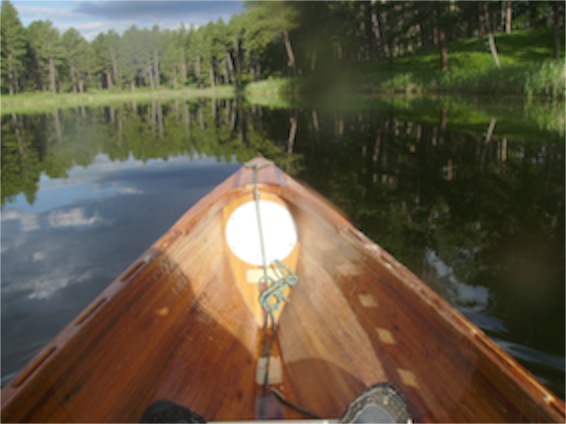 Back in 1998 I built a small cedar strip canoe from plans obtained from Mac McCarthy. It is a solo canoe and I usually use a double paddle to propel the craft like a kayak. Although it doesn’t have decks covering it, I did craft a couple of bulkheads and install them in the ends to provide a couple of air chambers and a place to store a few items. I didn’t know how to make covers for the access holes in the bulkheads, so I ordered a couple of plastic deck plates from a boating supply company. They work great and I am using a similar plate to give access to the space under the seat of the rowboat I’m building.
Back in 1998 I built a small cedar strip canoe from plans obtained from Mac McCarthy. It is a solo canoe and I usually use a double paddle to propel the craft like a kayak. Although it doesn’t have decks covering it, I did craft a couple of bulkheads and install them in the ends to provide a couple of air chambers and a place to store a few items. I didn’t know how to make covers for the access holes in the bulkheads, so I ordered a couple of plastic deck plates from a boating supply company. They work great and I am using a similar plate to give access to the space under the seat of the rowboat I’m building.
I don’t remember how I found the company from which I ordered the deck plates. I guess I just looked online, or perhaps I got a tip from another boat builder. At any rate, the place from which I ordered it is a company that specializes in selling parts and supplies to yacht racers. I ended up on their mailing list and now I get catalogues from a half dozen yacht suppliers. You might think that they would notice that I live in South Dakota and nowhere near an ocean, but they persist in sending me catalogues. I’m sure that over the years they’ve spent more money sending me catalogues than I have spent purchasing items from their companies. I’m simply not a big customer.
 The catalogues do, however, expose me to a world that is far different from anything I’ve known. A couple of the catalogues have large sections of specialty clothing. I think that there may be a couple of caps that are preferred by canoe people, but other than that, I don’t know of any specialty clothing that we wear. We’re pretty much a jeans and t-shirt crowd. I suppose you could call a wet suit or a dry suit a piece of specialty clothing, but I’ve never owned either. I usually paddle with a wind-breaker if I need a jacket and a big floppy hat to keep the sun off of my face. I do have a pretty nice pair of gloves that keep my hands dry when paddling in cold weather. That’s about it. I have a catalogue that has four or five pages of specialty shoes for yachting. There are pages of shirts and slacks and socks. And the section of fowl weather gear is impressive. I thought of finding myself a new rain jacket in one of those catalogues, but for the most part the prices are out of my range.
The catalogues do, however, expose me to a world that is far different from anything I’ve known. A couple of the catalogues have large sections of specialty clothing. I think that there may be a couple of caps that are preferred by canoe people, but other than that, I don’t know of any specialty clothing that we wear. We’re pretty much a jeans and t-shirt crowd. I suppose you could call a wet suit or a dry suit a piece of specialty clothing, but I’ve never owned either. I usually paddle with a wind-breaker if I need a jacket and a big floppy hat to keep the sun off of my face. I do have a pretty nice pair of gloves that keep my hands dry when paddling in cold weather. That’s about it. I have a catalogue that has four or five pages of specialty shoes for yachting. There are pages of shirts and slacks and socks. And the section of fowl weather gear is impressive. I thought of finding myself a new rain jacket in one of those catalogues, but for the most part the prices are out of my range.
After you get through the clothing, there is no small amount of equipment. There are the sort of things you would expect: paddles and oars, boathooks, anchors, deck hardware, paint, sealers and adhesives. One thing that surprises me is the extensive array of electronics that are available for boats. There are marine radios, GPS units, antennas and accessories, a lot of different instruments, depth sounders and more. There are radio systems for boats that cost more than the most expensive of my little boats. There are fancy antennas designed for mounting on masts and special enclosures for radar and other electronics.
I guess that none of this should surprise me. There are a lot of fancy boats in this world and fancy boats require lots of specialty items. There are plenty of people who have more money to spend on their recreational activities than I. And there are a few folks who are so caught up in yachts and yacht racing that they are willing to devote all of their resources to their sport.
For me, however, the catalogues are mostly entertainment. I enjoy paging through them from time to time just to see what kinds of things they are offering for sale. It is, however, a waste of resources to send me the catalogues. They usually end up in the recycling bin the same day they arrive. When I want to order something from one of the companies, I will go to the web site to find what I want. I don’t keep the catalogues around on the chance that I might want something that is in them. And their entertainment value is very limited for me. There are a lot of other things that I’d rather do than sit around looking at a catalogue.
 I suspect that it is a good thing that I live a long way from the ocean. Based on how much time I spend at the hardware store, I think that living near a real ship chandler would be dangerous. When I can see and handle items prior to purchase, I often discover that there are gadgets that I’d like to own. When I have traveled to the coast, I find myself in “need” of a new handsaw or a shiny brass fitting to add to one of my boats.
I suspect that it is a good thing that I live a long way from the ocean. Based on how much time I spend at the hardware store, I think that living near a real ship chandler would be dangerous. When I can see and handle items prior to purchase, I often discover that there are gadgets that I’d like to own. When I have traveled to the coast, I find myself in “need” of a new handsaw or a shiny brass fitting to add to one of my boats.
I may not be a sucker for the catalogues, but they can get me with an aisle end display or an impulse bin. I know. I have a coupon for the hardware store and nothing that I need. I may stop in on my way home from work anyway. You never know what they might have.
The canoe is sometimes called “the poor man’s yacht” and I do take pride in my boats. I enjoy paddling them and I enjoy talking about them with anyone who is interested. I don’t mind pulling up to a rest stop with a trailer with hand-made boats and striking up a conversation with some other traveler who has noticed the varnished surfaces and admires the wood grain.

I don’t remember how I found the company from which I ordered the deck plates. I guess I just looked online, or perhaps I got a tip from another boat builder. At any rate, the place from which I ordered it is a company that specializes in selling parts and supplies to yacht racers. I ended up on their mailing list and now I get catalogues from a half dozen yacht suppliers. You might think that they would notice that I live in South Dakota and nowhere near an ocean, but they persist in sending me catalogues. I’m sure that over the years they’ve spent more money sending me catalogues than I have spent purchasing items from their companies. I’m simply not a big customer.

After you get through the clothing, there is no small amount of equipment. There are the sort of things you would expect: paddles and oars, boathooks, anchors, deck hardware, paint, sealers and adhesives. One thing that surprises me is the extensive array of electronics that are available for boats. There are marine radios, GPS units, antennas and accessories, a lot of different instruments, depth sounders and more. There are radio systems for boats that cost more than the most expensive of my little boats. There are fancy antennas designed for mounting on masts and special enclosures for radar and other electronics.
I guess that none of this should surprise me. There are a lot of fancy boats in this world and fancy boats require lots of specialty items. There are plenty of people who have more money to spend on their recreational activities than I. And there are a few folks who are so caught up in yachts and yacht racing that they are willing to devote all of their resources to their sport.
For me, however, the catalogues are mostly entertainment. I enjoy paging through them from time to time just to see what kinds of things they are offering for sale. It is, however, a waste of resources to send me the catalogues. They usually end up in the recycling bin the same day they arrive. When I want to order something from one of the companies, I will go to the web site to find what I want. I don’t keep the catalogues around on the chance that I might want something that is in them. And their entertainment value is very limited for me. There are a lot of other things that I’d rather do than sit around looking at a catalogue.

I may not be a sucker for the catalogues, but they can get me with an aisle end display or an impulse bin. I know. I have a coupon for the hardware store and nothing that I need. I may stop in on my way home from work anyway. You never know what they might have.
Copyright © 2012 by Ted Huffman. I wrote this. If you want to copy it, please ask for permission. There is a contact me button at the bottom of this page. If you want to share my blog a friend, please direct your friend to my web site.
The Freedom of Music
30/05/12 05:44
My friend and mentor Ross Snyder spoke frequently of an “Ecology of Spirit.” We participate in an amazing network of relationships. Our very being is influenced and shaped by other persons. Some of the people in our ecology of spirit have been known by us personally. The influence of parents and siblings is obvious. Equally obvious is the influence of teachers. But we are also influenced by the authors of books that we have read, the politicians who set policies by which we live, and artists who shape the culture around us.
President John F. Kennedy recognized the unique and important contributions of those who shape our culture and established the Medal of Freedom. It is our nation’s highest civilian honor awarded to people from all walks of life who have made exceptional contributions to society. Previous honorees include Mother Teresa, Margaret Thatcher, Stephen Hawking, Walt Disney, Doris Day, Duke Ellington and Aretha Franklin. 13 people were honored with the award in a White House ceremony yesterday. Some of the names were not familiar to me, even though I agree that they have shaped the culture of our nation. Gordon Hirabayashi fought the internment of Japanese-Americans during World War II. He did not live to see his honor. He died in January. Jan Karski was an officer in the Polish Underground in World War II and later became a professor at Georgetown University’s School of Foreign Service. She died in 2000. William Foege is still living. He is a physician and former director of the Centers for Disease Control and Prevention who led the campaign to eradicate smallpox.
It is interesting that two of the recipients honored yesterday are well known to me, but both are known by names different than their birth names. Author Toni Morrison has written novels that tell the story of the African-American experience. She was named Chloe Anthony Wofford by her parents. I wouldn’t recognize her by that name.
Bob Dylan was born Robert Allen Zimmerman. He took his stage name from the poet Dylan Thomas. It seems appropriate when you consider how much Bob Dylan has emphasized the importance of his lyrics. He is a poet.
When I think of Bob Dylan’s music, I think of the lyrics first. His gravely voice is unique and I enjoy listening to his recordings. There are a few good guitar licks on those albums, but I won’t remember him as a guitar player.
There are other guitar players who have become part of how I understand the instrument and its music. Sadly, a lot of those great guitar players are, like some of the recipients of the Medal of Freedom, no longer living. Fortunately we have their recordings, so their music is still with us, but there will be no new albums from greats like Merle Travis, Django Reinhardt, George Barnes, Les Paul and Chet Atkins. My oh my how Chet could pick a guitar. He could make you laugh and weep at the same time as you marveled how two human hands could create such magic.
And yesterday we lost another great picker. I never lived down south and I have rarely visited there. I’ve only drive through the Blue Ridge Mountains a couple of times. But I have a sense of having visited there a lot more often because of Doc Watson’s incredible music. Bob Dylan wrote incredible songs, but if you really want them to be etched into your memory, listen to the way Doc Watson performed them. He could make folk music come alive like no one else.
But what I like most of Doc Watson’s repertoire are the old time songs. He could take a fiddle tune and play it on the guitar. He could play a traditional song like “Shady Grove” so that you’d never forget it. In a way what he did best was to play in a way that took his listeners to another time and another place. When he sang a Jimmie Rodgers yodel, I felt the pain of the Great Depression even though it happened before I was born. When he sang a Carter Family Song, I was sitting on the porch in a rural Virginia mountain home, though I’ve never lived anywhere east of Chicago.
My favorite recording of “Will the Circle be Unbroken” features Doc playing with his son Merle. Merle died in a tractor accident in 1985. Perhaps Doc’s death is the completion of the circle in a way. Perhaps they are already singing together once again. Music can do that. It can transcend the barriers of time and of place. It can transport us to places we have never been. It can reunite those separated by death.
If I were the president (don’t worry, I’m not qualified and will never be president), I think I’d award the Medal of Freedom to Leo Kottke and Ricky Skaggs while they are still alive and picking their guitars. I think the solemn White House ceremony might benefit from a little good guitar picking. As important as such ceremonies are, they do not define our culture and they do not recognize all of the important people who make up the ecology of spirit that surrounds us every day and give meaning to our lives. No matter how long the list of distinguished honorees grows, there will be always be deserving folk who don’t get publicly named.
Godspeed Doc! We’re going to miss you. We’re going to miss that great finger picking and that warm, folksy singing. Thanks for the music. In this life you were a blind man, but you were also a true visionary. Without the benefit of sight through your eyes, you added insight to your music that continues to inspire us today.
I know that there are plenty of people who think of heaven as a place filled with harps and people who know how to tune and play them. I like harp music. I like symphony orchestras. But I’m confident that somewhere in heaven there is a corner with a group of folk and their guitars, experimenting with new finger patterns and going faster and faster until the music erases the distinction between heaven and earth.
Copyright © 2012 by Ted Huffman. I wrote this. If you want to copy it, please ask for permission. There is a contact me button at the bottom of this page. If you want to share my blog a friend, please direct your friend to my web site.
President John F. Kennedy recognized the unique and important contributions of those who shape our culture and established the Medal of Freedom. It is our nation’s highest civilian honor awarded to people from all walks of life who have made exceptional contributions to society. Previous honorees include Mother Teresa, Margaret Thatcher, Stephen Hawking, Walt Disney, Doris Day, Duke Ellington and Aretha Franklin. 13 people were honored with the award in a White House ceremony yesterday. Some of the names were not familiar to me, even though I agree that they have shaped the culture of our nation. Gordon Hirabayashi fought the internment of Japanese-Americans during World War II. He did not live to see his honor. He died in January. Jan Karski was an officer in the Polish Underground in World War II and later became a professor at Georgetown University’s School of Foreign Service. She died in 2000. William Foege is still living. He is a physician and former director of the Centers for Disease Control and Prevention who led the campaign to eradicate smallpox.
It is interesting that two of the recipients honored yesterday are well known to me, but both are known by names different than their birth names. Author Toni Morrison has written novels that tell the story of the African-American experience. She was named Chloe Anthony Wofford by her parents. I wouldn’t recognize her by that name.
Bob Dylan was born Robert Allen Zimmerman. He took his stage name from the poet Dylan Thomas. It seems appropriate when you consider how much Bob Dylan has emphasized the importance of his lyrics. He is a poet.
When I think of Bob Dylan’s music, I think of the lyrics first. His gravely voice is unique and I enjoy listening to his recordings. There are a few good guitar licks on those albums, but I won’t remember him as a guitar player.
There are other guitar players who have become part of how I understand the instrument and its music. Sadly, a lot of those great guitar players are, like some of the recipients of the Medal of Freedom, no longer living. Fortunately we have their recordings, so their music is still with us, but there will be no new albums from greats like Merle Travis, Django Reinhardt, George Barnes, Les Paul and Chet Atkins. My oh my how Chet could pick a guitar. He could make you laugh and weep at the same time as you marveled how two human hands could create such magic.
And yesterday we lost another great picker. I never lived down south and I have rarely visited there. I’ve only drive through the Blue Ridge Mountains a couple of times. But I have a sense of having visited there a lot more often because of Doc Watson’s incredible music. Bob Dylan wrote incredible songs, but if you really want them to be etched into your memory, listen to the way Doc Watson performed them. He could make folk music come alive like no one else.
But what I like most of Doc Watson’s repertoire are the old time songs. He could take a fiddle tune and play it on the guitar. He could play a traditional song like “Shady Grove” so that you’d never forget it. In a way what he did best was to play in a way that took his listeners to another time and another place. When he sang a Jimmie Rodgers yodel, I felt the pain of the Great Depression even though it happened before I was born. When he sang a Carter Family Song, I was sitting on the porch in a rural Virginia mountain home, though I’ve never lived anywhere east of Chicago.
My favorite recording of “Will the Circle be Unbroken” features Doc playing with his son Merle. Merle died in a tractor accident in 1985. Perhaps Doc’s death is the completion of the circle in a way. Perhaps they are already singing together once again. Music can do that. It can transcend the barriers of time and of place. It can transport us to places we have never been. It can reunite those separated by death.
If I were the president (don’t worry, I’m not qualified and will never be president), I think I’d award the Medal of Freedom to Leo Kottke and Ricky Skaggs while they are still alive and picking their guitars. I think the solemn White House ceremony might benefit from a little good guitar picking. As important as such ceremonies are, they do not define our culture and they do not recognize all of the important people who make up the ecology of spirit that surrounds us every day and give meaning to our lives. No matter how long the list of distinguished honorees grows, there will be always be deserving folk who don’t get publicly named.
Godspeed Doc! We’re going to miss you. We’re going to miss that great finger picking and that warm, folksy singing. Thanks for the music. In this life you were a blind man, but you were also a true visionary. Without the benefit of sight through your eyes, you added insight to your music that continues to inspire us today.
I know that there are plenty of people who think of heaven as a place filled with harps and people who know how to tune and play them. I like harp music. I like symphony orchestras. But I’m confident that somewhere in heaven there is a corner with a group of folk and their guitars, experimenting with new finger patterns and going faster and faster until the music erases the distinction between heaven and earth.
Copyright © 2012 by Ted Huffman. I wrote this. If you want to copy it, please ask for permission. There is a contact me button at the bottom of this page. If you want to share my blog a friend, please direct your friend to my web site.
Cycle thoughts
29/05/12 05:58
My brother is a self-proclaimed bike activist. He has covered tens of thousands of miles riding bicycles and promotes the bicycle as his preferred method of personal transportation. He has made several trans-continental trips on bicycles and this week left Atlanta, Georgia heading toward the Pacific Northwest. He may be coming through Rapid City on this trip. He is riding several “rails to trails” trails on this trip and the 109-mile Mickelson Trail at our end of South Dakota has caught his eye.
I enjoy riding my bicycle for fun and exercise, but haven’t begun to think of using it for long trips. This week is the third week of a four-week stretch in which I will drive a thousand miles. Two weeks ago, I taught in Hastings Nebraska. Last week, I went to Big Timber, Montana. This week I have the annual meeting of the South Dakota Conference in Aberdeen. Next week I return to Hastings for a second round of teaching. A bicycle just isn’t the solution to my particular lifestyle.
Of course my brother would question my lifestyle and ask if all of those trips are truly necessary. Being brothers certainly doesn’t make us the same.
 I wonder if my brother caught the story about Felix Gircia, who made an eleven-foot tall bicycle that he rides around Havana, Cuba. Gircia has received so much attention for the vehicle that he is currently working on an even taller bike. The new bike will be 5.5 meters (18 feet) tall when it is finished. It takes two assistants for Gircia to climb up the bicycle. I assume that it takes a couple of assistants for him to stop as well. Perhaps he will be able to develop a technique for starting and stopping by leaning the bike against a building. At any rate he can certainly capture people’s attention as he rides by.
I wonder if my brother caught the story about Felix Gircia, who made an eleven-foot tall bicycle that he rides around Havana, Cuba. Gircia has received so much attention for the vehicle that he is currently working on an even taller bike. The new bike will be 5.5 meters (18 feet) tall when it is finished. It takes two assistants for Gircia to climb up the bicycle. I assume that it takes a couple of assistants for him to stop as well. Perhaps he will be able to develop a technique for starting and stopping by leaning the bike against a building. At any rate he can certainly capture people’s attention as he rides by.
 Meanwhile, at the Union Cycliste Internationale velodrome in Aigle, Switzerland, Robert Marchand of France set a new world record on Friday. He covered a distance of 24.251 meters (about 15 miles) in an hour. That doesn’t sound like a very fast ride, until you understand that Marchand is now the record holder for the most distance covered in one hour on a bicycle for persons over the age of 100 years. I’m pretty sure that if I can ride a bike at all at the age of 100 I’ll be pleased.
Meanwhile, at the Union Cycliste Internationale velodrome in Aigle, Switzerland, Robert Marchand of France set a new world record on Friday. He covered a distance of 24.251 meters (about 15 miles) in an hour. That doesn’t sound like a very fast ride, until you understand that Marchand is now the record holder for the most distance covered in one hour on a bicycle for persons over the age of 100 years. I’m pretty sure that if I can ride a bike at all at the age of 100 I’ll be pleased.
 It took more than 100,000 cyclists to set the record for the world’s largest bicycle parade. Starting from 1,000 official checkpoints around the country of Taiwan, each person rode for about three miles. The riding might not have been that impressive, but the organization required to get the entry into the Guinness Book of World Records was pretty impressive.
It took more than 100,000 cyclists to set the record for the world’s largest bicycle parade. Starting from 1,000 official checkpoints around the country of Taiwan, each person rode for about three miles. The riding might not have been that impressive, but the organization required to get the entry into the Guinness Book of World Records was pretty impressive.
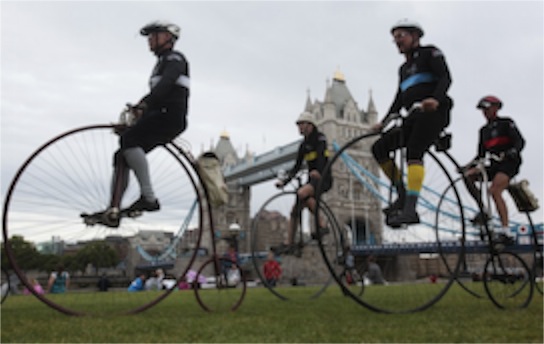 June is the month when the riders of Penny-farthings gather in London each year. These bicycles were the norm in the 1800’s in Europe. Before the invention of bicycles with chains and gears, the way to increase the speed of a bicycle was to increase the size of the wheel that had the pedals. There was, of course a limit to the size of the wheel because riders have limits to the length of their legs. Actually the high wheeled bicycles had a relatively short run in history. The first such bikes appeared around 1870. Bicycles with chains and gears appeared in the late 1890’s. The direct-pedal bicycles enjoyed about two decades of popularity in the United States after Albert Pope began manufacturing the Columbia bicycle near Boston.
June is the month when the riders of Penny-farthings gather in London each year. These bicycles were the norm in the 1800’s in Europe. Before the invention of bicycles with chains and gears, the way to increase the speed of a bicycle was to increase the size of the wheel that had the pedals. There was, of course a limit to the size of the wheel because riders have limits to the length of their legs. Actually the high wheeled bicycles had a relatively short run in history. The first such bikes appeared around 1870. Bicycles with chains and gears appeared in the late 1890’s. The direct-pedal bicycles enjoyed about two decades of popularity in the United States after Albert Pope began manufacturing the Columbia bicycle near Boston.
 Here is a picture of a way to gain increased speed on a bicycle. The picture by the Associated Press was taken in Pakistan. It probably takes a bit of skill to ride the motorcycle with the possibility of uneven forces caused by a bicycle on each side. But the real challenge, I think, must be for the bicycle riders, who have to steer with one hand and hold the rope with the other while balancing a loaded bicycle. The article accompanying the picture doesn’t say how fast they were going. I suspect this mode of transportation isn’t for the fainthearted.
Here is a picture of a way to gain increased speed on a bicycle. The picture by the Associated Press was taken in Pakistan. It probably takes a bit of skill to ride the motorcycle with the possibility of uneven forces caused by a bicycle on each side. But the real challenge, I think, must be for the bicycle riders, who have to steer with one hand and hold the rope with the other while balancing a loaded bicycle. The article accompanying the picture doesn’t say how fast they were going. I suspect this mode of transportation isn’t for the fainthearted.
 As long as I am on the subject of bicycles, the issue of how to carry one’s luggage is always one to consider. I have been hauling a considerable amount of things with me as I travel these weeks. When I teach, I have books and other supplies. I always travel with a computer these days. And there is the matter of my clothing and other personal items. The cyclist in this picture has come up with a solution, but it doesn’t seem to be quite the perfect way to carry one’s luggage. The picture came from the European Press Agency and was taken by Dominic Favre. The cyclist is not identified, but the picture was taken before the start of a cycle race in Martigny, Switzerland.
As long as I am on the subject of bicycles, the issue of how to carry one’s luggage is always one to consider. I have been hauling a considerable amount of things with me as I travel these weeks. When I teach, I have books and other supplies. I always travel with a computer these days. And there is the matter of my clothing and other personal items. The cyclist in this picture has come up with a solution, but it doesn’t seem to be quite the perfect way to carry one’s luggage. The picture came from the European Press Agency and was taken by Dominic Favre. The cyclist is not identified, but the picture was taken before the start of a cycle race in Martigny, Switzerland.
The bicycle is a wonderfully elegant invention that continues to be a very good method of transportation for many people. It provides the freedom of individual transportation within at an affordable price. Well-made bicycles last for a very long time and maintenance is easy. The environmental impact of a bicycle is very light compared to an automobile. Other than the resources required for their manufacture, they consume no additional fuel as they carry about their owners. In a country where most of us are overweight they offer the added advantage of healthy exercise.
It is certainly true that I could be riding a bicycle more than I do. And I could be driving a car less than I do. Both would be good for me and good for the world in which I live. Having said that, it seems unlikely that I will be making a total switch away from driving in the next few weeks. I’m not in shape for a thousand miles a week on a bicycle, and my schedule is too filled with other activities to make time for riding long distances.
I enjoy riding my bicycle for fun and exercise, but haven’t begun to think of using it for long trips. This week is the third week of a four-week stretch in which I will drive a thousand miles. Two weeks ago, I taught in Hastings Nebraska. Last week, I went to Big Timber, Montana. This week I have the annual meeting of the South Dakota Conference in Aberdeen. Next week I return to Hastings for a second round of teaching. A bicycle just isn’t the solution to my particular lifestyle.
Of course my brother would question my lifestyle and ask if all of those trips are truly necessary. Being brothers certainly doesn’t make us the same.






The bicycle is a wonderfully elegant invention that continues to be a very good method of transportation for many people. It provides the freedom of individual transportation within at an affordable price. Well-made bicycles last for a very long time and maintenance is easy. The environmental impact of a bicycle is very light compared to an automobile. Other than the resources required for their manufacture, they consume no additional fuel as they carry about their owners. In a country where most of us are overweight they offer the added advantage of healthy exercise.
It is certainly true that I could be riding a bicycle more than I do. And I could be driving a car less than I do. Both would be good for me and good for the world in which I live. Having said that, it seems unlikely that I will be making a total switch away from driving in the next few weeks. I’m not in shape for a thousand miles a week on a bicycle, and my schedule is too filled with other activities to make time for riding long distances.
Copyright © 2012 by Ted Huffman. I wrote this. If you want to copy it, please ask for permission. There is a contact me button at the bottom of this page. If you want to share my blog a friend, please direct your friend to my web site.
Family and work
28/05/12 04:19
I was blessed with a wonderful family in which to grow up. My parents delighted in their children and worked hard to make our growing up years times of adventure and learning in a safe and secure environment. My parents adopted before they had children born to them and then adopted at the other end of our family as well, so we were spread out. My oldest sister was out on her own before I have active memories. Before my third birthday she was a mother, so we grew up in a jumble of nieces and nephews along with brothers and sisters.
Hospitality was important in our household. We knew that our friends were always welcome at our home. Our parents also invited in international guests, people from the college, visiting pastors, some of the salesmen who came to our shop and a lot of other people. My dad enjoyed inviting anyone who was around home for dinner, which at our home was the noon meal. There was always room for another.
This has resulted in fairly complex dynamics for us now that we are adults. We all have special memories of our growing up years, our home and the objects that it contains. We all have friends who have their own memories of the place.
Because of the patterns of grief, we are constantly at different stages in our grieving. All but one of the surviving brothers and sisters have gathered for this weekend, but we have never been all together at the same time. The remaining brother, who is traveling by bicycle from Atlanta, Georgia has called and communicated by e-mail during the weekend. There have been various nieces, nephews, grand nieces and grand nephews who have added to the joy of a family gathering.
One thing about it: there is no shortage of mementoes for each person to take home. Given the complexity of the family, even the mementoes are complex. For example, as we were cleaning out the shop, I came across my paternal grandfather’s toolbox. There were several tools and inventions from our great Uncle Ted, whose name I inherited. He was a skilled sheet metal worker and a person who never threw anything away. He made all kinds of useful everyday items out of things that others would have considered to be junk. I am coming home with a few things from him, though I already have a few of his tools in my toolbox.
I spent a large part of a day sorting books. The love of books seems to run rampant in our family. There are some real treasures. I have a couple of boxes of relatively unique books of Montana History and books by Montana authors. I already had a pretty good collection of such books, and I carefully avoided bringing home any duplicates. Still there were a lot of titles that I have not read.
In the process of sorting, we found that different things set off different emotions in each of us. Grief is like that. It takes you by surprise. We all noted that a little bit of anger helped us accomplish more work. Too much anger, however, paralyzes a person and makes it hard to get anything done. And there has been plenty of laughter and silliness as we worked together.
Our parents, it seems, did a pretty good job of teaching us the value of working together. But this business of being a family takes time. These days we come from different communities, different work styles and settings and different occupations. We have to re-learn how to divide responsibilities, check out lines of communication, remember sensitivities and sometimes tiptoe around sensitive feelings. We find we have different memories of the past, value different aspects of our story and carry different things from our growing-up years into the future.
In other words, we are a typical family. The families of the church I serve have similar complexities, similar differences, and similar issues to sort through. In a way, I’m more used to the dynamics of adjusting to others in the context of complex relationships than are my siblings. To the extent that this is true, spending a few days with my family of origin is a lot more like the work I do in my everyday life than a vacation. I’ve been aware of this for many years. When I plan my time off from my job, I need to keep in mind my need for solitude and separation as well as my need to spend time with family, maintain good relationships and clear channels of communication. As I have ended each day, I have been exhausted – as tired as I get when I have a long day at work. My sisters have noticed and commented about how tired I look.
I know that others face similar dilemmas in their lives. I remember the conversations I had with the family of a mechanic as we were planning his funeral. The family told several stories of how he would come home from work, eat a quick supper and spend the evening repairing cars for his kids. They had stories of a family vacation where he had to rent a shop with a lift partway through a vacation to rebuild the rear end of the family car.
There may be a few jobs where there is a clear-cut distinction between working and time off, but in many professions, the work comes home and the home life is carried with one into the workplace. Effective boundaries are necessary and important, but they are very difficult to maintain. That is why boundary training must be repeated regularly in order to be effective.
Sabbath is more than the practice of taking a day off from work. It is a spiritual discipline of balancing the complexities of life. Work must be offset with rest. Community must be balanced with the needs for intimacy and solitude. Speaking must provide opportunities for listening. Like other spiritual disciplines, it takes practice. We don’t always get it right on the first attempt. But as we mature, if we are attentive to the discipline, we learn how to find the time for the things that are the most important.
Today I will be given the gift of space. Because my family home is over 400 miles from my current residence, I will spend the better part of today driving. It is beautiful country and we’ve had several days of rain to bring freshness to the land. I will see new things as I drive that I have never before noticed. I will have quiet time to reflect on the time I have spent here and the challenges that await me at home.
With a little prayer and a little discipline I should awaken tomorrow ready to face a new day as pastor of a wonderful congregation grateful for the varieties of personalities and eager to participate fully in the building of our future together.
Hospitality was important in our household. We knew that our friends were always welcome at our home. Our parents also invited in international guests, people from the college, visiting pastors, some of the salesmen who came to our shop and a lot of other people. My dad enjoyed inviting anyone who was around home for dinner, which at our home was the noon meal. There was always room for another.
This has resulted in fairly complex dynamics for us now that we are adults. We all have special memories of our growing up years, our home and the objects that it contains. We all have friends who have their own memories of the place.
Because of the patterns of grief, we are constantly at different stages in our grieving. All but one of the surviving brothers and sisters have gathered for this weekend, but we have never been all together at the same time. The remaining brother, who is traveling by bicycle from Atlanta, Georgia has called and communicated by e-mail during the weekend. There have been various nieces, nephews, grand nieces and grand nephews who have added to the joy of a family gathering.
One thing about it: there is no shortage of mementoes for each person to take home. Given the complexity of the family, even the mementoes are complex. For example, as we were cleaning out the shop, I came across my paternal grandfather’s toolbox. There were several tools and inventions from our great Uncle Ted, whose name I inherited. He was a skilled sheet metal worker and a person who never threw anything away. He made all kinds of useful everyday items out of things that others would have considered to be junk. I am coming home with a few things from him, though I already have a few of his tools in my toolbox.
I spent a large part of a day sorting books. The love of books seems to run rampant in our family. There are some real treasures. I have a couple of boxes of relatively unique books of Montana History and books by Montana authors. I already had a pretty good collection of such books, and I carefully avoided bringing home any duplicates. Still there were a lot of titles that I have not read.
In the process of sorting, we found that different things set off different emotions in each of us. Grief is like that. It takes you by surprise. We all noted that a little bit of anger helped us accomplish more work. Too much anger, however, paralyzes a person and makes it hard to get anything done. And there has been plenty of laughter and silliness as we worked together.
Our parents, it seems, did a pretty good job of teaching us the value of working together. But this business of being a family takes time. These days we come from different communities, different work styles and settings and different occupations. We have to re-learn how to divide responsibilities, check out lines of communication, remember sensitivities and sometimes tiptoe around sensitive feelings. We find we have different memories of the past, value different aspects of our story and carry different things from our growing-up years into the future.
In other words, we are a typical family. The families of the church I serve have similar complexities, similar differences, and similar issues to sort through. In a way, I’m more used to the dynamics of adjusting to others in the context of complex relationships than are my siblings. To the extent that this is true, spending a few days with my family of origin is a lot more like the work I do in my everyday life than a vacation. I’ve been aware of this for many years. When I plan my time off from my job, I need to keep in mind my need for solitude and separation as well as my need to spend time with family, maintain good relationships and clear channels of communication. As I have ended each day, I have been exhausted – as tired as I get when I have a long day at work. My sisters have noticed and commented about how tired I look.
I know that others face similar dilemmas in their lives. I remember the conversations I had with the family of a mechanic as we were planning his funeral. The family told several stories of how he would come home from work, eat a quick supper and spend the evening repairing cars for his kids. They had stories of a family vacation where he had to rent a shop with a lift partway through a vacation to rebuild the rear end of the family car.
There may be a few jobs where there is a clear-cut distinction between working and time off, but in many professions, the work comes home and the home life is carried with one into the workplace. Effective boundaries are necessary and important, but they are very difficult to maintain. That is why boundary training must be repeated regularly in order to be effective.
Sabbath is more than the practice of taking a day off from work. It is a spiritual discipline of balancing the complexities of life. Work must be offset with rest. Community must be balanced with the needs for intimacy and solitude. Speaking must provide opportunities for listening. Like other spiritual disciplines, it takes practice. We don’t always get it right on the first attempt. But as we mature, if we are attentive to the discipline, we learn how to find the time for the things that are the most important.
Today I will be given the gift of space. Because my family home is over 400 miles from my current residence, I will spend the better part of today driving. It is beautiful country and we’ve had several days of rain to bring freshness to the land. I will see new things as I drive that I have never before noticed. I will have quiet time to reflect on the time I have spent here and the challenges that await me at home.
With a little prayer and a little discipline I should awaken tomorrow ready to face a new day as pastor of a wonderful congregation grateful for the varieties of personalities and eager to participate fully in the building of our future together.
Copyright © 2012 by Ted Huffman. I wrote this. If you want to copy it, please ask for permission. There is a contact me button at the bottom of this page. If you want to share my blog a friend, please direct your friend to my web site.
Pentecost, 2012
27/05/12 04:40
It is Pentecost. 50 days after Easter comes the celebration of the gift of the Holy Spirit. The book of Acts reports that tongues as of fire came to rest on the head of each person who was in attendance at that first Pentecost. The symbol of the United Methodist Church includes a flame as a reminder of the power and presence of the Holy Spirit in the contemporary church.
 The traditions of the church also depict fire as a sign of God’s punishment. Based perhaps more on Dante’s Inferno than on Biblical texts, the image of hell that is in the minds of most Christians involves flames, fire and burning. This may also arise from the amount of pain that is associated with receiving a burn. Knowing how much it hurts to have a burn on one tiny part of one’s body, anyone with a bit of imagination can picture and fear the image of being burned all over.
The traditions of the church also depict fire as a sign of God’s punishment. Based perhaps more on Dante’s Inferno than on Biblical texts, the image of hell that is in the minds of most Christians involves flames, fire and burning. This may also arise from the amount of pain that is associated with receiving a burn. Knowing how much it hurts to have a burn on one tiny part of one’s body, anyone with a bit of imagination can picture and fear the image of being burned all over.
Still, fire is a pretty good image for the Holy Spirit. It cannot be controlled. It moves with a pattern that is unique and different from anything else ever experienced.
The scriptures teach that the gift of Pentecost is the gift of proclamation. The disciples had convened a wonderfully diverse multi-racial, multi-cultural, multi-lingual group of persons and on Pentecost they discovered a way to clearly communicate the message of the resurrection of Jesus Christ. They found words that others could understand, regardless of the languages of their origin. It was amazing, miraculous and left behind a story that is worth telling every year.
This year Pentecost lands on Memorial weekend. It is a time that we associate with the beginning of summer. It is time to fertilize the lawn, make sure you have the right stickers on the car for our favorite vacation destinations and head out for camping, boating, bicycling and other outdoor fun.
Memorial Day has another side to it, however. It isn’t just a weekend for camping. It is a holiday for remembering. Our modern Memorial Day observance grew out of a dark time in the story of our nation. The country was feeling deeply the grief of a bloody civil war in which brother had fought against brother, neighbor against neighbor. And the losses had been brutal. After the defeat of the rebel army, the time came for the nation to begin to heal the wounds of such a devastating war. Part of the healing came in the simple need to tell the trough and mourn the losses that had been sustained. It was decided that one way to honor the sacrifices of both sides in the war was to place simple decorations on the graves of those who had been lost. This was a way for the survivors to enter into the process of grief and experience how grief reaches beyond the boundaries of war.
Decoration day might have kept its original meaning had it not been for subsequent wars. The 20th century racked up an incredible list of major wars that involved all parts of the world. The numbers of the dead grew. The ones who needed to be remembered became greater and greater.
My friend Art was telling us yesterday of the volunteer activities of his American Legion Post. He can remember when there were plenty of volunteers to place small American Flags on the graves of each veteran. As the years passed, more and more of the veterans died. These days there are a lot fewer volunteers and a lot more graves in need of flags.
 Maybe is it appropriate for the weekend to be gray and rainy and cold. Gray days seem to go with the spirit of grief. We know that it is Pentecost. We know that it is the official start of the summer, but the grief that we feel is real. I have been thinking of a family who just lost their soldier son. He was a brilliant young man who had seen terrible combat duty in both Iraq and Afghanistan. He came home safely from his deployments, but died after h is return. His war wounds were not visible, but they were real nonetheless. The pain of his loss is still fresh with the family. They can’t predict which things will set off intense emotional outbursts. They don’t trust their feelings or their behavior. Some days it feels as if the grief will take over everything in their lives.
Maybe is it appropriate for the weekend to be gray and rainy and cold. Gray days seem to go with the spirit of grief. We know that it is Pentecost. We know that it is the official start of the summer, but the grief that we feel is real. I have been thinking of a family who just lost their soldier son. He was a brilliant young man who had seen terrible combat duty in both Iraq and Afghanistan. He came home safely from his deployments, but died after h is return. His war wounds were not visible, but they were real nonetheless. The pain of his loss is still fresh with the family. They can’t predict which things will set off intense emotional outbursts. They don’t trust their feelings or their behavior. Some days it feels as if the grief will take over everything in their lives.
They must not stand alone this Memorial Day. As they remember this courageous and talented young man they need others to stand with them. As they face the pain of their loss, they must know of our support. They have no need for fancy sermons or patriotic speeches this weekend. They have no room for the pontifications of politicians. Their grief is raw enough that they prefer to be private with their emotions. And for that no one can blame them.
Their Memorial Day weekend promises to be gray regardless of the weather.
 I can take the weather of Montana. I’ve been around enough to have seen fresh snowfall in every month of the year. I’ve had more than a few family vacations that have ended up dampened by rain, and chilled by below-average temperatures. I can take it. I’ve got the clothes for this kind of weather.
I can take the weather of Montana. I’ve been around enough to have seen fresh snowfall in every month of the year. I’ve had more than a few family vacations that have ended up dampened by rain, and chilled by below-average temperatures. I can take it. I’ve got the clothes for this kind of weather.
Part of me wishes that I could remember exactly what it feels like to be cold just so that I could recall that memory on one of the hot August days when I an so superheated that I won’t be able to remember the cold.
Here is the important thing to remember. The weather will change. It will not always be the same as it is today. It is not a mistake that Pentecost is the longest season of the Christian calendar. The Holy Spirit cannot be contained to a single day’s celebration. We know we’ll see some sunshine and warmth during this season. We’ll even come to days when we will wish and pray for rain, as impossible as that seems today.
 So enjoy this Pentecost day. Wear red and celebrate from the core of your spirit. And if you are feeling blue and wearing gray, do not fear. This season has patience enough to wait for your genuine joy. For the day will come when you discover the joy that no one can take away. It is as certain as the coming of Pentecost and Memorial Day. It may not be possible to say when, but we know that there is more that is coming. And on that day your joy will be complete.
So enjoy this Pentecost day. Wear red and celebrate from the core of your spirit. And if you are feeling blue and wearing gray, do not fear. This season has patience enough to wait for your genuine joy. For the day will come when you discover the joy that no one can take away. It is as certain as the coming of Pentecost and Memorial Day. It may not be possible to say when, but we know that there is more that is coming. And on that day your joy will be complete.

Still, fire is a pretty good image for the Holy Spirit. It cannot be controlled. It moves with a pattern that is unique and different from anything else ever experienced.
The scriptures teach that the gift of Pentecost is the gift of proclamation. The disciples had convened a wonderfully diverse multi-racial, multi-cultural, multi-lingual group of persons and on Pentecost they discovered a way to clearly communicate the message of the resurrection of Jesus Christ. They found words that others could understand, regardless of the languages of their origin. It was amazing, miraculous and left behind a story that is worth telling every year.
This year Pentecost lands on Memorial weekend. It is a time that we associate with the beginning of summer. It is time to fertilize the lawn, make sure you have the right stickers on the car for our favorite vacation destinations and head out for camping, boating, bicycling and other outdoor fun.
Memorial Day has another side to it, however. It isn’t just a weekend for camping. It is a holiday for remembering. Our modern Memorial Day observance grew out of a dark time in the story of our nation. The country was feeling deeply the grief of a bloody civil war in which brother had fought against brother, neighbor against neighbor. And the losses had been brutal. After the defeat of the rebel army, the time came for the nation to begin to heal the wounds of such a devastating war. Part of the healing came in the simple need to tell the trough and mourn the losses that had been sustained. It was decided that one way to honor the sacrifices of both sides in the war was to place simple decorations on the graves of those who had been lost. This was a way for the survivors to enter into the process of grief and experience how grief reaches beyond the boundaries of war.
Decoration day might have kept its original meaning had it not been for subsequent wars. The 20th century racked up an incredible list of major wars that involved all parts of the world. The numbers of the dead grew. The ones who needed to be remembered became greater and greater.
My friend Art was telling us yesterday of the volunteer activities of his American Legion Post. He can remember when there were plenty of volunteers to place small American Flags on the graves of each veteran. As the years passed, more and more of the veterans died. These days there are a lot fewer volunteers and a lot more graves in need of flags.

They must not stand alone this Memorial Day. As they remember this courageous and talented young man they need others to stand with them. As they face the pain of their loss, they must know of our support. They have no need for fancy sermons or patriotic speeches this weekend. They have no room for the pontifications of politicians. Their grief is raw enough that they prefer to be private with their emotions. And for that no one can blame them.
Their Memorial Day weekend promises to be gray regardless of the weather.

Part of me wishes that I could remember exactly what it feels like to be cold just so that I could recall that memory on one of the hot August days when I an so superheated that I won’t be able to remember the cold.
Here is the important thing to remember. The weather will change. It will not always be the same as it is today. It is not a mistake that Pentecost is the longest season of the Christian calendar. The Holy Spirit cannot be contained to a single day’s celebration. We know we’ll see some sunshine and warmth during this season. We’ll even come to days when we will wish and pray for rain, as impossible as that seems today.

Copyright © 2012 by Ted Huffman. I wrote this. If you want to copy it, please ask for permission. There is a contact me button at the bottom of this page. If you want to share my blog a friend, please direct your friend to my web site.
Songs I have sung
26/05/12 02:46
I know that Hank Harris doesn’t sing it this way in the Deadwood Songbook, but the way I learned the song, the words are like this:
A cattle trail drunk and a hard road to travel,
That old Jack O’ Diamonds is a hard card to play.
Get along, get along, get along little doggies,
Get along little doggies and be on your way.
Whoop-ee-ti-yi-yo! Get along little doggies,
It’s your misfortune and none of my own.
Whoop-ee-ti-yi-yo! Get along little doggies,
You know that Montana will be your new home.
There are more verses, but the key three syllable word in the chorus is “Montana” and not “Wyoming” when the song is sung in the grade schools of my home state. The great cattle drives of the late 19th Century brought stock all the way from Texas to Montana to provide food for the miners during the gold rush days. They were Texas Longhorns and they were sturdy critters, even though the losses on the long trail drives were significant. Even more were lost during some of the harsh Montana winters. Those sturdy beasts could take the -30 temperatures with the wind blowing as long as they could find a little shelter, but when the drifts got so deep that they were cut off from feed, they couldn’t maintain their body temperatures without eating.
There are other songs that I memorized as well. You can sing along if you’d like. This one adds the same chorus as above but you’ve got to really yodel on the Whoope-ee-ti-yi-yo:
My home’s in Montana
I wear a bandanna
My spurs are of silver
My pony is gray
When riding the ranges,
My luck never changes,
My foot in the stirrup
I gallop away
All together, now:
Whoop-ee-ti-yi-yo! Get along little doggies,
It’s your misfortune and none of my own.
Whoop-ee-ti-yi-yo! Get along little doggies,
You know that Montana will be your new home.
And when I was six or seven, we could really get to giggling by singing the song this way:
My home’s in Montana
I wear a banana
My spurs give me slivers
My pony is gay
When riding the ranges,
My luck never changes,
My foot in the syrup
I gallop away!
Even louder this time:
Whoop-ee-ti-yi-yo! Get along little froggies,
It’s your misspelling and none of my own.
Whoop-ee-ti-yi-yo! Get along little froggies,
Just hop to Montana and you’ll be wind blown.
 You get the idea. So It seems perfectly natural to me that when I ran up to town to pick up some packing boxes yesterday morning I spotted a motor home with a really big set of longhorns on the front. That motor home sports Montana plates with county number 40. That’s Sweetgrass County – the county of my birth and growing up years. It isn’t every county where the mascot of the high school teams is the Sheepherder. It isn’t every county that has a rifle range in the basement because target shooting is one of the extra-curricular activities of the school. I might not have gotten the best grades in high school, but I did get an education that was, well, unique.
You get the idea. So It seems perfectly natural to me that when I ran up to town to pick up some packing boxes yesterday morning I spotted a motor home with a really big set of longhorns on the front. That motor home sports Montana plates with county number 40. That’s Sweetgrass County – the county of my birth and growing up years. It isn’t every county where the mascot of the high school teams is the Sheepherder. It isn’t every county that has a rifle range in the basement because target shooting is one of the extra-curricular activities of the school. I might not have gotten the best grades in high school, but I did get an education that was, well, unique.
I know that I no longer fit in here in my old hometown. From my point of view, a whole lot of the people who now live here are latecomers. You could have lived here for 40 years and not known that I once lived here. Only the old timers remember when 500 McLeod was home to four rather rambunctious boys and the oldest two were darn hard to tell apart. They don’t remember when the airport was run by Sky Flight, Incorporated and the silver twin beech was an air ambulance that took burn patients to Galveston and brain injured patients to Mayo Clinic. They can’t remember when Big Timber Farm Supply was known as “The Store with the Plow on the Roof” and sported a feed warehouse where the roof was supported by trusses made from 2 x 2’s because that was what was most affordable at the time. It takes a lot of 2 x 2’s to create the pattern of triangles to support the snow loads we get in this town.
But people don’t remember those things any more.
There are a couple of things that I’m just as glad they don’t remember. Like the time when a couple of boys, who will remain unnamed, because to this day they have remained un-caught, climbed up into the spruce trees in front of the library with water balloons. I’m pretty sure that they no longer tell the story of the day someone (also unnamed) stole the light bar off of the police car and set it up on a couple of sawhorses in the middle of main street. Then they went back and “borrowed” the battery from the same car to make the lights flash.
Life is different these days, but I think there may still be a bit of the “Whoop-ee-ty-yi-yo in the old guy, yet.
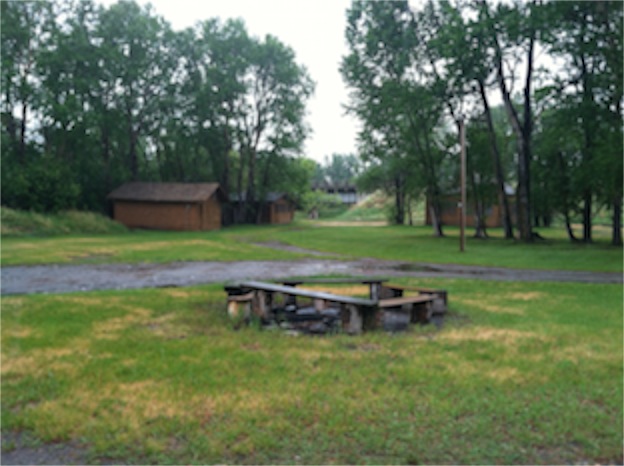 We have been sifting and sorting memories as we pack boxes and meet with the realtor. We’ve found pictures that recalled to us how we dressed in the 1960’s. “You really went out in public wearing that?!” We’ve shared stories that are differently remembered, depending on who tells them. We’ve giggled ourselves silly over some of the pictures in the old albums.
We have been sifting and sorting memories as we pack boxes and meet with the realtor. We’ve found pictures that recalled to us how we dressed in the 1960’s. “You really went out in public wearing that?!” We’ve shared stories that are differently remembered, depending on who tells them. We’ve giggled ourselves silly over some of the pictures in the old albums.
Developmental psychologists call the task “integration.” It is essential for adults to sift and sort the stories of their lives and form a meaningful pattern in order for them to enter into maturity. I guess that this type of re-living our childhood is a way of growing up. Sorting through our parents’ possessions does have its own kind of lessons. It is hard but worthy work for us as we face our own mortality and ponder the vast amounts of things we have accumulated over the years.
So, I was wondering if Hank Harris knows the “ real” words to another song that I think is on his album:
Amazing Grace, o what great fun
To play a joke on Grace!
How precious was the look on her face.
The hour I first yelled “Boo!”
OK that one still needs some work. You don’t want to hear our alternative words to “Blessed Quietness.”
A cattle trail drunk and a hard road to travel,
That old Jack O’ Diamonds is a hard card to play.
Get along, get along, get along little doggies,
Get along little doggies and be on your way.
Whoop-ee-ti-yi-yo! Get along little doggies,
It’s your misfortune and none of my own.
Whoop-ee-ti-yi-yo! Get along little doggies,
You know that Montana will be your new home.
There are more verses, but the key three syllable word in the chorus is “Montana” and not “Wyoming” when the song is sung in the grade schools of my home state. The great cattle drives of the late 19th Century brought stock all the way from Texas to Montana to provide food for the miners during the gold rush days. They were Texas Longhorns and they were sturdy critters, even though the losses on the long trail drives were significant. Even more were lost during some of the harsh Montana winters. Those sturdy beasts could take the -30 temperatures with the wind blowing as long as they could find a little shelter, but when the drifts got so deep that they were cut off from feed, they couldn’t maintain their body temperatures without eating.
There are other songs that I memorized as well. You can sing along if you’d like. This one adds the same chorus as above but you’ve got to really yodel on the Whoope-ee-ti-yi-yo:
My home’s in Montana
I wear a bandanna
My spurs are of silver
My pony is gray
When riding the ranges,
My luck never changes,
My foot in the stirrup
I gallop away
All together, now:
Whoop-ee-ti-yi-yo! Get along little doggies,
It’s your misfortune and none of my own.
Whoop-ee-ti-yi-yo! Get along little doggies,
You know that Montana will be your new home.
And when I was six or seven, we could really get to giggling by singing the song this way:
My home’s in Montana
I wear a banana
My spurs give me slivers
My pony is gay
When riding the ranges,
My luck never changes,
My foot in the syrup
I gallop away!
Even louder this time:
Whoop-ee-ti-yi-yo! Get along little froggies,
It’s your misspelling and none of my own.
Whoop-ee-ti-yi-yo! Get along little froggies,
Just hop to Montana and you’ll be wind blown.

I know that I no longer fit in here in my old hometown. From my point of view, a whole lot of the people who now live here are latecomers. You could have lived here for 40 years and not known that I once lived here. Only the old timers remember when 500 McLeod was home to four rather rambunctious boys and the oldest two were darn hard to tell apart. They don’t remember when the airport was run by Sky Flight, Incorporated and the silver twin beech was an air ambulance that took burn patients to Galveston and brain injured patients to Mayo Clinic. They can’t remember when Big Timber Farm Supply was known as “The Store with the Plow on the Roof” and sported a feed warehouse where the roof was supported by trusses made from 2 x 2’s because that was what was most affordable at the time. It takes a lot of 2 x 2’s to create the pattern of triangles to support the snow loads we get in this town.
But people don’t remember those things any more.
There are a couple of things that I’m just as glad they don’t remember. Like the time when a couple of boys, who will remain unnamed, because to this day they have remained un-caught, climbed up into the spruce trees in front of the library with water balloons. I’m pretty sure that they no longer tell the story of the day someone (also unnamed) stole the light bar off of the police car and set it up on a couple of sawhorses in the middle of main street. Then they went back and “borrowed” the battery from the same car to make the lights flash.
Life is different these days, but I think there may still be a bit of the “Whoop-ee-ty-yi-yo in the old guy, yet.

Developmental psychologists call the task “integration.” It is essential for adults to sift and sort the stories of their lives and form a meaningful pattern in order for them to enter into maturity. I guess that this type of re-living our childhood is a way of growing up. Sorting through our parents’ possessions does have its own kind of lessons. It is hard but worthy work for us as we face our own mortality and ponder the vast amounts of things we have accumulated over the years.
So, I was wondering if Hank Harris knows the “ real” words to another song that I think is on his album:
Amazing Grace, o what great fun
To play a joke on Grace!
How precious was the look on her face.
The hour I first yelled “Boo!”
OK that one still needs some work. You don’t want to hear our alternative words to “Blessed Quietness.”
Copyright © 2012 by Ted Huffman. I wrote this. If you want to copy it, please ask for permission. There is a contact me button at the bottom of this page. If you want to share my blog a friend, please direct your friend to my web site.
Home place
25/05/12 05:03
I had just turned seventeen when I moved away from my hometown. That was nearly 42 years ago now. I lived back there for a few of the summers of my college years, but I never again spent an entire year in that town. Four years later, when I completed my undergraduate degree, we moved away from Montana to Chicago. I don’t think that I would have believed it at the time, but I never returned to Montana. After Chicago, we lived in North Dakota and Idaho before moving to Rapid City. We have lived in several apartments and houses over the years. The house where we now live is the place that I have called home for more years than any other place. We have now lived in that house longer than I lived in my childhood home.
So, it really does not make sense for me to refer to Montana as my home or to speak of myself as a Montanan. Nonetheless, that remains part of my identity. Whenever someone mentions Montana or Yellowstone National Park, my ears perk up and I try to engage them in conversation about things that are familiar to me.
Of course my hometown isn’t really all that familiar to me any more. There are a few old timers who were there when I lived there. A few of my schoolmates settled in town and still live there. But most of the businesses have changed hands and many have changed locations. There are plenty of new businesses in town. The old high school is now a community center and there is a new high school. The Interstate has now bypassed the town and the route to the cemetery has changed now that it is on the other side of the highway from the town. There is a new road up to the airport and there are quite a few new houses on the edges of town. Things are just not the same. I am really not from that town any more.
 I’m in my hometown this morning, having traveled here yesterday to do some business. We need to meet with a realtor about a piece of property that belonged to our mother and now needs to be sold. It is our family summer cabin. There was a time when none of us could imagine ever selling the place. Now it seems to be the most sensible option open to us.
I’m in my hometown this morning, having traveled here yesterday to do some business. We need to meet with a realtor about a piece of property that belonged to our mother and now needs to be sold. It is our family summer cabin. There was a time when none of us could imagine ever selling the place. Now it seems to be the most sensible option open to us.
Life is different. The world is different.
There was a time when we were a really big family: seven children and two parents. I was only sixteen when our sister Beverly died. I was 27 when we lost our father. Brother Dan died in 2010 and mom died the day before his birthday in 2011. We are fewer people than we once were. Of course the clan has grown with the addition of nieces, nephews, children and grandchildren. But the family of my growing-up years is not at all the same. Life is like that. Things change.
Vine Deloria, Jr., in his book, “God is Red,” makes a sweeping generalization about the theological perspectives of indigenous and immigrant people. Indigenous people, see God is sacred places, immigrant people see God in sacred history. This difference between God in place and God in history creates a difference of perspective that makes mutual honor and respect difficult. Of course I’m grossly simplifying Deloria’s argument here. One thing that Deloria does not examine in his book is the story of unwilling immigrants. You cannot tell the story of African Americans without telling the story of slavery. Forced migration is part of the history of many people, including some Native American tribes. It introduces an entirely new perspective into what had been an “either/or” viewpoint. Add to that the complexities of intermarriage and the fact that few have heritage from only one of those types of people and we are far more complex than he worldview presented in Deloria’s book.
It does make sense, however, to characterize Biblical history as an immigrant story. Abraham and Sarah leave the country of their forebears to go to the land that God promises. The people wander for generation after generation, circling the Promised Land, sometimes traveling through it, but end up in slavery in Egypt. After being delivered from Egypt there is another generation of wandering before Israel occupies the Promised Land. Once they find their “home” they are only briefly in control of its government. They are perpetually besieged by outside forces and most often governed by outside powers. In the time of Jesus, they lived as citizens of a defeated country that was occupied by foreign troops who responded to a distant government.
Biblical Christianity has spread around the world in the lives of immigrant people.
My own personal story, of course, is not one of being an immigrant in the sense of changing countries. I am a citizen of the nation into which I was born and in which I have always made my home. But I have traveled from state to state within the United States and have yet to have lived in any one state for twenty years.
There is a member of our church who has been living with severe dementia for several years. He lives in a care center. When I visit him he does not recognize me and cannot figure out why I am visiting. He does, however, at times remember our church. You can see our large outdoor cross from the windows of the home where he lives. A few times, when he is having good days, he can figure out that I’m “that new guy they hired at the church.” It is a somewhat funny moniker for me because I have surpassed the previous record for the longest pastorate in the church by five years. No pastor in the 134-year history of the church has served longer than I. But my friend with dementia is right. I am “that new guy.” I always will be that new guy.
 So I am in my hometown today, but it is not really my home. I can visit the other places where I have lived, but they are not really my home, either. The house where we live is not fully my home. My home is in all of the places I have lived. My home is in the stories of my people.
So I am in my hometown today, but it is not really my home. I can visit the other places where I have lived, but they are not really my home, either. The house where we live is not fully my home. My home is in all of the places I have lived. My home is in the stories of my people.
It makes sense that we sell this particular piece of land. Doing so does not make us any less of a family. No one place can be the “home” of our clan. We belong to each other in many places.
Having said that, it is impossible to deny as I awaken to the roar of the river and the songs of the birds, that this is indeed a very special place.
So, it really does not make sense for me to refer to Montana as my home or to speak of myself as a Montanan. Nonetheless, that remains part of my identity. Whenever someone mentions Montana or Yellowstone National Park, my ears perk up and I try to engage them in conversation about things that are familiar to me.
Of course my hometown isn’t really all that familiar to me any more. There are a few old timers who were there when I lived there. A few of my schoolmates settled in town and still live there. But most of the businesses have changed hands and many have changed locations. There are plenty of new businesses in town. The old high school is now a community center and there is a new high school. The Interstate has now bypassed the town and the route to the cemetery has changed now that it is on the other side of the highway from the town. There is a new road up to the airport and there are quite a few new houses on the edges of town. Things are just not the same. I am really not from that town any more.

Life is different. The world is different.
There was a time when we were a really big family: seven children and two parents. I was only sixteen when our sister Beverly died. I was 27 when we lost our father. Brother Dan died in 2010 and mom died the day before his birthday in 2011. We are fewer people than we once were. Of course the clan has grown with the addition of nieces, nephews, children and grandchildren. But the family of my growing-up years is not at all the same. Life is like that. Things change.
Vine Deloria, Jr., in his book, “God is Red,” makes a sweeping generalization about the theological perspectives of indigenous and immigrant people. Indigenous people, see God is sacred places, immigrant people see God in sacred history. This difference between God in place and God in history creates a difference of perspective that makes mutual honor and respect difficult. Of course I’m grossly simplifying Deloria’s argument here. One thing that Deloria does not examine in his book is the story of unwilling immigrants. You cannot tell the story of African Americans without telling the story of slavery. Forced migration is part of the history of many people, including some Native American tribes. It introduces an entirely new perspective into what had been an “either/or” viewpoint. Add to that the complexities of intermarriage and the fact that few have heritage from only one of those types of people and we are far more complex than he worldview presented in Deloria’s book.
It does make sense, however, to characterize Biblical history as an immigrant story. Abraham and Sarah leave the country of their forebears to go to the land that God promises. The people wander for generation after generation, circling the Promised Land, sometimes traveling through it, but end up in slavery in Egypt. After being delivered from Egypt there is another generation of wandering before Israel occupies the Promised Land. Once they find their “home” they are only briefly in control of its government. They are perpetually besieged by outside forces and most often governed by outside powers. In the time of Jesus, they lived as citizens of a defeated country that was occupied by foreign troops who responded to a distant government.
Biblical Christianity has spread around the world in the lives of immigrant people.
My own personal story, of course, is not one of being an immigrant in the sense of changing countries. I am a citizen of the nation into which I was born and in which I have always made my home. But I have traveled from state to state within the United States and have yet to have lived in any one state for twenty years.
There is a member of our church who has been living with severe dementia for several years. He lives in a care center. When I visit him he does not recognize me and cannot figure out why I am visiting. He does, however, at times remember our church. You can see our large outdoor cross from the windows of the home where he lives. A few times, when he is having good days, he can figure out that I’m “that new guy they hired at the church.” It is a somewhat funny moniker for me because I have surpassed the previous record for the longest pastorate in the church by five years. No pastor in the 134-year history of the church has served longer than I. But my friend with dementia is right. I am “that new guy.” I always will be that new guy.

It makes sense that we sell this particular piece of land. Doing so does not make us any less of a family. No one place can be the “home” of our clan. We belong to each other in many places.
Having said that, it is impossible to deny as I awaken to the roar of the river and the songs of the birds, that this is indeed a very special place.
Copyright © 2012 by Ted Huffman. I wrote this. If you want to copy it, please ask for permission. There is a contact me button at the bottom of this page. If you want to share my blog a friend, please direct your friend to my web site.
Random rainy morning thoughts
24/05/12 05:46
There was a gentle rain falling as I woke this morning. The sounds of rain outside my window are delicious, and the rain also makes everything smell good. It is one of the benefits of living on the edge of a pine forest. We need the rain. We simply didn’t get sufficient snowfall during the winter, and the summer promises to be long, hot and filled with fires. Getting a little rain right now is a blessing.
 My garden is in, such as it is. After taking a year off from vegetables with the rush of events last summer, I do have tomatoes, spinach, radishes, cucumbers and, of course a row of sunflowers. I like the sunflowers. I’ve got a lot of things going on this year and don’t want to make too much work, but I also enjoy the garden. There is nothing better than the taste of a homegrown tomato.
My garden is in, such as it is. After taking a year off from vegetables with the rush of events last summer, I do have tomatoes, spinach, radishes, cucumbers and, of course a row of sunflowers. I like the sunflowers. I’ve got a lot of things going on this year and don’t want to make too much work, but I also enjoy the garden. There is nothing better than the taste of a homegrown tomato.
I find myself spending more and more time in front of a computer these days. It is an essential tool for my work, but I also use the computer for entertainment. There are only so many funny cat videos that one can watch, but there are far more available if you ever feel a shortage. I also do some research on the Internet, trying to find the best ways to solve a problem or information about the cost of items that we intend to buy. I’ve found it to be quicker to look up instruction manuals on the Internet than to find the paper copies in my file cabinet.
Advertisers are trying to figure out how to use the Internet to promote their products. There are more and more advertisements showing up on the web sites I visit and increasingly they are customized, promoting businesses in our area, and sometimes responding to a previous search I have made for some item. Some of these make sense to me. I’ve looked at a variety of web sites that sell kites, so it doesn’t surprise me to see an advertisement for kites when I got to a news web site. Some of the formulas are not as good. For example, I purchase some items from Amazon.com. I order books not just for myself, but also for others. Because I purchase multiple copies of books, the formula weights my reading towards certain subjects. So the book recommendations from Amazon are rarely what I want to read. On the other hand, being a voracious reader, I often see my “picks” on Amazon contain mostly books I have already read.
What concerns me about our connected world with computers, online shopping, and a plethora of electronic entertainments from video games to downloadable movies, is that it seems to disconnect us from the world of simple pleasures that are available if we just walk away from the computer and go outside.
 I like to walk barefoot to the end of the driveway to pick up my newspaper. I do so through most of the year. I’ve been known to go out barefoot when there is snow on the ground. It is only a minute or two and the change in temperature is a reminder that I am alive. Whether or not you are into getting your feet cold, there is something wonderful about the feel of walking on grass. This morning, the wet grass feels wonderful beneath my feet. The feel of the gentle rain on my head is also a pleasure. There isn’t anything on the Internet that is quite like that feeling.
I like to walk barefoot to the end of the driveway to pick up my newspaper. I do so through most of the year. I’ve been known to go out barefoot when there is snow on the ground. It is only a minute or two and the change in temperature is a reminder that I am alive. Whether or not you are into getting your feet cold, there is something wonderful about the feel of walking on grass. This morning, the wet grass feels wonderful beneath my feet. The feel of the gentle rain on my head is also a pleasure. There isn’t anything on the Internet that is quite like that feeling.
I know that more and more of the people of the world are congregating in urban areas and that cramming people into high-rise apartments creates a distance between them and the natural world. In a sense, my easy access to the natural world is a luxury that is not available to all of the people in the world. That is, I think, sad. There are some beautiful parks in urban areas, but a park is rarely as inviting as wild country. The one experience that we had living in a city was Chicago, where the lakeshore gave easy access to a place that had no people. I didn’t have a boat in those days, but a walk along the shore was sufficient to feel that I was getting away. I suppose that there are many other places along the world’s coasts where people live in cities but can see places that are not crowded.
All of this is a rambling way to say that I am grateful to live in this place. I have the company of neighbors, but the luxury of knowing that they aren’t too close.
Humans have tried to balance indoor and outdoor space from the beginnings of human time. We need shelter. There is a big difference between sleeping with an open window so you can hear the rain and trying to keep warm sleeping outdoors with no place to get dry. Cold rain can be life-threatening if there is no shelter. One of the basic survival skills is seeking and building shelter.
 Once we have a basic home, we keep adding more amenities. Instead of dirt or grass for a floor, we find carpet and linoleum. Instead of piling on the blankets, we have central heating systems. To keep oput the cold and still allow access our homes have doors and windows that open. Running water and modern plumbing eliminate the need to make a trip to the outhouse in the middle of the night. Pretty soon our homes create such a successful barrier from the natural world that we begin potting plants and bringing them indoors. This can, of course be exaggerated. There is a hotel in our town with an atrium lobby with an artificial waterfall and trees that grow indoors. It is a pretty neat space unless you compare it to Roughlock Falls or any of the natural waterfalls in the hills.
Once we have a basic home, we keep adding more amenities. Instead of dirt or grass for a floor, we find carpet and linoleum. Instead of piling on the blankets, we have central heating systems. To keep oput the cold and still allow access our homes have doors and windows that open. Running water and modern plumbing eliminate the need to make a trip to the outhouse in the middle of the night. Pretty soon our homes create such a successful barrier from the natural world that we begin potting plants and bringing them indoors. This can, of course be exaggerated. There is a hotel in our town with an atrium lobby with an artificial waterfall and trees that grow indoors. It is a pretty neat space unless you compare it to Roughlock Falls or any of the natural waterfalls in the hills.
I think that in the balance of things, I spend too much time indoors and need to develop ways to spend more time outside.
I’ll head outdoors just as soon as I watch one more video. Have you seen the one where the cat chases a bear out of the yard?

I find myself spending more and more time in front of a computer these days. It is an essential tool for my work, but I also use the computer for entertainment. There are only so many funny cat videos that one can watch, but there are far more available if you ever feel a shortage. I also do some research on the Internet, trying to find the best ways to solve a problem or information about the cost of items that we intend to buy. I’ve found it to be quicker to look up instruction manuals on the Internet than to find the paper copies in my file cabinet.
Advertisers are trying to figure out how to use the Internet to promote their products. There are more and more advertisements showing up on the web sites I visit and increasingly they are customized, promoting businesses in our area, and sometimes responding to a previous search I have made for some item. Some of these make sense to me. I’ve looked at a variety of web sites that sell kites, so it doesn’t surprise me to see an advertisement for kites when I got to a news web site. Some of the formulas are not as good. For example, I purchase some items from Amazon.com. I order books not just for myself, but also for others. Because I purchase multiple copies of books, the formula weights my reading towards certain subjects. So the book recommendations from Amazon are rarely what I want to read. On the other hand, being a voracious reader, I often see my “picks” on Amazon contain mostly books I have already read.
What concerns me about our connected world with computers, online shopping, and a plethora of electronic entertainments from video games to downloadable movies, is that it seems to disconnect us from the world of simple pleasures that are available if we just walk away from the computer and go outside.

I know that more and more of the people of the world are congregating in urban areas and that cramming people into high-rise apartments creates a distance between them and the natural world. In a sense, my easy access to the natural world is a luxury that is not available to all of the people in the world. That is, I think, sad. There are some beautiful parks in urban areas, but a park is rarely as inviting as wild country. The one experience that we had living in a city was Chicago, where the lakeshore gave easy access to a place that had no people. I didn’t have a boat in those days, but a walk along the shore was sufficient to feel that I was getting away. I suppose that there are many other places along the world’s coasts where people live in cities but can see places that are not crowded.
All of this is a rambling way to say that I am grateful to live in this place. I have the company of neighbors, but the luxury of knowing that they aren’t too close.
Humans have tried to balance indoor and outdoor space from the beginnings of human time. We need shelter. There is a big difference between sleeping with an open window so you can hear the rain and trying to keep warm sleeping outdoors with no place to get dry. Cold rain can be life-threatening if there is no shelter. One of the basic survival skills is seeking and building shelter.

I think that in the balance of things, I spend too much time indoors and need to develop ways to spend more time outside.
I’ll head outdoors just as soon as I watch one more video. Have you seen the one where the cat chases a bear out of the yard?
Copyright © 2012 by Ted Huffman. I wrote this. If you want to copy it, please ask for permission. There is a contact me button at the bottom of this page. If you want to share my blog a friend, please direct your friend to my web site.
Beauty
23/05/12 05:27
Summer evenings have a unique pleasure. Because it stays light longer, we tend to linger outside more. The last couple of days, I have caught myself just lingering outside and soaking up the beauty of the world. I’ve been watching the deer in the back yard. I know which does will be dropping fawns soon and so I like to check them out. One of them appears to be getting pretty close. You can tell that she is heavy by the way she walks. She is sticking close to the high grass in the neighbor’s yard and that is likely to be the place where she has her little one when the time comes. We’ve been watering the grass and the garden, so there is plenty of tender grass for her to munch at the edge of our yard. Of course I keep the garden fenced to reserve the vegetables, roses and sunflowers for our use.
 The irises are in full bloom and showing off. They are dramatic flowers and the particular hybrids that we have in our yard grow very tall and have big blooms. I find myself making an extra stroll around the house in the evening just for the fun of checking out the changes in the garden and flowerbeds. Of course there is plenty of work that needs to be done. I could be weeding. The deck needs a fresh coat of stain this year. The front porch needs a bit of pain as well. But in the evening, I give myself permission to just enjoy the place where I live. I justify it by telling myself that since I don’t watch TV, I can have a few minutes when I’m not getting any work done.
The irises are in full bloom and showing off. They are dramatic flowers and the particular hybrids that we have in our yard grow very tall and have big blooms. I find myself making an extra stroll around the house in the evening just for the fun of checking out the changes in the garden and flowerbeds. Of course there is plenty of work that needs to be done. I could be weeding. The deck needs a fresh coat of stain this year. The front porch needs a bit of pain as well. But in the evening, I give myself permission to just enjoy the place where I live. I justify it by telling myself that since I don’t watch TV, I can have a few minutes when I’m not getting any work done.
Franz Kafka is a quirky writer. Anyone who has read “The Metamorphosis,” or “The Judgment,” will not soon forget the stories. Kafka once wrote, “Anyone who keeps the ability to see beauty never grows old.” It is a lovely sentiment, but I’m not sure that I really agree. In a way, the ability to see beauty is one of the joys of growing old. Despite the way that things seemed when I was a teenager, I don’t have much fear of growing old. There are some aspects of aging that are inviting. I’m not eager for increasing aches and pains, and I know that there are some real challenges to aging. On the other hand, it is not some terrible thing that is happening to me. There are great joys in memories that can be layered with contemporary experience. And there is great pleasure in having a few minutes to just look at the world.
What Kafka does for me, however, is to remind me that the ability to sense and experience beauty is a precious gift – one worth cultivating.
I don’t know if the ability to sense beauty is a uniquely human quality. It is easy to anthromorphize and speculate that the deer might also enjoy the beauty of the early summer evening. But they are mostly interested in finding food and preparing for the birth of new fawns. Who knows what perceptions go through the brains of the critters that are in the yard?
What I do know is that the ability to sense beauty is an important quality of human existence. I think Sean Parker Dennison got it right when he wrote, “The ability to see beauty is the beginning of our moral sensibility. What we believe is beautiful we will not wantonly destroy.”
It is hard to rank beauty among other values. A developmental psychologist might say that moral development in children comes not from a capacity for beauty, but rather from the ability to understand the cause and effect relationship between something that is done and the pain it causes another: “I don’t like it when I am hurt, therefore I can understand that another might also not want to be hurt.” Others claim that moral development grows out of the experience of loving and being loved.
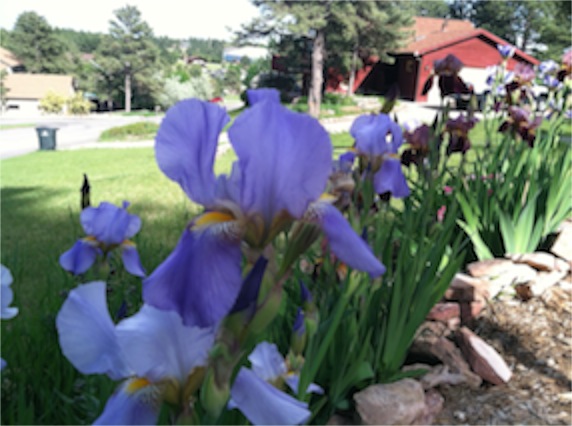 The perception of beauty is an elusive matter. People have different tastes. Some appreciate certain colors more than others. There may even be distinctions in our abilities to distinguish subtle variations in color. The old quote, “beauty is in the eye of the beholder,” has a certain truth.
The perception of beauty is an elusive matter. People have different tastes. Some appreciate certain colors more than others. There may even be distinctions in our abilities to distinguish subtle variations in color. The old quote, “beauty is in the eye of the beholder,” has a certain truth.
It is also the case the practice enhances our ability to gain joy from the experience of beauty. Taking time to look on a regular basis expands the capacity to gain pleasure from beauty. There are some works of art that you want to take home, hang on the wall and view daily. Even if beauty has no other function than the giving of pleasure, it seems to be worth the effort to observe the beauty of the world.
I have a preference for the beauty that naturally occurs. I’m not a real big fan of super formal gardens where every bush is shaped and the flowers are planted in precise patterns. I appreciate the work that goes into such places, but I guess I prefer my world a bit more natural and my beauty a bit more random. There is something to be said about being surprised by beauty, and discovering something beautiful in an unexpected location. I suppose that part of this preference could be a touch of laziness. I don’t seem to find the time to keep the garden completely manicured. There is always a bit of randomness to my plantings. And I like things like the iris that just come up year after year with little effort on my part.
I am grateful for the beauty that is in our world and I am doubly grateful for the capacity to observe and enjoy the beauty that surrounds us.
Folliott Pierpoint’s hymn comes to my mind:
 For the beauty of the earth,
For the beauty of the earth,
For the glory of the skies;
For the love which from our birth,
Over and around us lies;
Lord of all, to Thee we raise
This, our hymn of grateful praise.

Franz Kafka is a quirky writer. Anyone who has read “The Metamorphosis,” or “The Judgment,” will not soon forget the stories. Kafka once wrote, “Anyone who keeps the ability to see beauty never grows old.” It is a lovely sentiment, but I’m not sure that I really agree. In a way, the ability to see beauty is one of the joys of growing old. Despite the way that things seemed when I was a teenager, I don’t have much fear of growing old. There are some aspects of aging that are inviting. I’m not eager for increasing aches and pains, and I know that there are some real challenges to aging. On the other hand, it is not some terrible thing that is happening to me. There are great joys in memories that can be layered with contemporary experience. And there is great pleasure in having a few minutes to just look at the world.
What Kafka does for me, however, is to remind me that the ability to sense and experience beauty is a precious gift – one worth cultivating.
I don’t know if the ability to sense beauty is a uniquely human quality. It is easy to anthromorphize and speculate that the deer might also enjoy the beauty of the early summer evening. But they are mostly interested in finding food and preparing for the birth of new fawns. Who knows what perceptions go through the brains of the critters that are in the yard?
What I do know is that the ability to sense beauty is an important quality of human existence. I think Sean Parker Dennison got it right when he wrote, “The ability to see beauty is the beginning of our moral sensibility. What we believe is beautiful we will not wantonly destroy.”
It is hard to rank beauty among other values. A developmental psychologist might say that moral development in children comes not from a capacity for beauty, but rather from the ability to understand the cause and effect relationship between something that is done and the pain it causes another: “I don’t like it when I am hurt, therefore I can understand that another might also not want to be hurt.” Others claim that moral development grows out of the experience of loving and being loved.

It is also the case the practice enhances our ability to gain joy from the experience of beauty. Taking time to look on a regular basis expands the capacity to gain pleasure from beauty. There are some works of art that you want to take home, hang on the wall and view daily. Even if beauty has no other function than the giving of pleasure, it seems to be worth the effort to observe the beauty of the world.
I have a preference for the beauty that naturally occurs. I’m not a real big fan of super formal gardens where every bush is shaped and the flowers are planted in precise patterns. I appreciate the work that goes into such places, but I guess I prefer my world a bit more natural and my beauty a bit more random. There is something to be said about being surprised by beauty, and discovering something beautiful in an unexpected location. I suppose that part of this preference could be a touch of laziness. I don’t seem to find the time to keep the garden completely manicured. There is always a bit of randomness to my plantings. And I like things like the iris that just come up year after year with little effort on my part.
I am grateful for the beauty that is in our world and I am doubly grateful for the capacity to observe and enjoy the beauty that surrounds us.
Folliott Pierpoint’s hymn comes to my mind:

For the glory of the skies;
For the love which from our birth,
Over and around us lies;
Lord of all, to Thee we raise
This, our hymn of grateful praise.
Copyright © 2012 by Ted Huffman. I wrote this. If you want to copy it, please ask for permission. There is a contact me button at the bottom of this page. If you want to share my blog a friend, please direct your friend to my web site.
Trying to understand
22/05/12 05:48
Although I read a lot of news headlines and catch some of the stories, I sometimes find that I am really not aware of what is going on around me. That was the case yesterday. I was driving into town for a dental appointment when my cell phone rang. I pulled over and had a conversation with a colleague from Pierre. She was inquiring about the Rally and March that was going to take place in Rapid City. I knew nothing of the gathering or of the events that led up to it. She gave me a little information over the phone. I did a little checking on the Internet on my cell phone and got a little more information upon my return home. I have to admit, however, that I don’t really understand the situation.

Here is what I do know. About 300 people gathered in Memorial Park. They had songs and speakers in the park and then they marched south on 5th Street to Rapid City Regional Hospital. They were protesting what they see as institutionalized racism at the hospital. One of the rally organizers called for an end of native people using Regional for their health care. That is a tough demand. Regional provides medical procedures and services that are not available from any other source within hundreds of miles. For many people in our area, there isn’t really another choice.
The background to the story is complex. Vern Traversie was a patient at Rapid City Regional Hospital. He had a major surgery. I think it was an open-chest heart surgery. It is difficult to confirm the things I could find on the Internet. There can be no such thing as an official report from the hospital. Health information privacy laws prevent the hospital from even releasing the names of patients, let alone any specific information about their treatment or condition. The allegation is that someone at the hospital intentionally created scars on his belly to form the letters KKK. There is a picture that is widely circulating on the Internet, including Facebook. It does show the front of a person, without a face. There are numerous markings on the flesh. There are two scabs in the shape of a “K” the third requires a bit of imagination, but there is no shortage of imagination in this debate.
I am not an experienced medical professional. The marks might have been the result of tape that was place to hold drain tubes following the surgery. It doesn’t appear that they are scalpel cuts. You can see, however, how someone might interpret the marks as thee Ks. If someone intentionally disfigured another human being to put KKK on that person’s abdomen it would be reprehensible. Disgust and protest would be appropriate. Responsible persons should be held accountable.
The Rapid City Journal reported that a police investigation was initiated and that no charges were brought forward. The journal cited insufficient evidence.
There is no shortage of opinion. I made a couple of calls to friends up at Eagle Butte. I have read pages and pages of responses to blog posts. There are those who argue that there is no way the marks could be unintentional. There are those who argue the opposite.
Here is the thing about the arguments: people are rarely logical when they are angry. And there are angry people. I don’t expect rational argument to shape our community around this issue.
Racism is real in our community and in our world. People have uttered racial slurs. There has been discrimination in housing and jobs and other areas. There likely has been racial profiling in law enforcement, though it seems to be mostly from individual biases rather than from deeply ingrained institutional policy. Beyond the overt racism, we all could benefit from more cultural awareness and sensitivity.
In the church, we have been actively pursuing what we are calling “Sacred Conversations on Race.” We have been examining ourselves for signs of racism and we have been holding conversations that increase awareness and open channels of communication. We have devoted time at our annual meetings and our annual clergy retreat to listen carefully and to learn more of each other’s culture. Our local congregation has listed increasing partnerships with indigenous people as one of our highest priorities.
As I told one person yesterday, I’m not really a marcher. I walk in an annual suicide prevention and awareness walk, I have participated in group walks for a couple of other causes as well, but I’m not much for protest gatherings. I know that there are times when awareness must be raised, and that peaceful gatherings and marches are one way to bring attention to an issue. But my role in the community seems to be more as a witness than as an active participant.
What I don’t want to see happen is to have people “choosing sides” around our community hospital. We have only one hospital with an emergency room. There is only one neonatal intensive care unit. There is only one hospital for heart surgeries. There is only one cancer treatment center. In a community like ours, we need to make sure that our community hospital provides care for all of our people. Any evidence of discrimination needs to be taken seriously. Employees need to be carefully trained and need to receive regular recurrent training on cultural and racial issues.
I suspect that as a community hospital, Regional reflects the values of our community. When it provides caring and competent care, we are pleased. When someone receives less than optimal treatment, we have reason to be concerned.
I was told that the issue has been taken up by organizers from outside of our community. There was no shortage of rumors yesterday. Some said that people had traveled by bus from out of state to participate in the rally. Some of that makes sense, because the hospital treats people from hundreds of miles away. It also makes sense that racism in any part of our country affects all. People from out of state were bussed in for major civil rights rallies in the 1960’s all across the south. Still it makes it hard for us to figure out how to live in peace with our neighbors, when outside forces are trying to manipulate emotions and opinions.
For now, my role is to watch and to be a witness to what is going on. The rally and march yesterday were peaceful. The Rapid City Police Department officers were well trained and intervened only to protect the safety of all.
The conversation needs to continue. I will be listening.

Here is what I do know. About 300 people gathered in Memorial Park. They had songs and speakers in the park and then they marched south on 5th Street to Rapid City Regional Hospital. They were protesting what they see as institutionalized racism at the hospital. One of the rally organizers called for an end of native people using Regional for their health care. That is a tough demand. Regional provides medical procedures and services that are not available from any other source within hundreds of miles. For many people in our area, there isn’t really another choice.
The background to the story is complex. Vern Traversie was a patient at Rapid City Regional Hospital. He had a major surgery. I think it was an open-chest heart surgery. It is difficult to confirm the things I could find on the Internet. There can be no such thing as an official report from the hospital. Health information privacy laws prevent the hospital from even releasing the names of patients, let alone any specific information about their treatment or condition. The allegation is that someone at the hospital intentionally created scars on his belly to form the letters KKK. There is a picture that is widely circulating on the Internet, including Facebook. It does show the front of a person, without a face. There are numerous markings on the flesh. There are two scabs in the shape of a “K” the third requires a bit of imagination, but there is no shortage of imagination in this debate.
I am not an experienced medical professional. The marks might have been the result of tape that was place to hold drain tubes following the surgery. It doesn’t appear that they are scalpel cuts. You can see, however, how someone might interpret the marks as thee Ks. If someone intentionally disfigured another human being to put KKK on that person’s abdomen it would be reprehensible. Disgust and protest would be appropriate. Responsible persons should be held accountable.
The Rapid City Journal reported that a police investigation was initiated and that no charges were brought forward. The journal cited insufficient evidence.
There is no shortage of opinion. I made a couple of calls to friends up at Eagle Butte. I have read pages and pages of responses to blog posts. There are those who argue that there is no way the marks could be unintentional. There are those who argue the opposite.
Here is the thing about the arguments: people are rarely logical when they are angry. And there are angry people. I don’t expect rational argument to shape our community around this issue.
Racism is real in our community and in our world. People have uttered racial slurs. There has been discrimination in housing and jobs and other areas. There likely has been racial profiling in law enforcement, though it seems to be mostly from individual biases rather than from deeply ingrained institutional policy. Beyond the overt racism, we all could benefit from more cultural awareness and sensitivity.
In the church, we have been actively pursuing what we are calling “Sacred Conversations on Race.” We have been examining ourselves for signs of racism and we have been holding conversations that increase awareness and open channels of communication. We have devoted time at our annual meetings and our annual clergy retreat to listen carefully and to learn more of each other’s culture. Our local congregation has listed increasing partnerships with indigenous people as one of our highest priorities.
As I told one person yesterday, I’m not really a marcher. I walk in an annual suicide prevention and awareness walk, I have participated in group walks for a couple of other causes as well, but I’m not much for protest gatherings. I know that there are times when awareness must be raised, and that peaceful gatherings and marches are one way to bring attention to an issue. But my role in the community seems to be more as a witness than as an active participant.
What I don’t want to see happen is to have people “choosing sides” around our community hospital. We have only one hospital with an emergency room. There is only one neonatal intensive care unit. There is only one hospital for heart surgeries. There is only one cancer treatment center. In a community like ours, we need to make sure that our community hospital provides care for all of our people. Any evidence of discrimination needs to be taken seriously. Employees need to be carefully trained and need to receive regular recurrent training on cultural and racial issues.
I suspect that as a community hospital, Regional reflects the values of our community. When it provides caring and competent care, we are pleased. When someone receives less than optimal treatment, we have reason to be concerned.
I was told that the issue has been taken up by organizers from outside of our community. There was no shortage of rumors yesterday. Some said that people had traveled by bus from out of state to participate in the rally. Some of that makes sense, because the hospital treats people from hundreds of miles away. It also makes sense that racism in any part of our country affects all. People from out of state were bussed in for major civil rights rallies in the 1960’s all across the south. Still it makes it hard for us to figure out how to live in peace with our neighbors, when outside forces are trying to manipulate emotions and opinions.
For now, my role is to watch and to be a witness to what is going on. The rally and march yesterday were peaceful. The Rapid City Police Department officers were well trained and intervened only to protect the safety of all.
The conversation needs to continue. I will be listening.
Copyright © 2012 by Ted Huffman. I wrote this. If you want to copy it, please ask for permission. There is a contact me button at the bottom of this page. If you want to share my blog a friend, please direct your friend to my web site.
In search of Haiku
21/05/12 05:25
I have had some experiences in this life that give me stories that are easy to tell. But the story is never the experience. I think that experiences of awe and wonder might be better expressed in poetry, but I am a prose writer. When I have tried my hand at poetry, I have found myself disappointed. Like many arts, it looks easier than it is. So I read poems and occasionally I try my hand at one. I have read poems that capture experiences powerfully and reach beyond the capacity of ordinary words to capture the emotional impact of an event. But when I try to write such poems, I usually come up short.
I have to come up with a poem for my book club tomorrow. I made the assignment myself. I had campaigned for reading one of the books on imagination that have been inspiring me. The group chose Jean Paul Lederach’s The Moral Imagination. He shares several Haiku poems and speaks of the process of creating a Haiku as one of the ways of opening up imaginations to begin to grasp new alternatives in the midst of conflicted situations. So it made sense to try our hands at Haiku. As temporary discussion leader for the group, I suggested that we each write a Haiku for our meeting tomorrow.
I haven’t written my Haiku and the deadline is looming.
I think that writing poems might be like reading them. I can’t seem to just sit down and read a book of poems like I read a novel or a work of nonfiction. I have to read a poem and mull it. Sometimes I have to read a poem out loud to catch its rhythm. Sometimes I have to read a poem several times before it opens to me and reveals that deep moment of revelation. I go through lots of books a month. A single book of poems, on the other hand, will sit on my headboard for months before I go on to the next one.
Probably the best poems are not produced under the pressure of a deadline. Yet there I am with a deadline to write a poem. Worse yet, it is a deadline I imposed on myself.
 And Haiku is tough. Being a Japanese language art form, it doesn’t translate well into American English. In Japanese there are a lot of words that have five or seven syllables. The basic 5-7-5 rhythm that is reflected in Haiku is part of the natural rhythm of Japanese language. Various forms of five and seven are employed in most Japanese slogans. We tend to prefer shorter words. Because of the natural rhythm of the Japanese language, Haiku and Tanka forms are easily memorized and linger naturally in the brain. In English, we tend to prefer other rhythms. The songs that get stuck in our brains have different rhythms.
And Haiku is tough. Being a Japanese language art form, it doesn’t translate well into American English. In Japanese there are a lot of words that have five or seven syllables. The basic 5-7-5 rhythm that is reflected in Haiku is part of the natural rhythm of Japanese language. Various forms of five and seven are employed in most Japanese slogans. We tend to prefer shorter words. Because of the natural rhythm of the Japanese language, Haiku and Tanka forms are easily memorized and linger naturally in the brain. In English, we tend to prefer other rhythms. The songs that get stuck in our brains have different rhythms.
If only I had thought to assign a limerick instead of a haiku!
I have had the experience that I am quite sure should give rise to poetry. I have described it several times, but it still takes me a lot more words to describe what happened.
On Saturday evening, I drove along the edges of a thunderstorm for quite a while between Broken Bow and Thedford. I could see the hail in the barrow pits, but the storm had passed before my arrival on that stretch of road. By Thedford, when I turned north to drive through the sandhills to Valentine, the storm had passed to the east. It was evening, so I had the dark, dark cloud off to the east, on my right, and the bright sun starting to set on the west, to my left. It was like I was driving down the line between darkness and light. I think it might have made a dramatic photograph. The road is straight, but it goes up and down as it travels over the hills. However, I was in a hurry to get home. I had been up for many hours by that tine, had been responsible for six hours of classroom presentation, had driven for another four hours and still had three hours of driving ahead of me. I didn’t think I had time to stop to capture the perfect photograph. Furthermore, my photography skills are limited. My photos serve to remind me of experiences, but they rarely capture experiences.
I noticed the beauty, but I made no attempt to record it.
Then as I was driving, I caught motion off to the east. Against the dark of the clouds, a pair of white swans was flying. They crossed the road in front and above my truck. It seemed like they were very close, perhaps 25 feet or so above the truck. They flew off to the west and disappeared into the brilliant sunset.
It was amazing. It was stunning. I was awestruck.
When I tried to report the experience to my friend Ron the next morning, he, who has done a lot of driving in Nebraska, suggested that it was more the product of having driven too many miles in too few days. He joked that I might be seeing things that do not exist.
I know, however, that the birds were real. I am not an ornithologist, and I know that even experts are known to confuse swan identification. But these birds were big. It makes sense to me that they were trumpeters, the largest and heaviest waterfowl I am ever likely to see in the wild. I wasn’t expecting to see swans. The Nebraska Sandhills are known for the cranes. And it is late in the season for the larger numbers of transient birds that come each year.
There they were, however, right in front of me. The experience made the whole trip worthwhile. As they say, “I’m just glad I was there to see it.”
The Haiku, however, remains unwritten. Not that I haven’t tried. Here is my best attempt so far. It describes, but does not capture. It seems starkly devoid of emotion.
I have to come up with a poem for my book club tomorrow. I made the assignment myself. I had campaigned for reading one of the books on imagination that have been inspiring me. The group chose Jean Paul Lederach’s The Moral Imagination. He shares several Haiku poems and speaks of the process of creating a Haiku as one of the ways of opening up imaginations to begin to grasp new alternatives in the midst of conflicted situations. So it made sense to try our hands at Haiku. As temporary discussion leader for the group, I suggested that we each write a Haiku for our meeting tomorrow.
I haven’t written my Haiku and the deadline is looming.
I think that writing poems might be like reading them. I can’t seem to just sit down and read a book of poems like I read a novel or a work of nonfiction. I have to read a poem and mull it. Sometimes I have to read a poem out loud to catch its rhythm. Sometimes I have to read a poem several times before it opens to me and reveals that deep moment of revelation. I go through lots of books a month. A single book of poems, on the other hand, will sit on my headboard for months before I go on to the next one.
Probably the best poems are not produced under the pressure of a deadline. Yet there I am with a deadline to write a poem. Worse yet, it is a deadline I imposed on myself.

If only I had thought to assign a limerick instead of a haiku!
I have had the experience that I am quite sure should give rise to poetry. I have described it several times, but it still takes me a lot more words to describe what happened.
On Saturday evening, I drove along the edges of a thunderstorm for quite a while between Broken Bow and Thedford. I could see the hail in the barrow pits, but the storm had passed before my arrival on that stretch of road. By Thedford, when I turned north to drive through the sandhills to Valentine, the storm had passed to the east. It was evening, so I had the dark, dark cloud off to the east, on my right, and the bright sun starting to set on the west, to my left. It was like I was driving down the line between darkness and light. I think it might have made a dramatic photograph. The road is straight, but it goes up and down as it travels over the hills. However, I was in a hurry to get home. I had been up for many hours by that tine, had been responsible for six hours of classroom presentation, had driven for another four hours and still had three hours of driving ahead of me. I didn’t think I had time to stop to capture the perfect photograph. Furthermore, my photography skills are limited. My photos serve to remind me of experiences, but they rarely capture experiences.
I noticed the beauty, but I made no attempt to record it.
Then as I was driving, I caught motion off to the east. Against the dark of the clouds, a pair of white swans was flying. They crossed the road in front and above my truck. It seemed like they were very close, perhaps 25 feet or so above the truck. They flew off to the west and disappeared into the brilliant sunset.
It was amazing. It was stunning. I was awestruck.
When I tried to report the experience to my friend Ron the next morning, he, who has done a lot of driving in Nebraska, suggested that it was more the product of having driven too many miles in too few days. He joked that I might be seeing things that do not exist.
I know, however, that the birds were real. I am not an ornithologist, and I know that even experts are known to confuse swan identification. But these birds were big. It makes sense to me that they were trumpeters, the largest and heaviest waterfowl I am ever likely to see in the wild. I wasn’t expecting to see swans. The Nebraska Sandhills are known for the cranes. And it is late in the season for the larger numbers of transient birds that come each year.
There they were, however, right in front of me. The experience made the whole trip worthwhile. As they say, “I’m just glad I was there to see it.”
The Haiku, however, remains unwritten. Not that I haven’t tried. Here is my best attempt so far. It describes, but does not capture. It seems starkly devoid of emotion.
At the border of
storm darkened skies and sunset,
suddenly two swans!

I’ll keep working on it. Maybe I ought to learn Japanese.
Copyright © 2012 by Ted Huffman. I wrote this. If you want to copy it, please ask for permission. There is a contact me button at the bottom of this page. If you want to share my blog a friend, please direct your friend to my web site.
Confirmation
20/05/12 05:03
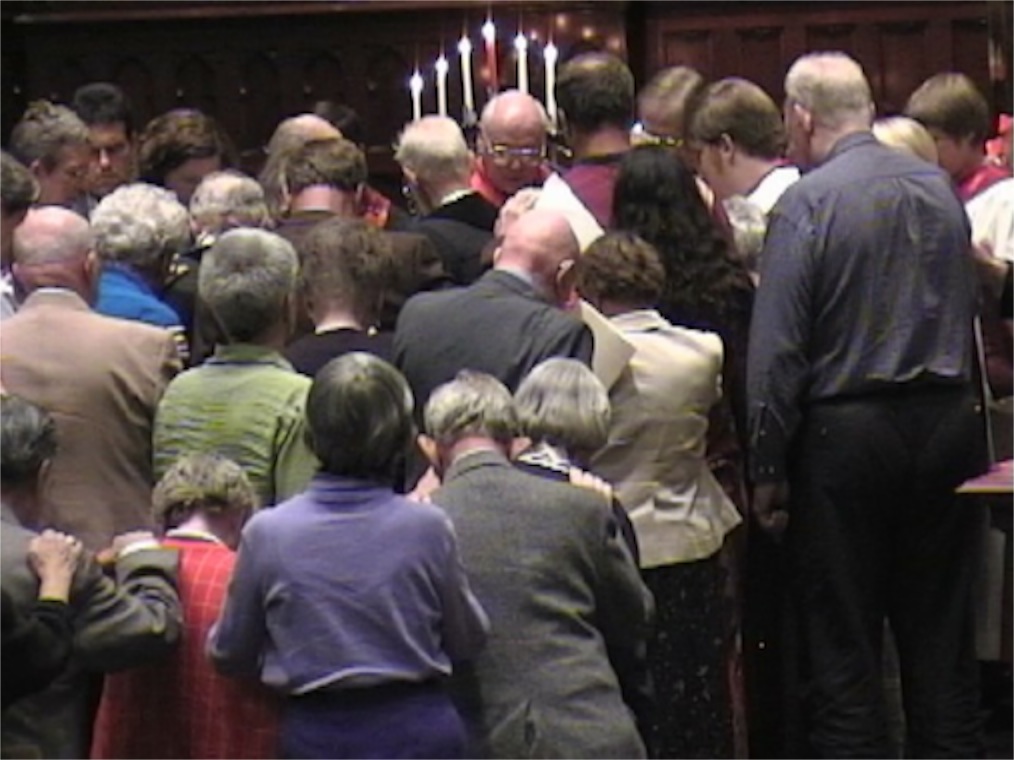
Today is confirmation Sunday in our congregation. Seven candidates, assisted by their mentors have been working diligently to prepare for the rite of confirmation. In our tradition, children are welcomed fully into the body of Christ at their baptism. Confirmation is a rite that acknowledges that baptism and provides the candidate an opportunity to own the vows of membership. It is a ceremony of commitment.
A lot of attention will be focused on the candidates for confirmation today. They will receive gifts. They will shake hands with members of the congregation. They will receive many congratulations. It is appropriate.
But I have been thinking also about the congregation. It is a big day for us as well. It is not just because we have nurtured these young people as they grew from infancy to this point in their lives. We have done that. It is not because we have forged partnerships to support their parents in their difficult tasks. We have done that. It is not because was have partnered with these confirmands in their projects as they assumed leadership in the ministries of the church. We have also done that.
The real challenge, for our congregation is even more difficult.
We have to change our way of thinking. We have been talking and thinking for years of our youth as the “future of the church.” The covenant we make this morning, however, is not only about what will happen some day in the future. It is about the relationship we have right now. Today we promise to receive and honor these people as full members of the church today. Every new member changes the congregation. It is adjustment that we think we want. We give a lot of lip service to wanting new members. Sometimes, however, we are less than gracious about sharing power and allowing the ideas of new members to hold sway. It is a curious thing. We want new members, but sometimes we want them to be just like us. Sometimes we don’t want the change that comes with the new members.
Every class of youth preparing for confirmation is special. This group is wonderfully so. Susan and I have been pastors of this congregation for all of their lives. They can’t remember the pastors who came before us because we were already serving this church when they were born. To put it simply, we are the “old guard” from their perspective. We represent tradition and institutional stability. What they know of the church has us associated with it, so to them we are part of what has “always” been. Even though we know ministers come and ministers go, they have not yet experienced that part of church life.
The rite of confirmation itself is always a powerful moment. We lay our hands on the candidates as they kneel before the congregation. Their mentors and families gather around. The congregation reaches out to touch others as we pray. The prayers themselves are carefully crafted. We have been taking notes and revising the prayers for months, trying to find just the right words to make the connection between the history and traditions of the church and this new member who will shape its present and future.
I think that even after the words are forgotten the touch remains.
I remember the touch of the minister at my confirmation. I think of the touch of the pastors at our ordinations. The church has had times of misusing the power of touch. We all know of the destructive power of inappropriate touch and the pain caused by its cover up. But there have also been times when the power of touch was used to manipulate and control who could and couldn’t have their ministries recognized. Men have used the claims of apostolic succession to limit the ministries of women. At some points in the history of the church, bishops have claimed inordinate power to control who can and cannot become priests. Instead of marveling at the power of the community some have tried to consolidate their own power.
The strength and mystery of touch remains, however. The hands that will gently touch the shoulders and heads of our confirmands belong to people who have been touched by the grandmothers and grandfathers of our faith. Generations of church membership provide a direct line of touch to the founders of our congregation. Whether or not we can identify the exact chain of touch, the effect of people who have been touched by people who have been touched by people stretches back to the founding of the church – to Jesus’ simple act of washing the feet of the first disciples. We belong to that lineage. This is our family.
The chain does not only stretch backward. It can be overwhelming to think of the yet unborn generations of faithful people who will receive touch from those we confirm today. As they fold their hands in prayer, I am aware that those hands will one day hold new babies. Those hands will work on mission projects we have not yet imagined. Those hands will serve the bread and cup of communion to ones we will never meet face to face.
It is a powerful event.
No wonder we have worked so long and hard to prepare for this moment. To have done anything less would be unworthy of the trust that has been shared with our generation.
So it is natural that I worry about us. There is much that rests on how we show hospitality to these members of our congregation. We are defined by how we welcome each member into the Body of Christ.
There is a very important phrase that will be repeated today as we exchange our vows of membership. When asked to commit to these awesome promises we say, “I will, with the help of God.” In our very answer, we acknowledge that we cannot of our own power remain faithful to such great commitments. We will need to rely on assistance that comes from beyond ourselves. Our help lies in the generations who have come before. Our help lies in the generations that are yet to come. But even more than that, our help lies in God who created and who continues to create.
Today will be a day to remember.
Copyright © 2012 by Ted Huffman. I wrote this. If you want to copy it, please ask for permission. There is a contact me button at the bottom of this page. If you want to share my blog a friend, please direct your friend to my web site.
Ministry on the Plains
19/05/12 03:49
My teaching this weekend is designed for students who are working toward authorization as lay ministers in Nebraska. They have experienced a sense of call to the ministry and enrolled in a course of study designed to equip them for the ministry to which they have been called. My role is teaching a single class. They have many other classes in their curriculum that help them prepare for ministry.
 There is nothing new bout lay ministers. They have been a part of the story of the church since the beginning. In a sense Jesus’ first disciples were all lay people. They had no institutional church to provide them with a salary or means of support. They came from a variety of secular jobs such as fishing and tax collecting. They became leaders in the church not because of academic preparation, but because of the call of Jesus and their life experiences. They were equipped not by taking classes, but by listening to Jesus.
There is nothing new bout lay ministers. They have been a part of the story of the church since the beginning. In a sense Jesus’ first disciples were all lay people. They had no institutional church to provide them with a salary or means of support. They came from a variety of secular jobs such as fishing and tax collecting. They became leaders in the church not because of academic preparation, but because of the call of Jesus and their life experiences. They were equipped not by taking classes, but by listening to Jesus.
Today’s lay ministers in the Upper Plains face a unique set of circumstances. The increasing urbanization of our society has left a visible sign on the plains. Towns are shrinking. This has been a long, slow process. Towns on the plains have been shrinking for 70 years. Some counties have been in population decline for more than a century. Along with the decrease in the size of town, the churches are also getting smaller. And smaller churches are less able to afford full-time ministers. Different solutions need to be found for the church’s need of leaders. Lay ministry programs are in full operation in all of the states that surround our home and in our state as well. I have taught in four different states, and continue to resource lay ministers as an educational consultant.
In the midst of the shrinking congregations of the plains, we are not immune to the sociological trends of the wider society. Less than half of Americans (42%) attend church regularly. Nebraska has slightly higher church attendance than the national average, with 53% claiming regular church attendance. Only 45% of South Dakotans claim regular church attendance. And the change in church attendance is most dramatic in the upper Midwest. In fact, South Dakota is leading the nation in the decline in church attendance at the rate of 3% per year.
The picture is not one of growing churches and increasing full-time jobs for ministers.
That does not, mean, however, that faithful congregations in small towns have to resign themselves to less than competent ministry. We have the resources to fully equip congregations for their mission and ministry. There are enough worship leaders to serve our congregation. God has continued to be faithful in providing the leadership that the church requires. What is required of us, however, is openness to new answers to our questions and new leaders for our congregations.
So many things in life are evaluated by counting. There is a myth of perpetual growth in our society. We often think that things have to get bigger in order to be better. Life in a community that isn’t growing and that isn’t going to grow anytime in the near future invites a new way of thinking. Christianity even offers opportunities to return to older ways of thinking.
 Christianity did not start out as a mass movement. Jesus started with twelve disciples and they got to know one another very well. The early church was a persecuted minority who lived their faith in the midst of a world that offered many different religions, ways of thinking, styles of living and challenges to those who sought to follow Jesus. In Matthew 18:20 Jesus promises that “Wherever two or three are gathered in my name, there I am with them.” The practice of Christianity doesn’t require large numbers of people.
Christianity did not start out as a mass movement. Jesus started with twelve disciples and they got to know one another very well. The early church was a persecuted minority who lived their faith in the midst of a world that offered many different religions, ways of thinking, styles of living and challenges to those who sought to follow Jesus. In Matthew 18:20 Jesus promises that “Wherever two or three are gathered in my name, there I am with them.” The practice of Christianity doesn’t require large numbers of people.
In fact, many of the trappings that we often associate with our faith can fall away to reveal the essence of that lies at the core of our beliefs. As a pastor, who has devoted his life to the Christian ministry, I sometimes get caught up in the model of churches being led by those who are theologically educated, who possess degrees, and who are ordained by the church. This is definitely a model of ministry, but it isn’t the only model. And, frankly, there have been drawbacks to this model. Ministers have fallen into secular ways of thinking about their careers. They can find themselves thinking about the next place, and make a less than complete commitment to a congregation. Pastors come and pastors go.
The lay ministry model understands that every Christian has a vocation. We are all called to ministry and the work of the church is not just the work of a professional who is paid to serve, but rather the work of all of the members of the church who are called to service in various places of their lives. When each member of a community discovers her or his ministry the community is supported in a wide variety of ways and faith is lived in a wide variety of settings. We can learn to be a faithful church without big budgets, fancy buildings and staff.
For more than a century churches on the plains have operated with imported leadership and a hierarchy of Associations and Conferences. We have assumed that the church requires different levels of administration in order to do its work. Our image of a small church pastor is one who serves more than one congregation at the same time, who comes for a short period of time and moves on. The emphasis on these ministers has been expensive in terms of money and time and it has sometimes diverted our attention from the real ministry that goes on in the day-to-day lives of the people who put down roots and remain in the community. They rarely earn their livings as professional clergy. They are the farmers and merchants and teachers who make their homes and find their lives in the midst of the towns.
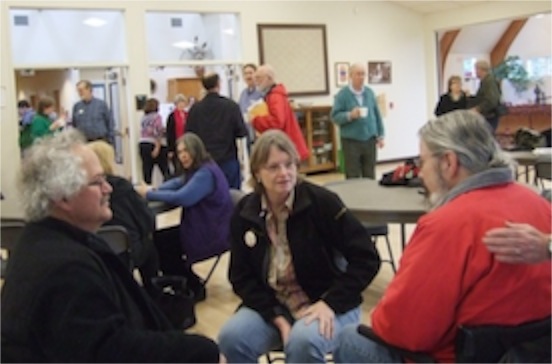 It is a privilege to work with these lay ministers as they grow in their faith, explore their vocations and prepare for more ministries on the plains. They come together for times of learning and then go back to their homes to serve their neighbors and be stewards of their churches.
It is a privilege to work with these lay ministers as they grow in their faith, explore their vocations and prepare for more ministries on the plains. They come together for times of learning and then go back to their homes to serve their neighbors and be stewards of their churches.
We will continue to see small churches that are forced to close their doors. The institution will be reshaped as time goes by. But faith is far from gone from the prairies. It is alive and well and exciting. I know. God continues to bless my life with times to meet those who serve in places where there are small numbers but great faith.

Today’s lay ministers in the Upper Plains face a unique set of circumstances. The increasing urbanization of our society has left a visible sign on the plains. Towns are shrinking. This has been a long, slow process. Towns on the plains have been shrinking for 70 years. Some counties have been in population decline for more than a century. Along with the decrease in the size of town, the churches are also getting smaller. And smaller churches are less able to afford full-time ministers. Different solutions need to be found for the church’s need of leaders. Lay ministry programs are in full operation in all of the states that surround our home and in our state as well. I have taught in four different states, and continue to resource lay ministers as an educational consultant.
In the midst of the shrinking congregations of the plains, we are not immune to the sociological trends of the wider society. Less than half of Americans (42%) attend church regularly. Nebraska has slightly higher church attendance than the national average, with 53% claiming regular church attendance. Only 45% of South Dakotans claim regular church attendance. And the change in church attendance is most dramatic in the upper Midwest. In fact, South Dakota is leading the nation in the decline in church attendance at the rate of 3% per year.
The picture is not one of growing churches and increasing full-time jobs for ministers.
That does not, mean, however, that faithful congregations in small towns have to resign themselves to less than competent ministry. We have the resources to fully equip congregations for their mission and ministry. There are enough worship leaders to serve our congregation. God has continued to be faithful in providing the leadership that the church requires. What is required of us, however, is openness to new answers to our questions and new leaders for our congregations.
So many things in life are evaluated by counting. There is a myth of perpetual growth in our society. We often think that things have to get bigger in order to be better. Life in a community that isn’t growing and that isn’t going to grow anytime in the near future invites a new way of thinking. Christianity even offers opportunities to return to older ways of thinking.

In fact, many of the trappings that we often associate with our faith can fall away to reveal the essence of that lies at the core of our beliefs. As a pastor, who has devoted his life to the Christian ministry, I sometimes get caught up in the model of churches being led by those who are theologically educated, who possess degrees, and who are ordained by the church. This is definitely a model of ministry, but it isn’t the only model. And, frankly, there have been drawbacks to this model. Ministers have fallen into secular ways of thinking about their careers. They can find themselves thinking about the next place, and make a less than complete commitment to a congregation. Pastors come and pastors go.
The lay ministry model understands that every Christian has a vocation. We are all called to ministry and the work of the church is not just the work of a professional who is paid to serve, but rather the work of all of the members of the church who are called to service in various places of their lives. When each member of a community discovers her or his ministry the community is supported in a wide variety of ways and faith is lived in a wide variety of settings. We can learn to be a faithful church without big budgets, fancy buildings and staff.
For more than a century churches on the plains have operated with imported leadership and a hierarchy of Associations and Conferences. We have assumed that the church requires different levels of administration in order to do its work. Our image of a small church pastor is one who serves more than one congregation at the same time, who comes for a short period of time and moves on. The emphasis on these ministers has been expensive in terms of money and time and it has sometimes diverted our attention from the real ministry that goes on in the day-to-day lives of the people who put down roots and remain in the community. They rarely earn their livings as professional clergy. They are the farmers and merchants and teachers who make their homes and find their lives in the midst of the towns.

We will continue to see small churches that are forced to close their doors. The institution will be reshaped as time goes by. But faith is far from gone from the prairies. It is alive and well and exciting. I know. God continues to bless my life with times to meet those who serve in places where there are small numbers but great faith.
Copyright © 2012 by Ted Huffman. I wrote this. If you want to copy it, please ask for permission. There is a contact me button at the bottom of this page. If you want to share my blog a friend, please direct your friend to my web site.
The Lure of the Prairie
18/05/12 04:05
My dentist is a very good photographer. He is really good at capturing light in some of his landscape photos. He has made some stunning images of the badlands. One day he told me that he adds a minimum of 15 minutes to every trip across South Dakota so that he can make an image from the same place in the badlands. He wants to capture the scene with as many different types of lighting as possible. He hopes that one of his pictures will be just what he wants. Along the way, he has captured images in all kinds of weather at all seasons of the year.
 I am not that disciplined with my photography. I sometimes grab my camera when I see something that is particularly beautiful or that stirs my soul, but sometimes I just look in amazement and hope that I can remember what I have seen. Sometimes I know that even if I take a picture, the image will be far less dramatic than the experience.
I am not that disciplined with my photography. I sometimes grab my camera when I see something that is particularly beautiful or that stirs my soul, but sometimes I just look in amazement and hope that I can remember what I have seen. Sometimes I know that even if I take a picture, the image will be far less dramatic than the experience.
I am a child of the mountains. When I was growing up, I never believed that I would live in a place where I could not see mountains that were at least tall enough to sport snow in the summer and an area of rocks above the tree line. As such, some of my friends think I am a bit judgmental when it comes to the hills. Don’t get me wrong. I love the Black Hills. I love living in the hills. Their beauty inspires me. But I never call them mountains. The highest point in the Black Hills, while being taller than any peak east of here on this continent, including everything that is called a mountain in the eastern half of the United States, is just 7,244 feet. That elevation is less than the elevation of the church camp I attended as a youth. And that camp sits in the bottom of a mountain valley with peaks towering over it on both sides.
What I did not expect when I was growing up was the lure of the prairie. I simply love driving across the plains. There is so much to see, so much to experience. From time to time, I find that a drive across the plains renews my spirit and gives me time to think.
So I am anticipating today with great joy. In a little while I will leave my home and drive for a little over 7 hours to reach Hastings, Nebraska, where I will be teaching this evening and tomorrow. My duty is light today. I just have the drive and two hours of classroom teaching. If I leave as planned, there will be time for a short nap when I get to Hastings.
 The drive is beautiful. There are several different routes that I could take, but today I plan to drive east to Murdo and from there turn south to Valentine and on through the Nebraska Sandhills. Chances are I will be too late to see the gorgeous sandhill cranes. March and April are the best crane viewing times in the spring. They won’t be back until late September or early October. But the place that gave them their name is a unique piece of geography and there will be plenty of other things to see.
The drive is beautiful. There are several different routes that I could take, but today I plan to drive east to Murdo and from there turn south to Valentine and on through the Nebraska Sandhills. Chances are I will be too late to see the gorgeous sandhill cranes. March and April are the best crane viewing times in the spring. They won’t be back until late September or early October. But the place that gave them their name is a unique piece of geography and there will be plenty of other things to see.
Of course, if I wanted to put on my superior attitude, my comments about the Nebraska State Forest might make my occasional comments about the Black Hills seem mild by comparison, so I’ll just say I get to drive by a section of Nebraska State Forest today. I probably won’t stop.
 Fort Kearney isn’t just a stopover for the cranes as they go north and south. It has also been a stopover for people since the westward migration of folks along the Oregon Trail. Just west of Fort Kearney is the site where Doby Town used to be. The historical marker speaks of horrible whiskey and notorious gatherings. It is hard to think of the spot as a place of much of a gathering these days, but I don’t drive across Nebraska for the social graces. I thrive on Nebraska’s gift of time alone.
Fort Kearney isn’t just a stopover for the cranes as they go north and south. It has also been a stopover for people since the westward migration of folks along the Oregon Trail. Just west of Fort Kearney is the site where Doby Town used to be. The historical marker speaks of horrible whiskey and notorious gatherings. It is hard to think of the spot as a place of much of a gathering these days, but I don’t drive across Nebraska for the social graces. I thrive on Nebraska’s gift of time alone.
I’ve been known to blast opera on the car stereo as I drive. I’ve been known to catch up on all of the recorded lectures that I have collected but haven’t yet digested. On my best days I sit silently and watch as I drive across the marvelous expanse of land that is appropriately lightly populated. Too many people would ruin a land like this. Fortunately, there aren’t too many people.
 Some of the ones who live in the empty places are characters, of course. I guess I would be if I spent too much time alone. Living in the relatively large city of Rapid City I get to have it both ways: people when I want company and access to the empty places when I want solitude. Both Mark and Luke report that Jesus would rise early in the morning, while most of the rest of the people were sleeping, and go off to a lonely place to pray. Being a disciple of Jesus, I too appreciate early mornings and lonely places. My best prayers are not accompanied by words.
Some of the ones who live in the empty places are characters, of course. I guess I would be if I spent too much time alone. Living in the relatively large city of Rapid City I get to have it both ways: people when I want company and access to the empty places when I want solitude. Both Mark and Luke report that Jesus would rise early in the morning, while most of the rest of the people were sleeping, and go off to a lonely place to pray. Being a disciple of Jesus, I too appreciate early mornings and lonely places. My best prayers are not accompanied by words.
So I am really looking forward to today’s drive. It is an opportunity to clear my mind, to reconnect with what is most important, to de-clutter my thinking. Perspective is important for a pastor. We pray in public every day. Public praying is almost always talking. You can only do that if you make time to listen as well. Today and tomorrow are gifts for my ministry and for my life.
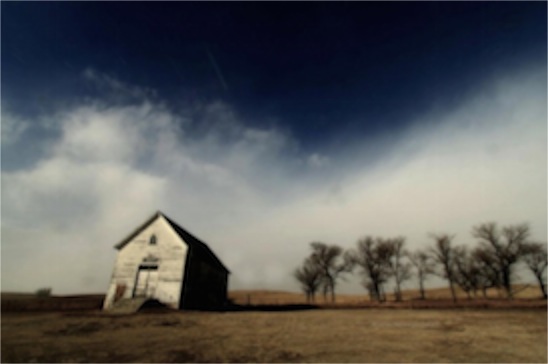 I think that the prairie calls those who take time to listen. Perhaps it is the wind as much as it is the birdsong. Perhaps it is the still small voice that requires silencing of the usual hubbub of everyday life. Perhaps it is the transcendent nature of God who is anywhere and everywhere all at the same time.
I think that the prairie calls those who take time to listen. Perhaps it is the wind as much as it is the birdsong. Perhaps it is the still small voice that requires silencing of the usual hubbub of everyday life. Perhaps it is the transcendent nature of God who is anywhere and everywhere all at the same time.
It is time to get rolling. The prairie is calling.

I am a child of the mountains. When I was growing up, I never believed that I would live in a place where I could not see mountains that were at least tall enough to sport snow in the summer and an area of rocks above the tree line. As such, some of my friends think I am a bit judgmental when it comes to the hills. Don’t get me wrong. I love the Black Hills. I love living in the hills. Their beauty inspires me. But I never call them mountains. The highest point in the Black Hills, while being taller than any peak east of here on this continent, including everything that is called a mountain in the eastern half of the United States, is just 7,244 feet. That elevation is less than the elevation of the church camp I attended as a youth. And that camp sits in the bottom of a mountain valley with peaks towering over it on both sides.
What I did not expect when I was growing up was the lure of the prairie. I simply love driving across the plains. There is so much to see, so much to experience. From time to time, I find that a drive across the plains renews my spirit and gives me time to think.
So I am anticipating today with great joy. In a little while I will leave my home and drive for a little over 7 hours to reach Hastings, Nebraska, where I will be teaching this evening and tomorrow. My duty is light today. I just have the drive and two hours of classroom teaching. If I leave as planned, there will be time for a short nap when I get to Hastings.

Of course, if I wanted to put on my superior attitude, my comments about the Nebraska State Forest might make my occasional comments about the Black Hills seem mild by comparison, so I’ll just say I get to drive by a section of Nebraska State Forest today. I probably won’t stop.

I’ve been known to blast opera on the car stereo as I drive. I’ve been known to catch up on all of the recorded lectures that I have collected but haven’t yet digested. On my best days I sit silently and watch as I drive across the marvelous expanse of land that is appropriately lightly populated. Too many people would ruin a land like this. Fortunately, there aren’t too many people.

So I am really looking forward to today’s drive. It is an opportunity to clear my mind, to reconnect with what is most important, to de-clutter my thinking. Perspective is important for a pastor. We pray in public every day. Public praying is almost always talking. You can only do that if you make time to listen as well. Today and tomorrow are gifts for my ministry and for my life.

It is time to get rolling. The prairie is calling.
Copyright © 2012 by Ted Huffman. I wrote this. If you want to copy it, please ask for permission. There is a contact me button at the bottom of this page. If you want to share my blog a friend, please direct your friend to my web site.
The Wisdom of Turtles
17/05/12 05:48
Tortuguero means “region of turtles” in Spanish. In Costa Rica, it is the name of a marvelous national park on the Caribbean side of the country. Tortuguero is an appropriate name for a place that is the nesting ground for four of the world’s eigh species of green sea turtles: Leatherback, Olive Ridley, Loggerhead, and Hawksbill. The Loggerhead is the world’s largest hard-shelled sea turtle. Loggerheads are threatened due to poaching and accidental entanglement in fishing nets. There haven’t been any recent sightings of turtles that have grown to their largest size, but in the past, individuals that weighed more than 1,000 pounds were recorded. Average size of mature adults these days is about 375 pounds. That is still a very large turtle.
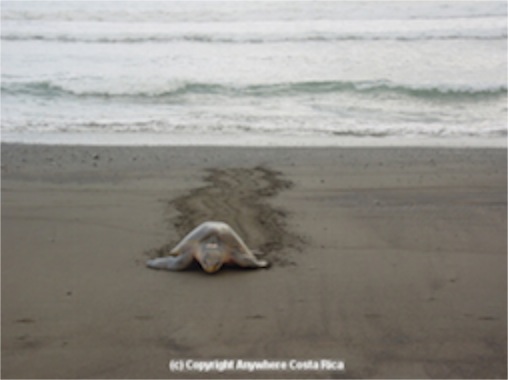 They come to Costa Rica to lay their eggs. Summer is the season of the turtle’s return. For the next few months, the turtles will be floating and mating off of the coast. At night, the females come on to land to dig nests. A single turtle can deposit between 60 and 80 eggs in a nest and will leave additional clutches in a few days. The average female lays 3 to 6 clutches. The length of incubation varies, partly due to the temperature of the sand, but in 7 to 10 weeks, the eggs hatch.
They come to Costa Rica to lay their eggs. Summer is the season of the turtle’s return. For the next few months, the turtles will be floating and mating off of the coast. At night, the females come on to land to dig nests. A single turtle can deposit between 60 and 80 eggs in a nest and will leave additional clutches in a few days. The average female lays 3 to 6 clutches. The length of incubation varies, partly due to the temperature of the sand, but in 7 to 10 weeks, the eggs hatch.
The real adventure begins with the hatching. The little turtles make a dash for the surf, but only a small percentage makes it to the relative safety of the water. Crawling across the sand makes the tiny turtles easy prey for crabs and predatory birds.
 Once in the water, the turtles participate in a transoceanic migration that covers thousands of miles. When they are mature, they return to the place of their birth to mate and lay eggs. It takes two to four years for a turtle to make the migration and return. Only about on in 4,000 hatchlings lives long enough to return to the beach.
Once in the water, the turtles participate in a transoceanic migration that covers thousands of miles. When they are mature, they return to the place of their birth to mate and lay eggs. It takes two to four years for a turtle to make the migration and return. Only about on in 4,000 hatchlings lives long enough to return to the beach.
A recent study of sea turtles, conducted by a team from the University of North Carolina led by Kenneth J. Lohmann, found that sea turtles are born with internal regional maps imprinted into their brains. If the turtles were to die out in a particular nesting area, they could not be replaced because relocated turtles would be completely lost.
The turtles have become one of the symbols of Costa Rica.
There are many stories about turtles in the country. One legend says that Tortuguero Hill, an extinct volcano, is actually a giant turtle that lures the other turtles back each year.

In another story there once was a man on a boat along the coast of Costa Rica. He was traveling to Tortuguero to pick up supplies when it began to storm. He didn’t want to turn back, because he needed supplies. However, he knew that it was too dangerous to approach the coast during the storm. Near the shore he would surely capsize in the waves. Not knowing what to do, the man looked down into the water and saw a green sea turtle breach the choppy water beside his boat. Knowing where the turtle would go, the man attached his supply list to the turtle’s shell. The turtle continued to its nesting grounds in Tortuguero, where the man’s son found the list and sent the goods to him the next day.
I do not know the origins of the legends of sea turtles in Costa Rica. They do, however, have an important function in the area because they point out the relationship between humans and turtles. We need each other. We need to live in a world where sea turtles thrive. The very environmental factors that sustain the turtles also provide for the human inhabitants of this planet.
Turtles are often depicted as easygoing, patient and wise creatures. Due to their long lifespan and slow movement, they are an emblem of longevity and stability in many cultures. It probably doesn’t hurt that their skin has a wrinkly appearance, either. The Lakota refer to the North American continent as Turtle Island. The Cree have a story of a turtle saving humans in a time of catastrophic flood. All around the world various cultures have turtle symbols, stories, and poems. Turtles figure prominently in several different ancient creation stories. They have become the poster illustrations for the movement to care for the marine environment.
This morning, as I was scanning the headlines, thinking of a topic for today’s blog, I was struck by the prevalence of human-caused troubles in the news. The trial of Ratko Mladic on war crimes has been adjourned because of significant prosecutorial errors. Chinese dissident Chen Guangcheng and his family are awaiting the issuance of their passports so they can leave China even as stories of violence against relatives surface. Turmoil in Greece and its wider effects loom over the opening of the G-8 summit at Camp David. The US House of Representatives appears to be heading for another “game of chicken” over the federal debt and budget. The losses at JP Morgan Chase may have been under reported and may have fueled faster deterioration in the credit market.
 Meanwhile in Costa Rica, it is “Pura Vida.” The turtles are hatching and making their dash to the sea. The sun is warming the beach and the sand is warming the tiny eggs. The turtles are back and once again beating the odds. The old men are gathering in the corner bodegas and telling their stories. If they are beginning to learn wisdom, they younger clerks will listen again to the same old story of the man and the fishing boat and the note tied to the turtle. Even though the story has been retold so many times that it is memorized, it contains a bit of the culture of the land. Decades from now that young clerk will himself be an old man who will tell the story over and over simply because he cannot imagine Costa Rica without the story and he wants to make sure that someone remembers it to tell to future generations. They may not remember the subtle lessons and meanings that come from the story, but they do remember the story. And that is enough.
Meanwhile in Costa Rica, it is “Pura Vida.” The turtles are hatching and making their dash to the sea. The sun is warming the beach and the sand is warming the tiny eggs. The turtles are back and once again beating the odds. The old men are gathering in the corner bodegas and telling their stories. If they are beginning to learn wisdom, they younger clerks will listen again to the same old story of the man and the fishing boat and the note tied to the turtle. Even though the story has been retold so many times that it is memorized, it contains a bit of the culture of the land. Decades from now that young clerk will himself be an old man who will tell the story over and over simply because he cannot imagine Costa Rica without the story and he wants to make sure that someone remembers it to tell to future generations. They may not remember the subtle lessons and meanings that come from the story, but they do remember the story. And that is enough.
And the turtles that survived the 1 in 4,000 odds to reach maturity will loll off of the coast and perhaps munch on a few of the crabs to marginally improve the odds for the new generation, running the gauntlet on the beach. Life goes on even when we are distracted.
I am grateful I have news of the turtles in Costa Rica to offset the news of human folly from the rest of the world.

The real adventure begins with the hatching. The little turtles make a dash for the surf, but only a small percentage makes it to the relative safety of the water. Crawling across the sand makes the tiny turtles easy prey for crabs and predatory birds.

A recent study of sea turtles, conducted by a team from the University of North Carolina led by Kenneth J. Lohmann, found that sea turtles are born with internal regional maps imprinted into their brains. If the turtles were to die out in a particular nesting area, they could not be replaced because relocated turtles would be completely lost.
The turtles have become one of the symbols of Costa Rica.
There are many stories about turtles in the country. One legend says that Tortuguero Hill, an extinct volcano, is actually a giant turtle that lures the other turtles back each year.

In another story there once was a man on a boat along the coast of Costa Rica. He was traveling to Tortuguero to pick up supplies when it began to storm. He didn’t want to turn back, because he needed supplies. However, he knew that it was too dangerous to approach the coast during the storm. Near the shore he would surely capsize in the waves. Not knowing what to do, the man looked down into the water and saw a green sea turtle breach the choppy water beside his boat. Knowing where the turtle would go, the man attached his supply list to the turtle’s shell. The turtle continued to its nesting grounds in Tortuguero, where the man’s son found the list and sent the goods to him the next day.
I do not know the origins of the legends of sea turtles in Costa Rica. They do, however, have an important function in the area because they point out the relationship between humans and turtles. We need each other. We need to live in a world where sea turtles thrive. The very environmental factors that sustain the turtles also provide for the human inhabitants of this planet.
Turtles are often depicted as easygoing, patient and wise creatures. Due to their long lifespan and slow movement, they are an emblem of longevity and stability in many cultures. It probably doesn’t hurt that their skin has a wrinkly appearance, either. The Lakota refer to the North American continent as Turtle Island. The Cree have a story of a turtle saving humans in a time of catastrophic flood. All around the world various cultures have turtle symbols, stories, and poems. Turtles figure prominently in several different ancient creation stories. They have become the poster illustrations for the movement to care for the marine environment.
This morning, as I was scanning the headlines, thinking of a topic for today’s blog, I was struck by the prevalence of human-caused troubles in the news. The trial of Ratko Mladic on war crimes has been adjourned because of significant prosecutorial errors. Chinese dissident Chen Guangcheng and his family are awaiting the issuance of their passports so they can leave China even as stories of violence against relatives surface. Turmoil in Greece and its wider effects loom over the opening of the G-8 summit at Camp David. The US House of Representatives appears to be heading for another “game of chicken” over the federal debt and budget. The losses at JP Morgan Chase may have been under reported and may have fueled faster deterioration in the credit market.

And the turtles that survived the 1 in 4,000 odds to reach maturity will loll off of the coast and perhaps munch on a few of the crabs to marginally improve the odds for the new generation, running the gauntlet on the beach. Life goes on even when we are distracted.
I am grateful I have news of the turtles in Costa Rica to offset the news of human folly from the rest of the world.
Copyright © 2012 by Ted Huffman. I wrote this. If you want to copy it, please ask for permission. There is a contact me button at the bottom of this page. If you want to share my blog a friend, please direct your friend to my web site.
A Job that is bigger than me
16/05/12 03:08
The third Tuesday of the month is my most intense day of meetings. I have standing meetings at 8:30 a.m., 10:30 a.m.; 4:15 p.m.; 6:00 p.m. and 7:00 p.m. Most of those meetings require quite a bit of preparation on my part and some of them require flexibility as agendas can change at the last minute. The result is a long day. It is not unusual for me to me to have been in the building for 12 hours by the time the 6 p.m. meeting comes. In between the meetings I have to cram in other duties, such as hospital calls, preparing worship notes, responding to telephone calls and planning.
I am not saying this to complain, nor to brag. It is simply a reality of the administration of a congregation the size of ours. It would be possible to spread out some of the meetings and have fewer meetings per day, but more days of meetings. There are, however, advantages to keeping them tight, as information travels smoothly from one meeting to another. Furthermore, because my vocation is not attending meetings, but rather ministering to God’s people, it is important for me to manage my schedule in such a way that there are days with no formal meetings so I can do other important work.
 Yesterday was typical in that some phone calls took more time than I anticipated. What I thought was a routine request turned into a series of phone calls to accomplish a simple task. A hospital visit needed to take longer than usual because of the presence of the physical therapist and the need to spend extra time with a family member visiting the patient.
Yesterday was typical in that some phone calls took more time than I anticipated. What I thought was a routine request turned into a series of phone calls to accomplish a simple task. A hospital visit needed to take longer than usual because of the presence of the physical therapist and the need to spend extra time with a family member visiting the patient.
In the midst of all of this, I was visiting with a few members of our congregation as we waited for others to arrive for a meeting. I commented that the nature of the pastoral ministry is one of continually shifting priorities. Because it is impossible to ever finish the needed work, one always goes to bed with unfinished tasks. This demands that the order in which tasks are done is constantly shifting. I commented that one of the hard lessons for me to learn as a minister is that there are times when putting in more hours results in accomplishing less than taking a break. Sabbath is, after all, one of the commandments.
One of the people in the conversation flatly stated that she never left a day’s work with any of her tasks undone. She said she was a hard worker, a very efficient person, and that there was never a day in her career when she did not accomplish every item on her list. After a pause, during which I must have shown some of the amazement I felt, I replied that I was certainly different. It seems to me that I leave the office with undone work every day.
We have different jobs. We have different personalities. I suppose that my world is as unimaginable to her as hers is to me.
There was something troubling about the conversation. I think that there is, within me, a bit of guilt about my inability to do all of the work that I imagine I might. I know there is a bit of guilt over times when someone’s feeling were hurt because I missed a visit or failed to send acknowledgment. It is not so much that I fall short of others’ expectations. I know that I sometimes do. Far more often, I fall short of my own expectations.
As I reflect on the conversation, another comes to mind. This conversation took place a couple of decades ago, with a person with hiring responsibilities as Hewlett Packard Company moved its printer division from California to Idaho. I asked the individual about the process of hiring. I imagined that it involved visits to the nation’s top engineering colleges and interviewing the best and brightest students. The answer surprised me. Essentially the person reported that the bulk of the engineers that HP hired came from less well-known schools and from near the middle of their class. It wasn’t because HP couldn’t afford the best and the brightest. It was because the competitive nature of graduate education tended to produce people who were brilliant by themselves and whose academic careers had focused on distinguishing them as individuals. “At HP we don’t have any jobs that are so small that they could be accomplished by an individual,” he said. “We need people who can work collaboratively.”
That is the kind of job I have. It cannot be accomplished by any individual.
As a minister, I have invested my life in the task of making disciples. My call is to teach and preach and administer the sacraments. 2,000 years after the great commission the church has still not accomplished the tasks Jesus outlined. Being a minister is belonging to a long line of people engaged in a task that will never be finished. While it is an honor to be called to such a large job, it is also humbling. The job is bigger than I. It is bigger than the combined efforts of any single generation.
I know that I am personally ill suited for a job that can be accomplished by one person. My imagination constantly produces new possibilities and new options. I know that I will continue to spend my live recruiting more people to become engaged in the ministries of Jesus Christ. I know that I will die with much more work to be accomplished. I like it that way.
 Yet, I know that for the person with whom I had the conversation yesterday, the thought of not getting all of one’s work done would be intolerable. She learned to tackle measured amounts of work, to work efficiently and to work hard. She found ways to evaluate her success and hold herself to a standard of excellence in her work. She never bit off more than she could chew and she was responsible to the tasks to which she committed herself.
Yet, I know that for the person with whom I had the conversation yesterday, the thought of not getting all of one’s work done would be intolerable. She learned to tackle measured amounts of work, to work efficiently and to work hard. She found ways to evaluate her success and hold herself to a standard of excellence in her work. She never bit off more than she could chew and she was responsible to the tasks to which she committed herself.
She is just the kind of person we need to recruit into the ministry of the church. I don’t want to frustrate her with a job that is too big, but I do want her energy and efficiency brought to the work of the church. It just may be that now she has retired she will face the biggest job of her life – the first one that she will not be able to finish.
Discipleship has deep costs. It is not all fun and games. There are real sacrifices. But the joy! Oh the joy! It is the joy of discipleship that I wish for her.
I am not saying this to complain, nor to brag. It is simply a reality of the administration of a congregation the size of ours. It would be possible to spread out some of the meetings and have fewer meetings per day, but more days of meetings. There are, however, advantages to keeping them tight, as information travels smoothly from one meeting to another. Furthermore, because my vocation is not attending meetings, but rather ministering to God’s people, it is important for me to manage my schedule in such a way that there are days with no formal meetings so I can do other important work.

In the midst of all of this, I was visiting with a few members of our congregation as we waited for others to arrive for a meeting. I commented that the nature of the pastoral ministry is one of continually shifting priorities. Because it is impossible to ever finish the needed work, one always goes to bed with unfinished tasks. This demands that the order in which tasks are done is constantly shifting. I commented that one of the hard lessons for me to learn as a minister is that there are times when putting in more hours results in accomplishing less than taking a break. Sabbath is, after all, one of the commandments.
One of the people in the conversation flatly stated that she never left a day’s work with any of her tasks undone. She said she was a hard worker, a very efficient person, and that there was never a day in her career when she did not accomplish every item on her list. After a pause, during which I must have shown some of the amazement I felt, I replied that I was certainly different. It seems to me that I leave the office with undone work every day.
We have different jobs. We have different personalities. I suppose that my world is as unimaginable to her as hers is to me.
There was something troubling about the conversation. I think that there is, within me, a bit of guilt about my inability to do all of the work that I imagine I might. I know there is a bit of guilt over times when someone’s feeling were hurt because I missed a visit or failed to send acknowledgment. It is not so much that I fall short of others’ expectations. I know that I sometimes do. Far more often, I fall short of my own expectations.
As I reflect on the conversation, another comes to mind. This conversation took place a couple of decades ago, with a person with hiring responsibilities as Hewlett Packard Company moved its printer division from California to Idaho. I asked the individual about the process of hiring. I imagined that it involved visits to the nation’s top engineering colleges and interviewing the best and brightest students. The answer surprised me. Essentially the person reported that the bulk of the engineers that HP hired came from less well-known schools and from near the middle of their class. It wasn’t because HP couldn’t afford the best and the brightest. It was because the competitive nature of graduate education tended to produce people who were brilliant by themselves and whose academic careers had focused on distinguishing them as individuals. “At HP we don’t have any jobs that are so small that they could be accomplished by an individual,” he said. “We need people who can work collaboratively.”
That is the kind of job I have. It cannot be accomplished by any individual.
As a minister, I have invested my life in the task of making disciples. My call is to teach and preach and administer the sacraments. 2,000 years after the great commission the church has still not accomplished the tasks Jesus outlined. Being a minister is belonging to a long line of people engaged in a task that will never be finished. While it is an honor to be called to such a large job, it is also humbling. The job is bigger than I. It is bigger than the combined efforts of any single generation.
I know that I am personally ill suited for a job that can be accomplished by one person. My imagination constantly produces new possibilities and new options. I know that I will continue to spend my live recruiting more people to become engaged in the ministries of Jesus Christ. I know that I will die with much more work to be accomplished. I like it that way.

She is just the kind of person we need to recruit into the ministry of the church. I don’t want to frustrate her with a job that is too big, but I do want her energy and efficiency brought to the work of the church. It just may be that now she has retired she will face the biggest job of her life – the first one that she will not be able to finish.
Discipleship has deep costs. It is not all fun and games. There are real sacrifices. But the joy! Oh the joy! It is the joy of discipleship that I wish for her.
Copyright © 2012 by Ted Huffman. I wrote this. If you want to copy it, please ask for permission. There is a contact me button at the bottom of this page. If you want to share my blog a friend, please direct your friend to my web site.
What's in a name?
15/05/12 05:30

There are three Old Testament patriarchs that are named as part of the identity of the people of Israel. Their names are given as one way of identifying belief in God. “The God of Abraham, Isaac and Jacob,” is one of the ways that God is identified throughout the Bible. When Moses encounters God at the burning bush, God reminds him of God’s deeds in relationship with the three patriarchs. We chose the middle of those three as the name of our son. Isaac was the second son of Abraham, the first and only child born to his wife Sarah. He was the one promised of God to be the beginning of a great legacy and succeeding generations. He was nearly sacrificed by Abraham in one of the Biblical stories. We chose the name partly because it means “laughter.” Being parents has brought us so much joy that the name has always seemed appropriate to us.
Our Isaac was born back in 1981. The name was not common or popular in those days. Since then, however, it has risen in popularity in the United States. Today it is the 35th most popular name for a boy in the US. It is similarly popular in Canada and England, but less so in Scotland, where it is ranked 93rd and France where it is 160th on the list.
The name, however, pales in popularity in comparison with that of Isaac’s second son, Jacob. Jacob was a twin, born minutes after his brother. Biblical legend tells that he was born hanging on to the heel of his brother. Through no small amount of trickery, he ended up with the inheritance of his father and a long period of wrestling with his conscience (and with an Angel) before reconciling with his brother. Jacob ended up being father of twelve sons with four different women.

It is different from my childhood years, when John, Jim, and David were the leading names for boys. Mary, Susan and Debby were topped the charts for girls back then. Isaac’s wife, Rebecca had a name that proved to be more popular than his. Beckys abound among women born in the 1950’s. We’ve had as many as four Beckys in our bell choir – not bad for an ensemble of a dozen ringers. 30% Becky is an impressive statistic.

On the boy’s list for this year, after Jacob comes: Mason, William, Jayden, Noah, Michael, Ethan, Alexander, Aiden and Daniel. Three of those names, William, Michael, and Daniel have been on the charts for a long time. This particular generation, however, is less likely to hear themselves called by the diminutives Bill, Mike and Dan. And you hardly ever hear Danny used commonly among little children these days. Most Daniels my age were called “Danny” until they reached the age of 12 or so. There are a few in their sixties we still call “Danny.” I have a brother-in-law that everyone calls Danny. It fits so well with his last name, which is Lynn. In his town, Danny Lynn’s barbecue sauce is a well-known brand. Of course I always thought it would be fun if they had named their daughter Maud. There is a special ring to Maud Lynn (maudlin). I guess I can’t complain, I do have a niece on the other side of my family whose middle name is Lynn and whose first name is Amanda (a mandolin). It has a musical ring to it. Danny is one of those names that you hear associated with both girls and boys these days.

Names are important and deserve to be chosen with care. How popular a name is shouldn’t be the only reason to choose or reject a name. I am less enamored with the fact that names are chosen because of characters in movies or television series.
Then again, the names of our children, Isaac and Rachel, both came from the same book. I read that book over and over again. Love the book. Love the names.
Copyright © 2012 by Ted Huffman. I wrote this. If you want to copy it, please ask for permission. There is a contact me button at the bottom of this page. If you want to share my blog a friend, please direct your friend to my web site.
Mental Health Awareness
14/05/12 05:24
According to the National Health Information Center, there are multiple health awareness themes for every month of the year. We recognize some of the big ones. Most of us know that February is Heart Month. Ovarian Cancer and Prostate Cancer share September. Breast Cancer is October. Diabetes Awareness Month is November. November is also Lung Cancer Awareness Month.
There are a lot of other illness and disease awareness months. Did you know that January is Thyroid Awareness Month? Trisomy Awareness Month is March. September is National Sickle Cell Month. January is National Glaucoma Awareness Month. Irritable Bowel Syndrome gets April.
You get the picture. We have a month for almost everything. In the midst of that, we sometimes forget that every one of those illnesses directly affects individuals and their families. These are serious matters to the victims of the illnesses. Raising awareness is one way to engage people in prevention and to advance research leading to better treatment. It is easy, however, for some illnesses to get lost in the mix.
 One of the oldest of these awareness months seeks to raise awareness about one of the most common categories of illness. May is Mental Health Awareness Month. It has been since 1949. Mental illness directly affects more than 60 million people in our country. That is a quarter of our population. Take a look at any gathering you attend. Statistically, one quarter of the people in that room are directly affected by mental illness.
One of the oldest of these awareness months seeks to raise awareness about one of the most common categories of illness. May is Mental Health Awareness Month. It has been since 1949. Mental illness directly affects more than 60 million people in our country. That is a quarter of our population. Take a look at any gathering you attend. Statistically, one quarter of the people in that room are directly affected by mental illness.
Mental illness is surrounded by stigma and misinformation. The stigma is real. Mental illnesses are often seen as weaknesses. We wouldn’t think of telling someone with diabetes that their disease was a failing or character. We wouldn’t think of asking a cancer victim to “shake it off and get back to work.” But those things are routinely applied to the victims of mental illnesses. The misinformation is equally real. It is commonly believed that there is little effective treatment for mental illness. There are very effective strategies for treatment and prevention of mental illnesses. Treatment for clinical depression, for example, has a much higher success rate than treatment for heart disease. Yet far too many people fail to seek treatment because they either don’t know treatment is available or they fear talking with anyone about their symptoms because of societal attitudes.
So today, in honor of Mental Health Awareness Month, I want to salute a genuine hero and offer some information about a special event we are planning for our town.
 The Gap is an ocean cliff in eastern Sydney in Australia. Its location in a major urban area has given it the notoriety of being a place where people die by suicide. The average in recent years has been 50 suicides each year despite fences, security cameras, special lifeline phone booths, signs and other prevention measures. For years, Don Ritchie lived across the street from the gap. Ritchie had seen a lot in his life. He served as a Navy Seal during World War II aboard the HMS Hobart. He witnessed the surrender of the Japanese Forces in Tokyo Bay in 1945. Following his military service, Ritchie earned his living as an insurance agent. Upon retirement, he settled into his home near the gap where he enjoyed the spectacular view.
The Gap is an ocean cliff in eastern Sydney in Australia. Its location in a major urban area has given it the notoriety of being a place where people die by suicide. The average in recent years has been 50 suicides each year despite fences, security cameras, special lifeline phone booths, signs and other prevention measures. For years, Don Ritchie lived across the street from the gap. Ritchie had seen a lot in his life. He served as a Navy Seal during World War II aboard the HMS Hobart. He witnessed the surrender of the Japanese Forces in Tokyo Bay in 1945. Following his military service, Ritchie earned his living as an insurance agent. Upon retirement, he settled into his home near the gap where he enjoyed the spectacular view.
Nearly 45 years ago, he made his first successful suicide intervention. He had no training, just the desire to save a life. He simply began to talk to the person standing on the ledge. His friendly smile and gentle manner was effective. He invited the person to his home for tea and conversation. All he did was listen. That was enough.
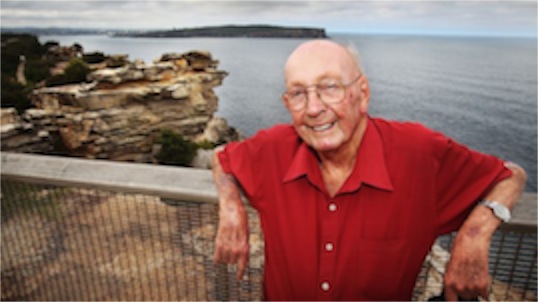 He repeated the process again and again. By some accounts, Ritchie is responsible for more than 500 successful suicide interventions. He may be the most successful suicide preventer in the world. His record rivals that of Chen Si, a man in China who is the unofficial lifeguard of the Nanjing Bridge. There is nothing flashy or special about Don Ritchie’s style. A smile can go a long way. Listening can go a long way farther. The offering of a cup of tea probably doesn’t hurt either.
He repeated the process again and again. By some accounts, Ritchie is responsible for more than 500 successful suicide interventions. He may be the most successful suicide preventer in the world. His record rivals that of Chen Si, a man in China who is the unofficial lifeguard of the Nanjing Bridge. There is nothing flashy or special about Don Ritchie’s style. A smile can go a long way. Listening can go a long way farther. The offering of a cup of tea probably doesn’t hurt either.
Too often the victims of mental illness feel isolated and cut off from the rest of the world. A simple gesture of caring and listening can make all the difference in the world. Ritchie was named a Local Hero in 2011 in the Australian of the Year Awards. MP Malcolm Turnbull called him “A true hero, one of our greatest Australians.” Don Ritchie joined the Australian Navy to become a hero of war. He ended up being a hero of peace. Saving 500 lives is no small matter.
Don Ritchie passed away peacefully yesterday in a Sydney hospital at the age of 86. A funeral will be held on Friday. His wife and three daughters survive him. So do hundreds of people whose lives he saved with a smile, a listening ear and, as the Australians say, “a cuppa.”
In honor of Mental Health Awareness Month, a coalition of agencies in Rapid City is putting together a public event on Thursday, May 24 at the Main Street Square in downtown Rapid City. There will be booths with mental health services information, local musicians, free food, a biodegradable balloon release and speakers including the mayor, the sheriff, and Amy Ivereson-Pollreisz, Deputy Secretary of Social Services for South Dakota. It will be a fun-filled time in a wonderful new public space. People who might not otherwise know of all of the wonderful treatment and prevention services in our area will have an opportunity to get information in a relaxed environment. There will be plenty of smiles, listening ears, and even folks who will sit down and share refreshments.
May has been Mental Health Awareness month for 63 years. Thousands of lives have been saved. There is still much more that needs to be done. Help us spread the news. We may not all be able to save 500 lives like Don Ritchie, but we each have the capacity to save one.

There are a lot of other illness and disease awareness months. Did you know that January is Thyroid Awareness Month? Trisomy Awareness Month is March. September is National Sickle Cell Month. January is National Glaucoma Awareness Month. Irritable Bowel Syndrome gets April.
You get the picture. We have a month for almost everything. In the midst of that, we sometimes forget that every one of those illnesses directly affects individuals and their families. These are serious matters to the victims of the illnesses. Raising awareness is one way to engage people in prevention and to advance research leading to better treatment. It is easy, however, for some illnesses to get lost in the mix.

Mental illness is surrounded by stigma and misinformation. The stigma is real. Mental illnesses are often seen as weaknesses. We wouldn’t think of telling someone with diabetes that their disease was a failing or character. We wouldn’t think of asking a cancer victim to “shake it off and get back to work.” But those things are routinely applied to the victims of mental illnesses. The misinformation is equally real. It is commonly believed that there is little effective treatment for mental illness. There are very effective strategies for treatment and prevention of mental illnesses. Treatment for clinical depression, for example, has a much higher success rate than treatment for heart disease. Yet far too many people fail to seek treatment because they either don’t know treatment is available or they fear talking with anyone about their symptoms because of societal attitudes.
So today, in honor of Mental Health Awareness Month, I want to salute a genuine hero and offer some information about a special event we are planning for our town.

Nearly 45 years ago, he made his first successful suicide intervention. He had no training, just the desire to save a life. He simply began to talk to the person standing on the ledge. His friendly smile and gentle manner was effective. He invited the person to his home for tea and conversation. All he did was listen. That was enough.

Too often the victims of mental illness feel isolated and cut off from the rest of the world. A simple gesture of caring and listening can make all the difference in the world. Ritchie was named a Local Hero in 2011 in the Australian of the Year Awards. MP Malcolm Turnbull called him “A true hero, one of our greatest Australians.” Don Ritchie joined the Australian Navy to become a hero of war. He ended up being a hero of peace. Saving 500 lives is no small matter.
Don Ritchie passed away peacefully yesterday in a Sydney hospital at the age of 86. A funeral will be held on Friday. His wife and three daughters survive him. So do hundreds of people whose lives he saved with a smile, a listening ear and, as the Australians say, “a cuppa.”
In honor of Mental Health Awareness Month, a coalition of agencies in Rapid City is putting together a public event on Thursday, May 24 at the Main Street Square in downtown Rapid City. There will be booths with mental health services information, local musicians, free food, a biodegradable balloon release and speakers including the mayor, the sheriff, and Amy Ivereson-Pollreisz, Deputy Secretary of Social Services for South Dakota. It will be a fun-filled time in a wonderful new public space. People who might not otherwise know of all of the wonderful treatment and prevention services in our area will have an opportunity to get information in a relaxed environment. There will be plenty of smiles, listening ears, and even folks who will sit down and share refreshments.
May has been Mental Health Awareness month for 63 years. Thousands of lives have been saved. There is still much more that needs to be done. Help us spread the news. We may not all be able to save 500 lives like Don Ritchie, but we each have the capacity to save one.

Copyright © 2012 by Ted Huffman. I wrote this. If you want to copy it, please ask for permission. There is a contact me button at the bottom of this page. If you want to share my blog a friend, please direct your friend to my web site.
Technology in Education
13/05/12 05:39
The impact of technology on childhood is a frequent topic of conversation. Like other toddlers, our grandson is more interested in “real” things than in toys. He has plenty of toys, selected carefully for their educational value. But his favorite play is engaging with and imitating his parents. It shouldn’t surprise them that he continually reaches for their cell phones. It shouldn’t surprise us as grandparents that his parents allow him to play with an old cell phone that no longer works. I remember that one of his father’s favorite toys when he was a toddler was a plastic play telephone. That telephone was carried around with the receiver held to his ear and sounds coming before his mouth before he knew very many words at all.
I suppose that these days, that toy telephone would be considered to be dangerous because of the cord that connected the handset with the base. It was too short to wrap around a child’s neck, but it might still be seen as dangerous. It isn’t a problem, because no on seems to use telephones with cords anymore. Like a rotary dial, this generation of children doesn’t understand the purpose of a wire connecting the headset with the base.
We are surrounded by technology. It is impossible to raise children without exposing them to its use. Still, there are dangers that come with our ultra-connected, high tech world. There is a lot on the Internet that is dangerous for children. They need to be taught to avoid Internet dangers as much as other dangers. Just as children require supervision when venturing out into traffic, they require supervision when connecting to the Internet. There is a regular stream of news stories of children who are victimized by predators who lurk on the Internet and use it to make connections. Stories of young children being exposed to pornography from friends’ cell phones and tablet devices are common.
 The Washington Post recently ran a piece by Cecilia Kang comparing two Washington D.C. area private schools. Flint School is ultra wired. Students are immersed in technology. Every preschooler has a iPad. Students all have MacBook Air computers starting in the fifth grade. Classrooms are decked out with touch-screen displays and powerful high speed Wi-Fi connections designed to handle all of the children being online at once.
The Washington Post recently ran a piece by Cecilia Kang comparing two Washington D.C. area private schools. Flint School is ultra wired. Students are immersed in technology. Every preschooler has a iPad. Students all have MacBook Air computers starting in the fifth grade. Classrooms are decked out with touch-screen displays and powerful high speed Wi-Fi connections designed to handle all of the children being online at once.
Less than 20 miles away the Washington Waldorf School is deliberately unplugged. The philosophy is that children are better taught by real-world experiences. The school has a vegetable garden and a woodworking shop. Students write by hand in hard-covered journals. There are chalkboards in the school. There is a ban on the use of cell phones, laptops and tablets. Students are required to hand-write all assignments until high school.
The two schools provide a stark contrast of philosophies. One believes that there is no rush to expose children to technology. They believe that children need to first relate to the physical world before being exposed to the virtual world of computers. The other believes that technology is all around us and that children need to start early to keep up in a competitive society.
There is a certain appeal to both of the schools. Neither would have been an option for our children, however. The $30,000+ per year price of such private schools is well beyond our means. The luxury of being able to pursue the purity of a specific educational philosophy is granted only to schools with generous budgets. Public schools have to contend with divers passions of a varied constituency and the limits of public funding.
 The role of technology in education is receiving mixed reviews in educational research. There are studies that demonstrate that children learn well when assisted by technological devises. A 2010 study, commissioned by PBS, demonstrated that children who use a smartphone application called “Martha Speaks” increased their vocabulary by as much as 31 percent in two weeks.
The role of technology in education is receiving mixed reviews in educational research. There are studies that demonstrate that children learn well when assisted by technological devises. A 2010 study, commissioned by PBS, demonstrated that children who use a smartphone application called “Martha Speaks” increased their vocabulary by as much as 31 percent in two weeks.
There have also been studies that show that early use of technology contributes to shortened attention spans. Another study demonstrates that students who use Google searches and Wikipedia as sources of information are less original in their thinking.
 It is a difficult choice for educators. Here in South Dakota we were very proud of state investment in wiring public schools. We had state-funded laptop programs in our schools while at the same time we had the lowest teacher salaries in the nation. The investment in technology had some short-term effects, but it did not turn out to be a wise long-term investment. Our state owns a lot of wire in an era of wireless communication. Like our son playing with a toy phone thirty years ago, we are left with wires that are no longer needed. The laptops were probably less than state-of-the-art when they were purchased. It only took a few years for them to become obsolete. The burst of funding purchased few long-term results.
It is a difficult choice for educators. Here in South Dakota we were very proud of state investment in wiring public schools. We had state-funded laptop programs in our schools while at the same time we had the lowest teacher salaries in the nation. The investment in technology had some short-term effects, but it did not turn out to be a wise long-term investment. Our state owns a lot of wire in an era of wireless communication. Like our son playing with a toy phone thirty years ago, we are left with wires that are no longer needed. The laptops were probably less than state-of-the-art when they were purchased. It only took a few years for them to become obsolete. The burst of funding purchased few long-term results.
It is always difficult to demonstrate direct relationships between funding and teaching. Despite continual studies and evaluations, teaching remains as much of an art as it is a science. The qualities that make for good teaching and learning are elusive and difficult to categorize.
All of the high-tech equipment and fancy software threatens to become the subject of education instead of its means. When computers first were introduced to education, schools set up computer labs. Students went to the labs for one of their classes to learn to use the computers. There were some elementary applications to teach reading, math, history and geography. Mostly computer lab time was the time to learn keyboarding skills and computer operation. That quickly faded. These days the students often know more about the operation of the technology than the teachers.
 Any educational technology can be misused. One of my elementary school friends found that out when he took a piece of chalk and wrote an inappropriate four-letter word on the chalkboard. In a sense the debate over the role of computers in education is already over. With more than 60% of children age 9 and older having cell phones, we already live in an ultra-connected generation.
Any educational technology can be misused. One of my elementary school friends found that out when he took a piece of chalk and wrote an inappropriate four-letter word on the chalkboard. In a sense the debate over the role of computers in education is already over. With more than 60% of children age 9 and older having cell phones, we already live in an ultra-connected generation.
The challenge is to learn and to teach how to use the technology for good.
I suppose that these days, that toy telephone would be considered to be dangerous because of the cord that connected the handset with the base. It was too short to wrap around a child’s neck, but it might still be seen as dangerous. It isn’t a problem, because no on seems to use telephones with cords anymore. Like a rotary dial, this generation of children doesn’t understand the purpose of a wire connecting the headset with the base.
We are surrounded by technology. It is impossible to raise children without exposing them to its use. Still, there are dangers that come with our ultra-connected, high tech world. There is a lot on the Internet that is dangerous for children. They need to be taught to avoid Internet dangers as much as other dangers. Just as children require supervision when venturing out into traffic, they require supervision when connecting to the Internet. There is a regular stream of news stories of children who are victimized by predators who lurk on the Internet and use it to make connections. Stories of young children being exposed to pornography from friends’ cell phones and tablet devices are common.

Less than 20 miles away the Washington Waldorf School is deliberately unplugged. The philosophy is that children are better taught by real-world experiences. The school has a vegetable garden and a woodworking shop. Students write by hand in hard-covered journals. There are chalkboards in the school. There is a ban on the use of cell phones, laptops and tablets. Students are required to hand-write all assignments until high school.
The two schools provide a stark contrast of philosophies. One believes that there is no rush to expose children to technology. They believe that children need to first relate to the physical world before being exposed to the virtual world of computers. The other believes that technology is all around us and that children need to start early to keep up in a competitive society.
There is a certain appeal to both of the schools. Neither would have been an option for our children, however. The $30,000+ per year price of such private schools is well beyond our means. The luxury of being able to pursue the purity of a specific educational philosophy is granted only to schools with generous budgets. Public schools have to contend with divers passions of a varied constituency and the limits of public funding.

There have also been studies that show that early use of technology contributes to shortened attention spans. Another study demonstrates that students who use Google searches and Wikipedia as sources of information are less original in their thinking.

It is always difficult to demonstrate direct relationships between funding and teaching. Despite continual studies and evaluations, teaching remains as much of an art as it is a science. The qualities that make for good teaching and learning are elusive and difficult to categorize.
All of the high-tech equipment and fancy software threatens to become the subject of education instead of its means. When computers first were introduced to education, schools set up computer labs. Students went to the labs for one of their classes to learn to use the computers. There were some elementary applications to teach reading, math, history and geography. Mostly computer lab time was the time to learn keyboarding skills and computer operation. That quickly faded. These days the students often know more about the operation of the technology than the teachers.

The challenge is to learn and to teach how to use the technology for good.
Copyright © 2012 by Ted Huffman. I wrote this. If you want to copy it, please ask for permission. There is a contact me button at the bottom of this page. If you want to share my blog a friend, please direct your friend to my web site.
Delivering Difficult News
12/05/12 04:17
Sometimes I marvel at the wonders of modern technology. At least once a week we connect with our children using our computers for video conferencing. We can speak and see their faces at the same time. They often carry their computers around the room or outside to show us what is going on in their world. We can even share “Facetime” conversations with video over our cell phones.
We live in a world of instant communications. Last week when there was a fire in our neighborhood, I immediately checked out the news updates on my cell phone while listening to fire dispatch on a scanner radio. It didn’t work perfectly. We watched quite a bit of action before the news crew arrived on scene to post updates to the phone network. Nonetheless there were pictures of the fire available on the computer within a few hours.
The world wasn’t always this way. Events of family life were reported in letters for generations and until relatively recently letters took a long time to reach their destination. We are the first generation to think that writing a letter, affixing a stamp to an addressed envelope and expecting it to be hand-delivered within 2 or 3 days is “too slow.” In 1974, when we moved to Chicago from Montana, long distance telephone charges were 22cents per minute. We limited ourselves to one phone call per week and limited that call to five minutes. Our children have no sense of limits to the number of phone calls or the amount of time. They and we have calling plans that offer unlimited long distance. There is no extra charge unless we call outside of the United States. And we do that routinely by using our computers. With voice over Internet technology, we speak to Australia without extra cost.
We think of this as progress. And perhaps it is. But it does have its down side as well. Last year I was attending a meeting and received a text message. The message asked me to be prepared because there was a traumatic incident in our town that involved a shooting. After the meeting, as I drove by the hospital, I saw the ambulance and law enforcement vehicles just arriving. I was not using my scanner radio. I was not on call for official duties. I was just an ordinary citizen, and I was informed about a shooting with a possible death before the victim reached the hospital – before death had been declared. The events didn’t unfold in the right order.
We have become used to events as occurred last week in our town, when a motorcyclist was killed in an accident. There was a picture on a web site and in the newspaper showing the motorcycle and the vehicle that struck it before notification had been made to family members.
A third example: Within the last few months a colleague and I were on official duties working in partnership with the Sheriff’s office assisting a family who had experienced an unexpected death. One of the dynamics in the family is that there were children of various ages. We worked together to make a plan to notify each child individually with the parent and another adult bringing the news individually. The children were at two different after school locations, so the logistics took a few minutes to work out and the parent needed some resources and some instruction to assist with the difficult duty. After we had made a plan, my colleague and I went to the cab of my pickup for a moment to reflect on what had occurred and discuss the next steps that needed to be taken. We took a look at the news headlines on a cell phone and the name of the victim and the cause of death were already posted on the newspaper website – before family notifications had taken place.
Instant communication can be a dangerous thing. Many years ago, a tradition that formed in Europe became common in rural areas in America. In Tudor England it was called a “passing bell” or “soul bell.” The bell was rung with short pauses between rings. It notified the village that a death had occurred. In some places the tones and pauses also provided clues for listeners as to which person had died. In the days before newspapers, telephones or other means of fast conveyance existed, a funeral notice was posted in the window of a business. Passersby would read of the death and make arrangements to acknowledge the family’s loss. These notifications, however, went out only after close family members had been notified.
Law enforcement agencies, the military, fire departments, medical personnel and ministers are all called upon at times to make notification that a death has occurred. We have had the experience of being called in the middle of the night and given the task of delivering difficult news to others. We are aware of how traumatic the experience can be. We’ve been trained in grief and in care of those who are grieving. We know how inappropriate information or actions can make the grieving process more difficult for survivors. There are protocols and procedures that we follow that have been carefully crafted to assist families and individuals in these difficult times. But these notifications take time. They are not instant. I know of a fire department where the protocol manual calls for the news to be delivered by an officer of the department, preferably one who witnessed or has first-hand knowledge of the incident. This officer should appear with at least one other member of the fire department in dress uniform. The protocol assumes that the firemen will finish putting out the fire, go back to the station and change their clothes, and then deliver the news.
In an age of cell phones and instant messaging that means that the family could already have a picture of their loved one being loaded into the coroner’s car before the officers arrive.
All across our country, we are in a process of revising procedures and protocols and trying to come up with ways to deliver news more quickly. We remain convinced that how news is delivered is very important. It can ease the pain for survivors if they receive first-hand information delivered in person. It is important that the process of notification not create additional bad memories for those who have already had a deep loss.
Yesterday at yet another meeting we discussed the matter without coming up with solutions. We have already sped up our response time to less than 15 minutes. But in a county as large as ours there can be drive times of up to an hour for some distant locations. Clearly there needs to be ethical training for the newspaper and television reporters and editors. Now we also need pubic education about the appropriate use of social media and technology.
Research indicates that when death notification is poorly handled, survivors suffer consequences. Leaving survivors with lingering unanswered questions relating to the death of a loved one contributes to emotional difficulties and, in some cases, psychological illness. As a community, we need to re-think how we handle this important news. Those of us who carry special responsibility as the bearers of bad news must become advocates for those who receive our news. Those who attempt to deliver the news without proper training or understanding need to be made aware of the pain they might cause.
In this time of changing technologies, we still have much to learn.
We live in a world of instant communications. Last week when there was a fire in our neighborhood, I immediately checked out the news updates on my cell phone while listening to fire dispatch on a scanner radio. It didn’t work perfectly. We watched quite a bit of action before the news crew arrived on scene to post updates to the phone network. Nonetheless there were pictures of the fire available on the computer within a few hours.
The world wasn’t always this way. Events of family life were reported in letters for generations and until relatively recently letters took a long time to reach their destination. We are the first generation to think that writing a letter, affixing a stamp to an addressed envelope and expecting it to be hand-delivered within 2 or 3 days is “too slow.” In 1974, when we moved to Chicago from Montana, long distance telephone charges were 22cents per minute. We limited ourselves to one phone call per week and limited that call to five minutes. Our children have no sense of limits to the number of phone calls or the amount of time. They and we have calling plans that offer unlimited long distance. There is no extra charge unless we call outside of the United States. And we do that routinely by using our computers. With voice over Internet technology, we speak to Australia without extra cost.
We think of this as progress. And perhaps it is. But it does have its down side as well. Last year I was attending a meeting and received a text message. The message asked me to be prepared because there was a traumatic incident in our town that involved a shooting. After the meeting, as I drove by the hospital, I saw the ambulance and law enforcement vehicles just arriving. I was not using my scanner radio. I was not on call for official duties. I was just an ordinary citizen, and I was informed about a shooting with a possible death before the victim reached the hospital – before death had been declared. The events didn’t unfold in the right order.
We have become used to events as occurred last week in our town, when a motorcyclist was killed in an accident. There was a picture on a web site and in the newspaper showing the motorcycle and the vehicle that struck it before notification had been made to family members.
A third example: Within the last few months a colleague and I were on official duties working in partnership with the Sheriff’s office assisting a family who had experienced an unexpected death. One of the dynamics in the family is that there were children of various ages. We worked together to make a plan to notify each child individually with the parent and another adult bringing the news individually. The children were at two different after school locations, so the logistics took a few minutes to work out and the parent needed some resources and some instruction to assist with the difficult duty. After we had made a plan, my colleague and I went to the cab of my pickup for a moment to reflect on what had occurred and discuss the next steps that needed to be taken. We took a look at the news headlines on a cell phone and the name of the victim and the cause of death were already posted on the newspaper website – before family notifications had taken place.
Instant communication can be a dangerous thing. Many years ago, a tradition that formed in Europe became common in rural areas in America. In Tudor England it was called a “passing bell” or “soul bell.” The bell was rung with short pauses between rings. It notified the village that a death had occurred. In some places the tones and pauses also provided clues for listeners as to which person had died. In the days before newspapers, telephones or other means of fast conveyance existed, a funeral notice was posted in the window of a business. Passersby would read of the death and make arrangements to acknowledge the family’s loss. These notifications, however, went out only after close family members had been notified.
Law enforcement agencies, the military, fire departments, medical personnel and ministers are all called upon at times to make notification that a death has occurred. We have had the experience of being called in the middle of the night and given the task of delivering difficult news to others. We are aware of how traumatic the experience can be. We’ve been trained in grief and in care of those who are grieving. We know how inappropriate information or actions can make the grieving process more difficult for survivors. There are protocols and procedures that we follow that have been carefully crafted to assist families and individuals in these difficult times. But these notifications take time. They are not instant. I know of a fire department where the protocol manual calls for the news to be delivered by an officer of the department, preferably one who witnessed or has first-hand knowledge of the incident. This officer should appear with at least one other member of the fire department in dress uniform. The protocol assumes that the firemen will finish putting out the fire, go back to the station and change their clothes, and then deliver the news.
In an age of cell phones and instant messaging that means that the family could already have a picture of their loved one being loaded into the coroner’s car before the officers arrive.
All across our country, we are in a process of revising procedures and protocols and trying to come up with ways to deliver news more quickly. We remain convinced that how news is delivered is very important. It can ease the pain for survivors if they receive first-hand information delivered in person. It is important that the process of notification not create additional bad memories for those who have already had a deep loss.
Yesterday at yet another meeting we discussed the matter without coming up with solutions. We have already sped up our response time to less than 15 minutes. But in a county as large as ours there can be drive times of up to an hour for some distant locations. Clearly there needs to be ethical training for the newspaper and television reporters and editors. Now we also need pubic education about the appropriate use of social media and technology.
Research indicates that when death notification is poorly handled, survivors suffer consequences. Leaving survivors with lingering unanswered questions relating to the death of a loved one contributes to emotional difficulties and, in some cases, psychological illness. As a community, we need to re-think how we handle this important news. Those of us who carry special responsibility as the bearers of bad news must become advocates for those who receive our news. Those who attempt to deliver the news without proper training or understanding need to be made aware of the pain they might cause.
In this time of changing technologies, we still have much to learn.
Copyright © 2012 by Ted Huffman. I wrote this. If you want to copy it, please ask for permission. There is a contact me button at the bottom of this page. If you want to share my blog a friend, please direct your friend to my web site.
Meetings and magazines
11/05/12 05:03
I suppose that it is only natural for people who have an interest to seek out others who share their interest. The things that I have enjoyed in life often have clubs or associations of others who enjoy the same activities. My friends all know that I like to build and paddle canoes and kayaks. We have a “fleet” of four canoes and three kayaks. One was purchased. One was a major restoration. The others were built from scratch in our garage. I enjoy both the process of building and the process of paddling. Paddling came first. I built my first canoe simply because a purchased canoe didn’t fit into our family’s budget. I found that I enjoyed the building as well as the paddling.
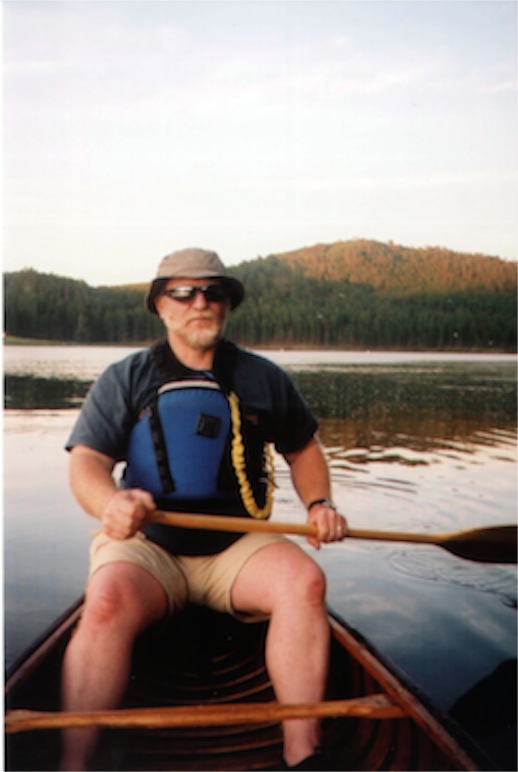 There are a lot of organizations that a paddler can join. The American Canoe Association (ACA) has been around for a long time. They have been the keepers of the standards for training and safety on the water. I belonged to the ACA for many years. I have never participated in local chapter activities except for training events. In recent years the ACA has expanded. They rarely use the word “canoe” in their promotional materials unless they also include, kayak, SUP (a technique for using a paddle to propel a surf board), and raft. They are trying to be the single source for all paddle sports. This has resulted in watering down the canoe emphasis that used to be a part of the group. The other thing that has occurred is that the organization has gotten very involved in public policy and advocacy. Some of the dues go to lobbying and influencing public policy. Although I often agree with the positions of the organization, I am not a big fan of lobbying or having someone else try to speak on my behalf. The ACA has several magazines: Canoeroots, Adventure Kayak, Rapid, and Kayak Angler.
There are a lot of organizations that a paddler can join. The American Canoe Association (ACA) has been around for a long time. They have been the keepers of the standards for training and safety on the water. I belonged to the ACA for many years. I have never participated in local chapter activities except for training events. In recent years the ACA has expanded. They rarely use the word “canoe” in their promotional materials unless they also include, kayak, SUP (a technique for using a paddle to propel a surf board), and raft. They are trying to be the single source for all paddle sports. This has resulted in watering down the canoe emphasis that used to be a part of the group. The other thing that has occurred is that the organization has gotten very involved in public policy and advocacy. Some of the dues go to lobbying and influencing public policy. Although I often agree with the positions of the organization, I am not a big fan of lobbying or having someone else try to speak on my behalf. The ACA has several magazines: Canoeroots, Adventure Kayak, Rapid, and Kayak Angler.
As a builder and restorer of wooden canoes, I belong to the Wooden Canoe Heritage Association. They have a beautiful magazine that is probably worth the price of membership because the advertisers sell the kind of boatbuilding supplies I have trouble finding in our area. This year, members of the WCHA received a free one-year membership in the Antique and Classic Boat Society. That means another magazine coming to our house. If I joined all of the organizations that promote paddlesports, I would end up with a house filled with unread magazines. I do receive Wooden Boat, another magazine aimed at boat builders.
There are a lot of other organizations that one could join if one wanted a place to belong. Here in Rapid City, we have the Black Hills Paddlers. It is a kind of loose knit group that focuses mostly on having fun and connecting with other paddlers. I am on their e-mail list. I don’t know if they even have an official membership list or dues.
The point is that there are some people who enjoy the social functions, meetings, organizations, t-shirts, stickers, coffee mugs, hats and other schwag. There are others who would rather just go paddling. I guess I fall into the later category. What is more, I paddle mostly for the solitude. I paddle to get away from crowds not to engage in social activities.
 So the answer is “No, I am not going to paddle in the South Dakota Kayak Challenge on Memorial Day weekend.” There isn’t much about it in the news on our end of the state, but it is a big deal with paddlers in the eastern end of our state. Basically it is a 72-mile endurance paddle from Yankton, SD to Sioux City, IA. Registered paddlers are allowed 30 hours to complete the course. The fastest of paddlers might complete the course in 10 hours if the weather cooperates. The first race was held in 2010. The 2011 race was cancelled. Weather and very high releases from Missouri River dams made the course dangerous. So the race is back this year.
So the answer is “No, I am not going to paddle in the South Dakota Kayak Challenge on Memorial Day weekend.” There isn’t much about it in the news on our end of the state, but it is a big deal with paddlers in the eastern end of our state. Basically it is a 72-mile endurance paddle from Yankton, SD to Sioux City, IA. Registered paddlers are allowed 30 hours to complete the course. The fastest of paddlers might complete the course in 10 hours if the weather cooperates. The first race was held in 2010. The 2011 race was cancelled. Weather and very high releases from Missouri River dams made the course dangerous. So the race is back this year.
I don’t actually understand marathon canoe or kayak races. I am not very interested in competing with other paddlers. Nature hands me enough challenges to keep me engaged. And, the cynic in me says that it is a typically Midwestern sensibility to call the race the South Dakota Kayak Challenge. If one really wanted to win, I think a racing canoe might be the fastest boat. And the course runs through Nebraska and Iowa. So, it would be possible to win without ever getting into a kayak and spending most of your time out of the state of South Dakota. We’re sort of like that. We don’t always say what we mean.
So I have mixed feelings about all of the associations, clubs and organizations that surround paddling. As much as I love canoes and kayaks and paddling, I don’t want to spend all of my time with other paddlers.
The center of my life is a community. The church gathers people with diverse interests. We are not all the same. I am continually amazed at the wide diversity of interests in our church. We have car enthusiasts, people who love camping, those who love international travel, quilters, bikers, motorcyclists, antique enthusiasts, and a thousand other interests. I am frequently surprised by a new hobby or interest when I sit with folks from our church.
Furthermore, in a congregation like ours, there is a wide range of belief and Christian practice. We are not bound together by having to be all the same. We have traditionalists and new age thinkers. We have people who prefer ancient liturgies and those who are more moved by brand new prayers and songs. We are capable of spirited discussion about books and beliefs. We have folks who joined the church because of our mission activities and folks who joined our church to sing in the choir.
The bottom line is that I am not very interested in getting together with people who agree on everything. I find it far more interesting to be with a wonderfully diverse congregation.
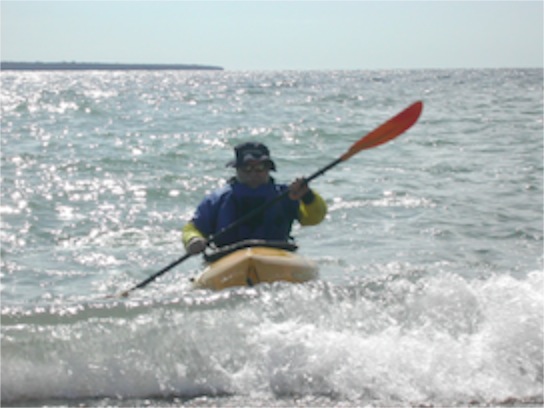 So, if you’d like to talk paddling with me, catch me at the fellowship hour after church. I’m probably not going to be at a paddler’s meeting.
So, if you’d like to talk paddling with me, catch me at the fellowship hour after church. I’m probably not going to be at a paddler’s meeting.

As a builder and restorer of wooden canoes, I belong to the Wooden Canoe Heritage Association. They have a beautiful magazine that is probably worth the price of membership because the advertisers sell the kind of boatbuilding supplies I have trouble finding in our area. This year, members of the WCHA received a free one-year membership in the Antique and Classic Boat Society. That means another magazine coming to our house. If I joined all of the organizations that promote paddlesports, I would end up with a house filled with unread magazines. I do receive Wooden Boat, another magazine aimed at boat builders.
There are a lot of other organizations that one could join if one wanted a place to belong. Here in Rapid City, we have the Black Hills Paddlers. It is a kind of loose knit group that focuses mostly on having fun and connecting with other paddlers. I am on their e-mail list. I don’t know if they even have an official membership list or dues.
The point is that there are some people who enjoy the social functions, meetings, organizations, t-shirts, stickers, coffee mugs, hats and other schwag. There are others who would rather just go paddling. I guess I fall into the later category. What is more, I paddle mostly for the solitude. I paddle to get away from crowds not to engage in social activities.

I don’t actually understand marathon canoe or kayak races. I am not very interested in competing with other paddlers. Nature hands me enough challenges to keep me engaged. And, the cynic in me says that it is a typically Midwestern sensibility to call the race the South Dakota Kayak Challenge. If one really wanted to win, I think a racing canoe might be the fastest boat. And the course runs through Nebraska and Iowa. So, it would be possible to win without ever getting into a kayak and spending most of your time out of the state of South Dakota. We’re sort of like that. We don’t always say what we mean.
So I have mixed feelings about all of the associations, clubs and organizations that surround paddling. As much as I love canoes and kayaks and paddling, I don’t want to spend all of my time with other paddlers.
The center of my life is a community. The church gathers people with diverse interests. We are not all the same. I am continually amazed at the wide diversity of interests in our church. We have car enthusiasts, people who love camping, those who love international travel, quilters, bikers, motorcyclists, antique enthusiasts, and a thousand other interests. I am frequently surprised by a new hobby or interest when I sit with folks from our church.
Furthermore, in a congregation like ours, there is a wide range of belief and Christian practice. We are not bound together by having to be all the same. We have traditionalists and new age thinkers. We have people who prefer ancient liturgies and those who are more moved by brand new prayers and songs. We are capable of spirited discussion about books and beliefs. We have folks who joined the church because of our mission activities and folks who joined our church to sing in the choir.
The bottom line is that I am not very interested in getting together with people who agree on everything. I find it far more interesting to be with a wonderfully diverse congregation.

Copyright © 2012 by Ted Huffman. I wrote this. If you want to copy it, please ask for permission. There is a contact me button at the bottom of this page. If you want to share my blog a friend, please direct your friend to my web site.
Coming into Focus
10/05/12 05:23
38 years ago, when I was a college student, I was asked to serve for a few months as a supply pastor in a nearby town. I knew that I was heading to theological seminary and it seemed like an opportunity to test my skills as a preacher and to learn about leading worship. In a sense, I have been doing so ever since. I had internships during my seminary years and since graduation from seminary, I have been responsible for weekly worship. I’ve been leading worship for so many years that it has grown beyond a job I do into a way of life. My life revolves around the days of the week. Weekly bible study with colleagues, weekly staff meetings to coordinate worship plans and rising early on Sunday mornings are all so ingrained into my life that I can’t quite imagine life without those elements.
As a result, I live inside of the cycle of the lectionary. I know many of the readings like old friends. I can remember other sermons I have preached in other places. My life does more that just go through the motions of Advent, Christmas, Epiphany, Lent, Easter, and Pentecost. I feel the movement of the year through the seasons of the church. I anticipate coming seasons and think of how worship might be planned for weeks and sometimes entire seasons in advance.
Sometimes I forget that it is not this way for other people. Sometimes I forget that it wasn’t always this way for me. I didn’t always know how the lectionary works. When I was a high school student, I didn’t have much sense of the significance of Pentecost or Reign of Christ or Reformation Sunday. I attended church, but in some ways one worship service seemed as good as another. I had opinions about which music I liked and which I did not, but I didn’t have a sense of how music and scripture could be coordinated to deepen the experience of worship. These were things that I had to learn. I wasn’t expert when I graduated from seminary. Actually I still don’t feel like I am expert, but I have a sense of how thing work in a deeper way than just what I like and dislike.
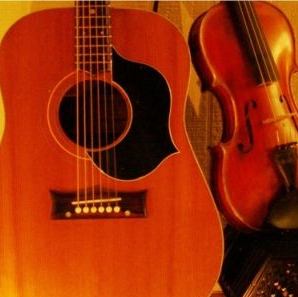 Worship is very important to me. I work hard at worship. I cringe when I catch myself criticizing worship led by another. I am critical of what appears to me to be a lack of preparation. I am critical of misspoken words and awkward transitions.
Worship is very important to me. I work hard at worship. I cringe when I catch myself criticizing worship led by another. I am critical of what appears to me to be a lack of preparation. I am critical of misspoken words and awkward transitions.
God, I am convinced, is much less critical of our human mistakes. God would prefer for me to simply participate in worship rather than analyze it. And I would prefer that as well.
All of this said, I was a bit frustrated last night as I worked with a team of youth and adults in preparation for worship this coming Sunday. I am used to the elements of worship being in place on Tuesday. They wanted to add new songs and changing the timing of the service last night. I am used to having carefully thought about how different elements of worship fit together. They wanted to have all of their favorite things in this service without much concern about order or coordination.
 I began to feel like I do when I visit the eye doctor and am asked to strain to make out what appear to me to be fuzzy letters on a distant wall. Some of the letters are clear and easy. Some cannot be brought into focus with my best effort. Last night’s rehearsal felt foggy and out of focus.
I began to feel like I do when I visit the eye doctor and am asked to strain to make out what appear to me to be fuzzy letters on a distant wall. Some of the letters are clear and easy. Some cannot be brought into focus with my best effort. Last night’s rehearsal felt foggy and out of focus.
I kept trying to remind participants of the gospel reading for the week, to call them back into focus. They kept investing their creative energies in suggesting new ideas and new ways to do things. When a song was difficult to learn, I wanted to put it off for a later date. They wanted to work out their own arrangement and go ahead with the song. We seemed to be pulling in different directions.
This morning I know that last night clearly illustrates one of my growing edges. I can be too concerned with control in worship. I have strong ideas and I want things to work according to my plan. Worship in a large and diverse congregation is not subject to hierarchical control. It demands that multiple people participate and offer their ideas. It demands surrendering control more than seizing it.
The old lesson comes clear again. This isn’t about me. I am not the center of the universe. I am not even the center of the experience of worship. In corporate worship we stand together before God.
My irritation, though short-lived, was misplaced. I should have been deeply grateful for the investment of youth in worship leadership. I should have been deeply grateful for the signs of religious imagination that brought new ideas and new possibilities to our time together. I should have been deeply grateful for the energy of new leaders emerging. I should have been shouting, “Yes!” instead of saying, “I don’t know.”
 As long as I have been leading worship, I still have a great deal to learn about how worship works. One of our planning documents sets the goal of providing “worship that is as diverse as the people we serve.” The strategies outlined under that goal have primarily to do with identifiable genres of music. Jazz, gospel, contemporary and traditional are listed. Some of those have more specific meanings in our congregation than they might appear. When we say “traditional,” we are referring in part to the use of one of our older hymnals. The hymns in that hymnal, while familiar and wonderful, are a limited selection. There are virtually no gospel hymns in that hymnal. Other churches might think that “Amazing Grace,” and “How Great Thou Art” are traditional hymns. In our church we have to use our “new” hymnal to sing those hymns. They aren’t in the “old” hymnal. On the other hand, when we say “contemporary,” we are never quite sure what we mean. For some in our congregation that means using guitars instead of the organ. For others it means folk music. For others it means rock music.
As long as I have been leading worship, I still have a great deal to learn about how worship works. One of our planning documents sets the goal of providing “worship that is as diverse as the people we serve.” The strategies outlined under that goal have primarily to do with identifiable genres of music. Jazz, gospel, contemporary and traditional are listed. Some of those have more specific meanings in our congregation than they might appear. When we say “traditional,” we are referring in part to the use of one of our older hymnals. The hymns in that hymnal, while familiar and wonderful, are a limited selection. There are virtually no gospel hymns in that hymnal. Other churches might think that “Amazing Grace,” and “How Great Thou Art” are traditional hymns. In our church we have to use our “new” hymnal to sing those hymns. They aren’t in the “old” hymnal. On the other hand, when we say “contemporary,” we are never quite sure what we mean. For some in our congregation that means using guitars instead of the organ. For others it means folk music. For others it means rock music.
 Still it is a wonderful goal and we are pursuing it, even if we are sometimes unfocused. And worship isn’t about my comfort level. It is about the people and the God we serve.
Still it is a wonderful goal and we are pursuing it, even if we are sometimes unfocused. And worship isn’t about my comfort level. It is about the people and the God we serve.
I really am looking forward to Sunday worship. And I am grateful that I have a couple more nights to sleep on it before Sunday comes.
As a result, I live inside of the cycle of the lectionary. I know many of the readings like old friends. I can remember other sermons I have preached in other places. My life does more that just go through the motions of Advent, Christmas, Epiphany, Lent, Easter, and Pentecost. I feel the movement of the year through the seasons of the church. I anticipate coming seasons and think of how worship might be planned for weeks and sometimes entire seasons in advance.
Sometimes I forget that it is not this way for other people. Sometimes I forget that it wasn’t always this way for me. I didn’t always know how the lectionary works. When I was a high school student, I didn’t have much sense of the significance of Pentecost or Reign of Christ or Reformation Sunday. I attended church, but in some ways one worship service seemed as good as another. I had opinions about which music I liked and which I did not, but I didn’t have a sense of how music and scripture could be coordinated to deepen the experience of worship. These were things that I had to learn. I wasn’t expert when I graduated from seminary. Actually I still don’t feel like I am expert, but I have a sense of how thing work in a deeper way than just what I like and dislike.

God, I am convinced, is much less critical of our human mistakes. God would prefer for me to simply participate in worship rather than analyze it. And I would prefer that as well.
All of this said, I was a bit frustrated last night as I worked with a team of youth and adults in preparation for worship this coming Sunday. I am used to the elements of worship being in place on Tuesday. They wanted to add new songs and changing the timing of the service last night. I am used to having carefully thought about how different elements of worship fit together. They wanted to have all of their favorite things in this service without much concern about order or coordination.

I kept trying to remind participants of the gospel reading for the week, to call them back into focus. They kept investing their creative energies in suggesting new ideas and new ways to do things. When a song was difficult to learn, I wanted to put it off for a later date. They wanted to work out their own arrangement and go ahead with the song. We seemed to be pulling in different directions.
This morning I know that last night clearly illustrates one of my growing edges. I can be too concerned with control in worship. I have strong ideas and I want things to work according to my plan. Worship in a large and diverse congregation is not subject to hierarchical control. It demands that multiple people participate and offer their ideas. It demands surrendering control more than seizing it.
The old lesson comes clear again. This isn’t about me. I am not the center of the universe. I am not even the center of the experience of worship. In corporate worship we stand together before God.
My irritation, though short-lived, was misplaced. I should have been deeply grateful for the investment of youth in worship leadership. I should have been deeply grateful for the signs of religious imagination that brought new ideas and new possibilities to our time together. I should have been deeply grateful for the energy of new leaders emerging. I should have been shouting, “Yes!” instead of saying, “I don’t know.”


I really am looking forward to Sunday worship. And I am grateful that I have a couple more nights to sleep on it before Sunday comes.
Copyright © 2012 by Ted Huffman. I wrote this. If you want to copy it, please ask for permission. There is a contact me button at the bottom of this page. If you want to share my blog a friend, please direct your friend to my web site.
Beyond Where the Wild Things Are
09/05/12 05:37
From time to time I write about famous people on the occasion of their death. I know that this is a somewhat strange investment of time and energy because there are already plenty of obituaries that will garner a much wider readership than mine. But when public figure dies, in a way, it is a grief that is spread out more than is the case in the deaths of others. This is not to downplay the real grief experienced by family and friends, but rather to say that there are more of us who experience the loss.
 I am genuinely sad a the news that Maurice Sendak has died. I know that he was 83 years old. I know that he had a stroke. I know that he was not likely to produce any more wonderful books for children. Bumble-Ardy, published in September will be his last book. It was a bonus, coming 30 years after the previous book for which he produced both text and illustrations. It is the story of an orphaned pig who gives himself a wonderful birthday party. Like Sendak’s other books, it combines joy with a dose of reality and even explores fear. The story’s main character became an orphan because his parents were eaten. There are very few children’s story authors with the courage to tackle tough subjects such as where the bacon really comes from.
I am genuinely sad a the news that Maurice Sendak has died. I know that he was 83 years old. I know that he had a stroke. I know that he was not likely to produce any more wonderful books for children. Bumble-Ardy, published in September will be his last book. It was a bonus, coming 30 years after the previous book for which he produced both text and illustrations. It is the story of an orphaned pig who gives himself a wonderful birthday party. Like Sendak’s other books, it combines joy with a dose of reality and even explores fear. The story’s main character became an orphan because his parents were eaten. There are very few children’s story authors with the courage to tackle tough subjects such as where the bacon really comes from.

Like other greats who take children seriously, Sendak did not shy away from the troubles of childhood. To be sure, he captured freedom, boundless energy, possibilities, fantasies and imagination. But he also reminds adults that childhood is far from easy, filled with frustrations, fear, loneliness and confusion.

Sendak lets us know that sometimes it is OK to be a wild thin. Lots of kids want to escape when they are in trouble. Sendak gives us Max, who does escape, has wild adventures, and, in the end, gets to return to his home. And the best part is that his supper Is still warm.
Anyone who wants to understand childhood and children ought to read “Where the Wild Things Are” more than once.
Reading the book out loud is one of the deepest joys of being a parent – and a privilege that is afforded to grandparents as well.
Our world is rapidly changing. Books are being replaced by e-readers and other methods of distribution. A good e-reader can display the words accurately. It can give clear and crisp illustrations. It can even provide animation. But it does not stir the imagination the way listening to a story being read by someone you love. There are times when too much information limits the imagination. Sendak’s illustrations are soft and dreamy with subdued colors and fanciful images that invite one to think beyond the picture. The pen and ink drawings show a boy with a tail or a room with trees on the inside and make us to wonder what a tail might feel like and how one would go to sleep with leaves overhead while still having the security of a door that closes and your own familiar bed. A horn blasting so loud that the baby files into the air is less terrifying than silly, when captured in a drawing. The same scene in an animated cartoon would go by too quickly. Sendak’s drawing leaves the baby suspended in mid-air so that we can contemplate what comes next instead of having it given to us.
I believe that Senak really believed in children. He believed that they were more complex than is often attributed. He believed that they posses real courage and the ability to face life’s difficulties. He believed that they could grow, and he provided books that encouraged that growth.
Maybe that is why children want his books to be read again and again. I think that a parent might be asked to read “Where the Wild Things Are” perhaps 269 times to a single child changes the request to another book. Smart parents read the book that many times. They not only memorize it, they allow the book to become a member of the family. You see, the book is true. Tangled forests, a wild sea and fanged monsters really do lurk in our imaginations. But they need not be feared if we develop the ability to look them directly in their eyes. Max becomes the king of all wild things and so can our children. And the dance party of the monsters is a classic of all literature as wonderful as the dog tree party at the end of “Go Dog Go.”
 Sendak doesn’t run away from the anger of a child. He runs with it. And in doing so his story tells us more about ourselves than we would otherwise know. Compared to the price of years of psychoanalysis, the book is a bargain. $10.77 at amazon.com can’t be beat. Parents who allow the television set to care for their children will never know what they are missing. Max knows. He gets to come back home. He gets to grow beyond his anger. He overcomes it to come back into relationship. And when he gets there his supper is still warm.
Sendak doesn’t run away from the anger of a child. He runs with it. And in doing so his story tells us more about ourselves than we would otherwise know. Compared to the price of years of psychoanalysis, the book is a bargain. $10.77 at amazon.com can’t be beat. Parents who allow the television set to care for their children will never know what they are missing. Max knows. He gets to come back home. He gets to grow beyond his anger. He overcomes it to come back into relationship. And when he gets there his supper is still warm.
Sendak didn’t miss a detail in the book.
So I am a bit sad today after hearing the news yesterday. We have lost a truly great mind.
But then again, perhaps we haven’t lost it at all. Maurice Sendak poured so much of himself into his books that we still have him as long as we are willing to take time to read the book to a child. By the way, if you are an adult tempted to just go to the library or the bookstore alone, I strongly recommend finding a child with whom to share the experience. Reading it to yourself falls far short of experiencing the richness of this book. It is best when there is a child to join you in growling and howling at the moon.
 Perhaps today is a good day to think about death – maybe even a good day to talk about death with a child. After all, we do not fully know the nature of death. We do not fully understand the mystery of what lies beyond. To even consider such a reality demands our imagination.
Perhaps today is a good day to think about death – maybe even a good day to talk about death with a child. After all, we do not fully know the nature of death. We do not fully understand the mystery of what lies beyond. To even consider such a reality demands our imagination.
And imagination is what Sendak taught us best.
Thank you for all of the good reads, Maurice Sendak. Let’s see 25 or 30 books each read 269 times to two children. And now we have a grandson. Perhaps we will have other grandchildren. Our nieces and nephews are starting to get to be the age to become parents . . . there is a lifetime of reading to children that still lies ahead.
I know I won’t get bored.


Like other greats who take children seriously, Sendak did not shy away from the troubles of childhood. To be sure, he captured freedom, boundless energy, possibilities, fantasies and imagination. But he also reminds adults that childhood is far from easy, filled with frustrations, fear, loneliness and confusion.

Sendak lets us know that sometimes it is OK to be a wild thin. Lots of kids want to escape when they are in trouble. Sendak gives us Max, who does escape, has wild adventures, and, in the end, gets to return to his home. And the best part is that his supper Is still warm.
Anyone who wants to understand childhood and children ought to read “Where the Wild Things Are” more than once.
Reading the book out loud is one of the deepest joys of being a parent – and a privilege that is afforded to grandparents as well.
Our world is rapidly changing. Books are being replaced by e-readers and other methods of distribution. A good e-reader can display the words accurately. It can give clear and crisp illustrations. It can even provide animation. But it does not stir the imagination the way listening to a story being read by someone you love. There are times when too much information limits the imagination. Sendak’s illustrations are soft and dreamy with subdued colors and fanciful images that invite one to think beyond the picture. The pen and ink drawings show a boy with a tail or a room with trees on the inside and make us to wonder what a tail might feel like and how one would go to sleep with leaves overhead while still having the security of a door that closes and your own familiar bed. A horn blasting so loud that the baby files into the air is less terrifying than silly, when captured in a drawing. The same scene in an animated cartoon would go by too quickly. Sendak’s drawing leaves the baby suspended in mid-air so that we can contemplate what comes next instead of having it given to us.
I believe that Senak really believed in children. He believed that they were more complex than is often attributed. He believed that they posses real courage and the ability to face life’s difficulties. He believed that they could grow, and he provided books that encouraged that growth.
Maybe that is why children want his books to be read again and again. I think that a parent might be asked to read “Where the Wild Things Are” perhaps 269 times to a single child changes the request to another book. Smart parents read the book that many times. They not only memorize it, they allow the book to become a member of the family. You see, the book is true. Tangled forests, a wild sea and fanged monsters really do lurk in our imaginations. But they need not be feared if we develop the ability to look them directly in their eyes. Max becomes the king of all wild things and so can our children. And the dance party of the monsters is a classic of all literature as wonderful as the dog tree party at the end of “Go Dog Go.”

Sendak didn’t miss a detail in the book.
So I am a bit sad today after hearing the news yesterday. We have lost a truly great mind.
But then again, perhaps we haven’t lost it at all. Maurice Sendak poured so much of himself into his books that we still have him as long as we are willing to take time to read the book to a child. By the way, if you are an adult tempted to just go to the library or the bookstore alone, I strongly recommend finding a child with whom to share the experience. Reading it to yourself falls far short of experiencing the richness of this book. It is best when there is a child to join you in growling and howling at the moon.

And imagination is what Sendak taught us best.
Thank you for all of the good reads, Maurice Sendak. Let’s see 25 or 30 books each read 269 times to two children. And now we have a grandson. Perhaps we will have other grandchildren. Our nieces and nephews are starting to get to be the age to become parents . . . there is a lifetime of reading to children that still lies ahead.
I know I won’t get bored.
Copyright © 2012 by Ted Huffman. I wrote this. If you want to copy it, please ask for permission. There is a contact me button at the bottom of this page. If you want to share my blog a friend, please direct your friend to my web site.
The future is here
08/05/12 05:45
We live in a time of such rapid change that it feels like the future is continually unfolding. Things that were science fiction a short time ago are now a reality. But reality isn’t the same as we had imagined. I imagined an ever-increasing program of human space exploration with space travel becoming common for regular people. So far, there are no trips to the moon within my price range. I thought it possible that we would all have airplanes in our garages with private aviation becoming as common as private automobiles. That doesn’t seem to be going to happen anytime soon.
There have been more than a few things that I didn’t see coming. I never gave much thought to having a car that didn’t require my input to get from one place to another. The thought of taking a nap while the car drives itself isn’t among the things I had envisioned. That reality may be closer than we think. Nevada changed its laws to allow self-driven cars in March. The long-term plan is to license members of the public to use such vehicles on Nevada roads. California is expected to follow with a similar law soon.
 The Google-modified Toyota Prius has accumulated over 140,000 accident free miles with trained drivers at the ready to take over should the auto driving system fail. So far there have been no failures and the only incident was that the car was tapped from behind while stopped at an intersection. The accident was, of course, driver error. Most accidents are.
The Google-modified Toyota Prius has accumulated over 140,000 accident free miles with trained drivers at the ready to take over should the auto driving system fail. So far there have been no failures and the only incident was that the car was tapped from behind while stopped at an intersection. The accident was, of course, driver error. Most accidents are.
Preventing accidents appears to be the motivation for the investment of time and technology in developing a car that will drive itself. The Google cars use video cameras mounted on the roof, radar sensors and a laser range finder to determine the location of other traffic. Cars have successfully negotiated the steep streets of San Francisco, traveled in traffic across the Golden Gate Bridge, and made the trip around Lake Tahoe without problems.
I can’t decide how attractive the technology really is. It does seem like it would be a good thing to have a car that would prevent someone from taking a turn into oncoming traffic, from wandering from the assigned lane and take over when an inattentive or over-tired driver fails to remain alert. But it is hard to think of a self-driving car without getting a vision of someone trapped in a vehicle heading in an unwanted direction, or failing to make a rest stop when needed.
I could find no information about how the vehicles performed in adverse weather conditions. I wonder if a Google car can maintain control on an icy road. I’m pretty sure that it would be stopped by some of the mud that one encounters in the open country around here. Of course, it would probably refuse to go places where the GPS shows that there are no roads. Around here we often drive where the GPS database believes that there are no roads. There is a place on Interstate 90 near Rapid City where the visual display consistently shows the vehicle leaving the Interstate when it actually is following the road and maintaining its lane. Nevada is a rural state with a lot of back roads. Something tells me that these cars will need a little human input from time to time.
That makes me feel a little better. I don’t really want to believe that a system of computers, lasers and video cameras can replace me. I am not a perfect driver. I have had a few minor accidents over the years. Fortunately no one has been hurt and damage has been slight. All in all, I have a good safety record. I know, however, that accidents do occur. You cannot control the behavior of other drivers.
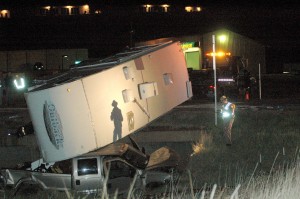 There was a wild accident down near Hot Springs last night. A left-turning vehicle crossed into the path of a pickup pulling a 30-foot trailer that was coming down a hill. The two vehicles collided and then the pickup with the trailer jackknifed over a large culvert. It made a pretty good mess and sent three people to the hospital. I don’t know the details of the accident, but it is possible that some of the auto-driver technology could have helped avoid the accident. The automatic system probably would not have been sun-blinded as might have been the case with one of the drivers. It probably would have prevented the one vehicle from turning into the path of the other. Technology could have slowed the pickup pulling the trailer as it approached the intersection. It is unclear if more technology would have helped the driver to maintain control after striking the vehicle and prevented the truck and trailer from jackknifing.
There was a wild accident down near Hot Springs last night. A left-turning vehicle crossed into the path of a pickup pulling a 30-foot trailer that was coming down a hill. The two vehicles collided and then the pickup with the trailer jackknifed over a large culvert. It made a pretty good mess and sent three people to the hospital. I don’t know the details of the accident, but it is possible that some of the auto-driver technology could have helped avoid the accident. The automatic system probably would not have been sun-blinded as might have been the case with one of the drivers. It probably would have prevented the one vehicle from turning into the path of the other. Technology could have slowed the pickup pulling the trailer as it approached the intersection. It is unclear if more technology would have helped the driver to maintain control after striking the vehicle and prevented the truck and trailer from jackknifing.
I suppose that no technology will eliminate all accidents. Technology that can reduce accidents has a lot of value. It is also possible that the Google car will work best in areas with heavy traffic where most accidents occur. The idea of a car that would drive itself in the long open spaces of Nevada is appealing, but it might be most helpful to have a vehicle that would negotiate city traffic. As a person who has lived most of his life far from the big cities, but who occasionally drives in them, I think my driving could use the most help in heavy traffic.
The technology fascinates me. I do, however, have a suggestion for the Google engineers. If they want a real test of their auto drive system, they ought to bring one of their fancy cars to our part of the world. I’d let them park it in my driveway if they needed a place. It might be fun to see if I could baffle the computer by asking the car to drive out Sheridan Lake Road to the Victoria Lake cutoff, take the dirt road to highway 385 then head north to the Silver City road. Then it could loop back to Pactola on the back road before going south toward Hill City. If it didn’t get lost on that loop, I’d think it was a pretty good driver.
But that isn’t the real test. The real test would be to see if it could complete the route without hitting a deer. If they make a car that avoids all of the deer, I might be interested in that technology.

There have been more than a few things that I didn’t see coming. I never gave much thought to having a car that didn’t require my input to get from one place to another. The thought of taking a nap while the car drives itself isn’t among the things I had envisioned. That reality may be closer than we think. Nevada changed its laws to allow self-driven cars in March. The long-term plan is to license members of the public to use such vehicles on Nevada roads. California is expected to follow with a similar law soon.

Preventing accidents appears to be the motivation for the investment of time and technology in developing a car that will drive itself. The Google cars use video cameras mounted on the roof, radar sensors and a laser range finder to determine the location of other traffic. Cars have successfully negotiated the steep streets of San Francisco, traveled in traffic across the Golden Gate Bridge, and made the trip around Lake Tahoe without problems.
I can’t decide how attractive the technology really is. It does seem like it would be a good thing to have a car that would prevent someone from taking a turn into oncoming traffic, from wandering from the assigned lane and take over when an inattentive or over-tired driver fails to remain alert. But it is hard to think of a self-driving car without getting a vision of someone trapped in a vehicle heading in an unwanted direction, or failing to make a rest stop when needed.
I could find no information about how the vehicles performed in adverse weather conditions. I wonder if a Google car can maintain control on an icy road. I’m pretty sure that it would be stopped by some of the mud that one encounters in the open country around here. Of course, it would probably refuse to go places where the GPS shows that there are no roads. Around here we often drive where the GPS database believes that there are no roads. There is a place on Interstate 90 near Rapid City where the visual display consistently shows the vehicle leaving the Interstate when it actually is following the road and maintaining its lane. Nevada is a rural state with a lot of back roads. Something tells me that these cars will need a little human input from time to time.
That makes me feel a little better. I don’t really want to believe that a system of computers, lasers and video cameras can replace me. I am not a perfect driver. I have had a few minor accidents over the years. Fortunately no one has been hurt and damage has been slight. All in all, I have a good safety record. I know, however, that accidents do occur. You cannot control the behavior of other drivers.

I suppose that no technology will eliminate all accidents. Technology that can reduce accidents has a lot of value. It is also possible that the Google car will work best in areas with heavy traffic where most accidents occur. The idea of a car that would drive itself in the long open spaces of Nevada is appealing, but it might be most helpful to have a vehicle that would negotiate city traffic. As a person who has lived most of his life far from the big cities, but who occasionally drives in them, I think my driving could use the most help in heavy traffic.
The technology fascinates me. I do, however, have a suggestion for the Google engineers. If they want a real test of their auto drive system, they ought to bring one of their fancy cars to our part of the world. I’d let them park it in my driveway if they needed a place. It might be fun to see if I could baffle the computer by asking the car to drive out Sheridan Lake Road to the Victoria Lake cutoff, take the dirt road to highway 385 then head north to the Silver City road. Then it could loop back to Pactola on the back road before going south toward Hill City. If it didn’t get lost on that loop, I’d think it was a pretty good driver.
But that isn’t the real test. The real test would be to see if it could complete the route without hitting a deer. If they make a car that avoids all of the deer, I might be interested in that technology.

Copyright © 2012 by Ted Huffman. I wrote this. If you want to copy it, please ask for permission. There is a contact me button at the bottom of this page. If you want to share my blog a friend, please direct your friend to my web site.
The death of a soldier
07/05/12 05:56

His family has lived with the risk of his death for a long time. He served as an intelligence Sergeant of an armed reconnaissance squadron forward deployed in Iraq. Over 200 combat missions in the Ninewa Province of Iraq placed him at risk day after day. 4,486 US troops died in Iraq. His family breathed a sigh of relief when he came home.
It wasn’t along before he was once again facing danger, this time in Afghanistan. Again he participated in hundreds of combat missions. Again his family was deeply aware of the risk he faced daily. 1960 US soldiers have died in Afghanistan. When he returned to the United States in March they had a moment of feeling he was once again safe.
The news of his death came as a shock.
Official military records record fatalities and injuries from military service in war zones. In addition to the fatalities, over 45,000 service men and women have been severely injured. Nearly 20% of the injured have suffered traumatic brain injuries. Casualties have been highest among those serving in the Army. The price of these wars has been high.
The statistics, however, do not tell the entire story. Statistics count physical injuries. Officials can count the number of destroyed limbs, the number of soldiers returning with crutches and wheelchairs and artificial limbs. There is no way to obtain an official count of damage to mental health. It is widely accepted that the number of diagnoses of Post Traumatic Stress Disorder are far lower than the number of actual victims.
There are many different ways to die as a result of service in the military. Some risks are obvious and garner a lot of attention on the news. Others are not so obvious. Soldiers who die as the result of the effects of stress and of other mental illnesses are often not included in official casualty reports.
The families who have lost these victims, however, know the truth. The loss is every bit as real. The pain is every bit as devastating. The grief is every bit as overwhelming.
The cost of the wars has been higher than the statistics report.
One of the ways to learn about the community in which you live is to read obituaries. Every obituary is a biography of sorts. The stories of the people of our community are contained not only in the descriptions of lives lived in the obituaries, but also in the list of the names of the survivors. Reading the list of survivors and then reading the “preceded in death by” will give a catalogue of grief experienced by a family. Obituaries often carry truth both in what is said and in what is not said.
I suppose it is a product of my age, but I can’t help but looking at the age of the victims. There is grief associated with every death, but there is a unique grief that is attached to the loss of a child. Victims under the age of thirty almost always have a parent among the survivors. Saturday was a tough day for our community’s obituaries. There were a dozen obituaries. A third of them told the stories of someone who died before their thirtieth birthday.
The soldier who will be laid to rest in Black Hills National Cemetery was only 24 when he died. A little less than six years from his high school graduation and he had experienced over 500 combat missions in two wars.
The obituary is long. The family sought to tell as much of the story as they were able in this format. But even a casual observer can tell the truth. There was far more to the life of this young man than could be told in a newspaper article. He was more talented, more complex, more interesting, more loving and more fascinating than the words convey. The obituary tells a part of the story. There is so much more that could be said.
Still, the obituary is important to everyone who has read it. We hear lots of statistics. We are bombarded by images of violence on television. We have become numb to the news. When you read the obituary, however, you cannot deny that our nation’s grief isn’t about numbers. It is about individuals. Each digit in the official count is a person with hopes and aspirations and dreams that are unique. Each statistic is s person with a family and a unique combination of relatives who are affected by the loss. Each obituary is the story of what has been and a question of what might have been. The road of grief keeps turning into the question “what if?” And there is no answer to the question.
Some questions are never answered.
I have spoken with the father twice since the news of the death reached our community. He has been stoic and reserved. There is no need for public displays for us to know his grief. His pain is deep enough that we have no desire to see him embarrassed or feeling out of control. We know that his grief is real, his life suddenly taken over, his future re-defined in a way he never wanted it to be. Tears come easier for the mother, though her journey of grief is no less difficult.
Civil War General William Tecumseh Sherman is credited with coining the phrase “War is Hell.” I have never been in battle. I have never gone on a combat mission. But I know the horror of war. I have seen it in the faces of parents.
These wars have affected us all. If we would truly honor those who have died, we must start by caring for those they loved. We’ll be working on this task for the rest of our lives.
Copyright © 2012 by Ted Huffman. I wrote this. If you want to copy it, please ask for permission. There is a contact me button at the bottom of this page. If you want to share my blog a friend, please direct your friend to my web site.
The long and short of it
06/05/12 04:50
When I began building canoes, it never occurred to me that I might want to paddle in water that was much bigger than the inland lakes and streams that surrounded us. Since those days, I have had the opportunity to paddle in coastal waters off of the east and west coasts of the United States and Canada as well as in the Great Lakes. For those waters, a sea kayak is a useful boat. So in 2007, I decided to make myself such a boat. I had come into some quarter-sawn Black Hills Spruce and I didn’t have a good source for cedar, so I decided to build a skin-on-frame boat instead of a woodstrip boat like others I had previously made. I read a couple of books on skin on frame boats and I found a set of plans for an expedition boat. The finished boat is 17’6” long and paddles very quickly on calm waters. I have paddled it in the Puget Sound as well as in area lakes and enjoy the way it handles.
One problem with being an owner of such a boat is magnified by owning several canoes and kayaks. One needs a place to store them. Canoes and kayaks store quite easily by hanging them from the rafters in the garage and there is room in our garage for several.
Add to the storage of the boats one cat. Our cat came to live with us when our daughter was still living at home. She had a touch for finding just the right cat at the animal shelter. And, after living together for several years, we have grown quite attached to the cat. The cat, of course, thinks that the entire house is hers and that we exist to serve her. Nonetheless, the cat is required to sleep in the garage.
Now I have made two very nice beds in the garage for the cat. One is right next to the door, with food and water nearby and just a short distance to the litter box. She has everything she needs right in one place. The cat, however, likes to climb around the rafters. So I took some old carpet and fixed a second bed up in the rafters, right next to the chimney, where it is warm.
The cat, of course, has taken to sleeping on the boats that hang below the rafters.
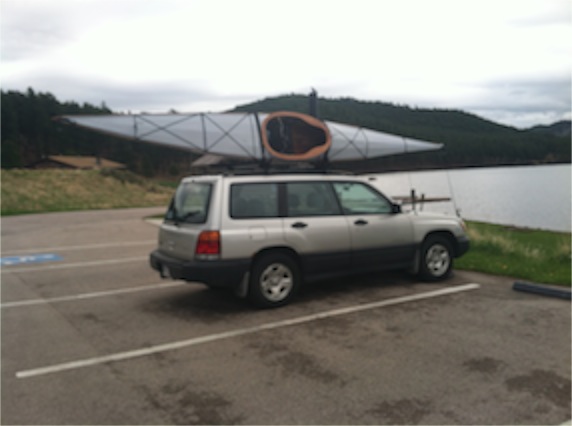 The expedition kayak is covered with aircraft Dacron. The think skin of Dacron and the sharp claws of the cat doe not seem to me to be a good combination. So on Friday I took the kayak out of the garage. Yesterday morning I decided to take it for a paddle. I did discover some small holes caused by the cat that will need to be repaired, but the paddle was great fun. Because of the way the seat is installed in the boat, the small amount of water that leaked didn’t get me wet and the repair will be relatively easy. Nonetheless it does need to be repaired.
The expedition kayak is covered with aircraft Dacron. The think skin of Dacron and the sharp claws of the cat doe not seem to me to be a good combination. So on Friday I took the kayak out of the garage. Yesterday morning I decided to take it for a paddle. I did discover some small holes caused by the cat that will need to be repaired, but the paddle was great fun. Because of the way the seat is installed in the boat, the small amount of water that leaked didn’t get me wet and the repair will be relatively easy. Nonetheless it does need to be repaired.
After paddling, while I was still at the lake, I loaded the boat onto the car and decided to take a picture since the boat is longer than the car.
I suppose that there are some people who might wonder why a guy needs a boat that is longer than the car. There are plenty of people who wonder why a guy might need so many canoes and kayaks as I have collected. Basically, if you don’t understand the need for different boats in different situations, you probably don’t need as many boats. Like many other things in life, it depends on your ideas, thoughts and passions.
To my eye, the kayak looks good on the roof of the car. It rides very well up there. I could drive practically anywhere I would want to go, hauling the boat like that. And it makes a statement about the kind of person I am. 12-year-old car with over 200,000 miles on it with a hand-made boat on the roof says something about my priorities.
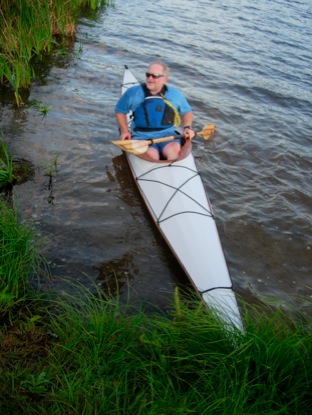 Boats always look awkward when they are out of the water. The kayak was made to be paddled. Its shape is based on the historic kayaks of Greenland. They were practical boats, designed for specialized hunting. For centuries, the shape evolved not around recreation, but around the need to be able to travel significant distances over the water without the aid of motors or even sails. The boats had to be able to withstand storms and be paddled into the wind as well as handle waves. The long narrow boats were quick and easy to paddle and could handle 4 to 6 food swells. I’d never have the courage to paddle in such conditions, but the boat could take it in the hands of an expert paddler. Another treat to these kayaks is that they are warm. When the spray skirt is attached, there is insulation around the lower part of the body. The fit is snug. When I’m in the boat, my feet, knees and hips are all in direct contact with the boat. When I move my lower body, I feel the boat come along with me. I can tip and turn the boat by tipping and turning my body.
Boats always look awkward when they are out of the water. The kayak was made to be paddled. Its shape is based on the historic kayaks of Greenland. They were practical boats, designed for specialized hunting. For centuries, the shape evolved not around recreation, but around the need to be able to travel significant distances over the water without the aid of motors or even sails. The boats had to be able to withstand storms and be paddled into the wind as well as handle waves. The long narrow boats were quick and easy to paddle and could handle 4 to 6 food swells. I’d never have the courage to paddle in such conditions, but the boat could take it in the hands of an expert paddler. Another treat to these kayaks is that they are warm. When the spray skirt is attached, there is insulation around the lower part of the body. The fit is snug. When I’m in the boat, my feet, knees and hips are all in direct contact with the boat. When I move my lower body, I feel the boat come along with me. I can tip and turn the boat by tipping and turning my body.
The original Greenland kayaks were made of available materials. In that climate, wood was scarce and the frames were generally made out of driftwood of a variety of types. The pieces were short and so the long boat had to be assembled using a lot of joints in the woodwork. The side frames are trusses with lots of small diagonal pieces. Skin on those boats was animal, usually seal. I do not have a source of sealskin readily available, so my boat is covered with aircraft Dacron stretched tight. In the water it is nearly silent.
These boats were not designed for long lives. In their original use, they were often built over the winter and paddled for two or three seasons. Being made all of natural materials, they were just left along the shore and they would soon degrade into the soil. The next boat would have a similar shape, but the shape would evolve depending on the needs and experiences of the hunter. A seasoned hunter could go through ten or twelve boats in his lifetime.
Compared to them, I don’t have all that many boats. There are just three kayaks and two canoes.
And there is a rowboat under construction in the garage.
And when I finish that, perhaps a new expedition kayak is in order. . .
One problem with being an owner of such a boat is magnified by owning several canoes and kayaks. One needs a place to store them. Canoes and kayaks store quite easily by hanging them from the rafters in the garage and there is room in our garage for several.
Add to the storage of the boats one cat. Our cat came to live with us when our daughter was still living at home. She had a touch for finding just the right cat at the animal shelter. And, after living together for several years, we have grown quite attached to the cat. The cat, of course, thinks that the entire house is hers and that we exist to serve her. Nonetheless, the cat is required to sleep in the garage.
Now I have made two very nice beds in the garage for the cat. One is right next to the door, with food and water nearby and just a short distance to the litter box. She has everything she needs right in one place. The cat, however, likes to climb around the rafters. So I took some old carpet and fixed a second bed up in the rafters, right next to the chimney, where it is warm.
The cat, of course, has taken to sleeping on the boats that hang below the rafters.

After paddling, while I was still at the lake, I loaded the boat onto the car and decided to take a picture since the boat is longer than the car.
I suppose that there are some people who might wonder why a guy needs a boat that is longer than the car. There are plenty of people who wonder why a guy might need so many canoes and kayaks as I have collected. Basically, if you don’t understand the need for different boats in different situations, you probably don’t need as many boats. Like many other things in life, it depends on your ideas, thoughts and passions.
To my eye, the kayak looks good on the roof of the car. It rides very well up there. I could drive practically anywhere I would want to go, hauling the boat like that. And it makes a statement about the kind of person I am. 12-year-old car with over 200,000 miles on it with a hand-made boat on the roof says something about my priorities.

The original Greenland kayaks were made of available materials. In that climate, wood was scarce and the frames were generally made out of driftwood of a variety of types. The pieces were short and so the long boat had to be assembled using a lot of joints in the woodwork. The side frames are trusses with lots of small diagonal pieces. Skin on those boats was animal, usually seal. I do not have a source of sealskin readily available, so my boat is covered with aircraft Dacron stretched tight. In the water it is nearly silent.
These boats were not designed for long lives. In their original use, they were often built over the winter and paddled for two or three seasons. Being made all of natural materials, they were just left along the shore and they would soon degrade into the soil. The next boat would have a similar shape, but the shape would evolve depending on the needs and experiences of the hunter. A seasoned hunter could go through ten or twelve boats in his lifetime.
Compared to them, I don’t have all that many boats. There are just three kayaks and two canoes.
And there is a rowboat under construction in the garage.
And when I finish that, perhaps a new expedition kayak is in order. . .
Copyright © 2012 by Ted Huffman. I wrote this. If you want to copy it, please ask for permission. There is a contact me button at the bottom of this page. If you want to share my blog a friend, please direct your friend to my web site.
Also in the news
05/05/12 05:21
I begin most days by reading news headlines. I like to look at the BBC, an Australian News Source, one from Costa Rica, The Washington Post, the New York Times and our local newspaper, The Rapid City Journal. I often don’t read many of the articles, but check out the ones that catch my eye. It isn’t at all uncommon for the headline to be a bit misleading or for the article to surprise me even after I have read the headline. This process gives me a broad view of what is happening in the world, but I often read as much trivia as substantive news. Sometimes an article becomes the source of a topic for my daily blog. Other things catch my attention, but aren’t enough for a whole blog. So today, being a Saturday that will be busy and full for me, I’ve decided to write about a whole bunch of themes instead of a single one. Here is a collection of things I have learned from reading news headlines.
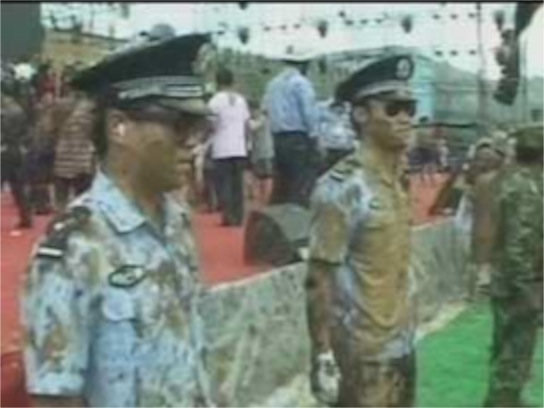 A week ago I was making a night call with an officer of the Pennington County Sheriff’s department. We got into quite a bit of mud going to a rural address. We had mud on our shoes and lots of mud on our vehicles. Getting muddy is an annual ritual for the officers of Southwest China’s Yunnan province. Each year, on May 1, the people celebrate the May Day holiday by covering each other in mud. The mud is thought to bring good luck. The event originates from an ancient festival of the Va, a local ethnic group. Part of the event is that local police officers stand at attention, in uniform with hats, gloves and sunglasses. Celebrators smear mud on their faces and bodies as the officers stand without reacting to the mud. Something tells me this one isn’t going to catch on in our town.
A week ago I was making a night call with an officer of the Pennington County Sheriff’s department. We got into quite a bit of mud going to a rural address. We had mud on our shoes and lots of mud on our vehicles. Getting muddy is an annual ritual for the officers of Southwest China’s Yunnan province. Each year, on May 1, the people celebrate the May Day holiday by covering each other in mud. The mud is thought to bring good luck. The event originates from an ancient festival of the Va, a local ethnic group. Part of the event is that local police officers stand at attention, in uniform with hats, gloves and sunglasses. Celebrators smear mud on their faces and bodies as the officers stand without reacting to the mud. Something tells me this one isn’t going to catch on in our town.
 I am not a fan of cockroaches. We would occasionally see them when we lived in Chicago, and the basement of the apartment building in which we lived had a lot of them. When you turned on the light down there, they would scurry and head for dark corners and crevices. Scientists, however, say that we do not give the insects enough credit. Cockroaches are highly social creatures. They recognize member of their own families and live in multiple-generation family units. They suffer ill health when they are left alone. Very few other insect species have such advanced social skills. What I can’t figure out is why someone would want to spend enough time with cockroaches to find this stuff out. The journal Insectes Sociaux is devoted to the social patterns of insects. The recent article on cockroaches featured both German and American scientists who apparently have devoted their lives to such studies. There are some jobs in this world that just wouldn’t be a good fit for me.
I am not a fan of cockroaches. We would occasionally see them when we lived in Chicago, and the basement of the apartment building in which we lived had a lot of them. When you turned on the light down there, they would scurry and head for dark corners and crevices. Scientists, however, say that we do not give the insects enough credit. Cockroaches are highly social creatures. They recognize member of their own families and live in multiple-generation family units. They suffer ill health when they are left alone. Very few other insect species have such advanced social skills. What I can’t figure out is why someone would want to spend enough time with cockroaches to find this stuff out. The journal Insectes Sociaux is devoted to the social patterns of insects. The recent article on cockroaches featured both German and American scientists who apparently have devoted their lives to such studies. There are some jobs in this world that just wouldn’t be a good fit for me.
Scott McMurry of Florida received a postcard from his mother this week. It is nice to know that people still receive postcards and that the post office still delivers them. Of course they provide a type of communication that is a bit slower-paced than the world to twitter, text messages and instant communication. The postcard Mr. McMurry received was mailed by his mother in 1957. There is no explanation of why it took so long for the card to arrive.
 My days are busy and I am being very careful with the portions of food I eat, but I still prefer to take an hour and go home at lunch. This is very unusual in our fast-paced world. I have many colleagues who eat a sandwich or yogurt while sitting at their desks. I have days when the meetings stack up and we go straight through mealtimes without a break. Central Americans are famous for their siestas. The French are known to take two hours to enjoy a leisurely meal in the middle of the workday. But I caught a short article on Slate.com this week about office workers in Sweeden who go to a dance club for their lunch breaks. “Lunch Beat” gatherings attract upwards of 600 people for mid day dance parties. In 2011, “lunch disco” was officially recognized as a new word by the Swedish Language Council. They may be experts in words, but they sure can’t count. Isn’t “lunch disco” two words?
My days are busy and I am being very careful with the portions of food I eat, but I still prefer to take an hour and go home at lunch. This is very unusual in our fast-paced world. I have many colleagues who eat a sandwich or yogurt while sitting at their desks. I have days when the meetings stack up and we go straight through mealtimes without a break. Central Americans are famous for their siestas. The French are known to take two hours to enjoy a leisurely meal in the middle of the workday. But I caught a short article on Slate.com this week about office workers in Sweeden who go to a dance club for their lunch breaks. “Lunch Beat” gatherings attract upwards of 600 people for mid day dance parties. In 2011, “lunch disco” was officially recognized as a new word by the Swedish Language Council. They may be experts in words, but they sure can’t count. Isn’t “lunch disco” two words?
 I’ve been poking fun at those who think the Mayan calendar predicts the end of the world in 2012. I simply don’t live my life according to Mayan beliefs and I suspect that most who do think interpret the ancient calendar don’t have much knowledge of its original meaning. This week Reuters reported an international poll of over sixteen thousand people. Nearly 15 percent of people worldwide believe the world will end in their lifetime. 10 percent think the Mayan calendar signifies that it will happen in 2012. The United States and Turkey have the highest percentages of those who predict the end of the world. 22% of those polled in each country believe the world will end in their lifetime. That is nearly 1 in four! Here’s the scary part. Only six percent of French residents believe in an impending Armageddon in their lifetime. Do you think it is possible I would fit in better in France than in my own country? Now that is a truly strange thought.
I’ve been poking fun at those who think the Mayan calendar predicts the end of the world in 2012. I simply don’t live my life according to Mayan beliefs and I suspect that most who do think interpret the ancient calendar don’t have much knowledge of its original meaning. This week Reuters reported an international poll of over sixteen thousand people. Nearly 15 percent of people worldwide believe the world will end in their lifetime. 10 percent think the Mayan calendar signifies that it will happen in 2012. The United States and Turkey have the highest percentages of those who predict the end of the world. 22% of those polled in each country believe the world will end in their lifetime. That is nearly 1 in four! Here’s the scary part. Only six percent of French residents believe in an impending Armageddon in their lifetime. Do you think it is possible I would fit in better in France than in my own country? Now that is a truly strange thought.
 A new world land speed record was set on May 2 in Australia. Stuntwoman Jolene Van Vught traveled from Canada to Australia to set a new world’s speed record for a motorized toilet. After having some problems with the toilet, it was soon repaired and she got up to 75 km per hour (46mph) beating the old record by 7km/h. The BBC reports she was flushed with pride. Even my puns aren’t that bad.
A new world land speed record was set on May 2 in Australia. Stuntwoman Jolene Van Vught traveled from Canada to Australia to set a new world’s speed record for a motorized toilet. After having some problems with the toilet, it was soon repaired and she got up to 75 km per hour (46mph) beating the old record by 7km/h. The BBC reports she was flushed with pride. Even my puns aren’t that bad.
I’ve got dozens more strange bits. There are always new things that I learn from reading the news, but too often they are bits of information that don’t have much practical use. It just makes you wonder. If I did believe that the world was going to end this year, would I be more likely to get into racing toilets?
I don’t think so.


Scott McMurry of Florida received a postcard from his mother this week. It is nice to know that people still receive postcards and that the post office still delivers them. Of course they provide a type of communication that is a bit slower-paced than the world to twitter, text messages and instant communication. The postcard Mr. McMurry received was mailed by his mother in 1957. There is no explanation of why it took so long for the card to arrive.



I’ve got dozens more strange bits. There are always new things that I learn from reading the news, but too often they are bits of information that don’t have much practical use. It just makes you wonder. If I did believe that the world was going to end this year, would I be more likely to get into racing toilets?
I don’t think so.
Copyright © 2012 by Ted Huffman. I wrote this. If you want to copy it, please ask for permission. There is a contact me button at the bottom of this page. If you want to share my blog a friend, please direct your friend to my web site.
Looking up at night
04/05/12 05:36
There have been times in the history of people when we lived a bit closer to nature. If you don’t have electricity, you tend to sleep when it is dark and wake when it is light. That means that people living farther from the equator have more sleep time in the winter and less in the summer. Of course the human body has its own cycles of sleep and wakefulness and being awake during the night is common, perhaps even natural. In the days before everyone lived indoors in climate-controlled homes with electric lighting, folks were more aware of the cycles of the night sky.
It takes concentration and regular observation to discern the movement of the planets. But if you spend time outdoors at night in rural areas away from the bright lights of cities, it is difficult to ignore the moon. People measured time by the cycles of the moon. Many early calendars were based on the lunar cycle.
We are simply less aware.
 The ancients observed that the moon appears to be larger at certain times than at others. Part of the size of the moon is due to its location in the sky and the relationship of the moon to the sun. Looking through the earth’s atmosphere makes the moon appear bigger. When it is on the horizon, we look through more of the earth’s atmosphere than when it is directly overhead. But there are variations on how the moon appears at moonrise.
The ancients observed that the moon appears to be larger at certain times than at others. Part of the size of the moon is due to its location in the sky and the relationship of the moon to the sun. Looking through the earth’s atmosphere makes the moon appear bigger. When it is on the horizon, we look through more of the earth’s atmosphere than when it is directly overhead. But there are variations on how the moon appears at moonrise.
Sometimes the moon looks bigger because it is closer. Its orbit around the earth is not a circle, but an ellipse. The moon will reach the point closest to the earth in its orbit this evening. The event coincides with the full moon. Moonrise tomorrow will be nearly 8 p.m. here and the exact moment of the full moon comes at 9:35 p.m. The forecast calls for thundershowers, so we may not get a glimpse of it, but when the clouds part, the moonlight should be a bit brighter than usual.
If we lived closer to the coast we would also notice that the tide would be a bit higher than typical. Because the gravity of the moon affects the distribution of water around our planet, when the moon is closer, the change is a bit more dramatic.
A good place to observe the effect would be a large inlet, such as the Bay of Fundy, off of the east coast of Canada, where the change in the tides is very dramatic. In fact the shape of that particular bay results in the most extreme tides in the world. During the spring tide the variation can be as much as 48 feet. Spring tide is a reference to the time of greatest variation in tides, not to the season. It comes from a German word and refers to the tides springing up.
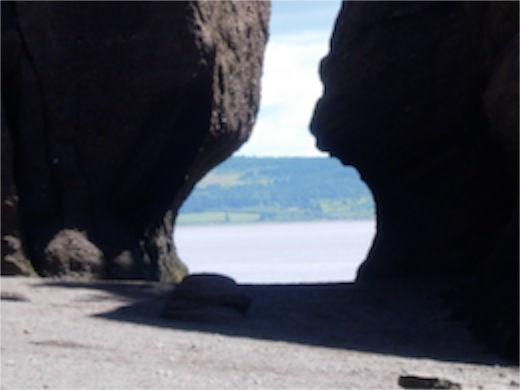 We had the good fortune to be able to visit the Bay of Fundy in 2007. One afternoon I was kayaking on water that was at least 18 feet above the sand where we had walked the same morning. The currents in the bay can be impressive. In order to produce the tidal effect, every day 100 billion tons of seawater flows in and out of the bay. That’s a lot of water!
We had the good fortune to be able to visit the Bay of Fundy in 2007. One afternoon I was kayaking on water that was at least 18 feet above the sand where we had walked the same morning. The currents in the bay can be impressive. In order to produce the tidal effect, every day 100 billion tons of seawater flows in and out of the bay. That’s a lot of water!
All of this is courtesy of the moon.
There are a lot of persistent myths about the moon and its effects on us humans. The term “lunacy” comes from the moon and a belief that the moon has some sort of effect on human mental illness. If you talk to employees in nursing homes and psychiatric wards and emergency rooms they will frequently claim that they are busier and people are more upset when there is a full moon. Since the human body is nearly 75% water, it has been speculated that this might be the result of the gravity sloshing the water inside of us like it does the water of the ocean.
That’s probably not true. Tidal effect requires a lot more water than you have inside of a person. You don’t notice tides on lakes. It takes an ocean for the effect to be noticed.
Furthermore, studies don’t bear out the myths.
A 2005 study by Mayo Clinic, reported in the journal Psychiatric Services found no statistical difference in the number of psychiatric emergencies on the three nights surrounding the moon verses other nights.
A 1996 report in the American Journal of Emergency Medicine found no difference in emergency room visits at full moon verses other nights.
Bad Science columnist Benjamin Radford observes, “If police and doctors are expecting that full moon nights will be more hectic, they may interpret an ordinary night’s traumas and crises as more extreme than usual. Our expectations influence our perceptions, and we look for evidence that confirms our beliefs.”
I’m not convinced that the full moon, or even the moon a perigee (the point closest to the earth), has much of an effect on human behavior. I enjoy listening to the stories and theories, but I remain skeptical. However, there is one explanation that makes a bit of sense to me. It has been speculated that in times before electricity and mini-blinds to keep us insulated from what is going on outside, people were awake more during nights of the full moon. There was more light, more people were awake, they got into more trouble. It has even has been theorized that people behaved more strangely because they were getting less sleep. Sleep deprivation can make folks behave in strange ways.
That may have been true in the past, but it hardly makes sense in our modern world. People are more likely to loose sleep for reasons other than the amount of moonlight.
 For me, the full moon is an opportunity to try to get another picture of the moon. I like to try to photograph it, though it always appears to be more beautiful in person than in the photographs I take. My pictures always produce an image of a moon that is tiny and far away.
For me, the full moon is an opportunity to try to get another picture of the moon. I like to try to photograph it, though it always appears to be more beautiful in person than in the photographs I take. My pictures always produce an image of a moon that is tiny and far away.
After all, tomorrow night when it is as close as it gets, the moon will still be 221,473 miles away.
It takes concentration and regular observation to discern the movement of the planets. But if you spend time outdoors at night in rural areas away from the bright lights of cities, it is difficult to ignore the moon. People measured time by the cycles of the moon. Many early calendars were based on the lunar cycle.
We are simply less aware.

Sometimes the moon looks bigger because it is closer. Its orbit around the earth is not a circle, but an ellipse. The moon will reach the point closest to the earth in its orbit this evening. The event coincides with the full moon. Moonrise tomorrow will be nearly 8 p.m. here and the exact moment of the full moon comes at 9:35 p.m. The forecast calls for thundershowers, so we may not get a glimpse of it, but when the clouds part, the moonlight should be a bit brighter than usual.
If we lived closer to the coast we would also notice that the tide would be a bit higher than typical. Because the gravity of the moon affects the distribution of water around our planet, when the moon is closer, the change is a bit more dramatic.
A good place to observe the effect would be a large inlet, such as the Bay of Fundy, off of the east coast of Canada, where the change in the tides is very dramatic. In fact the shape of that particular bay results in the most extreme tides in the world. During the spring tide the variation can be as much as 48 feet. Spring tide is a reference to the time of greatest variation in tides, not to the season. It comes from a German word and refers to the tides springing up.

All of this is courtesy of the moon.
There are a lot of persistent myths about the moon and its effects on us humans. The term “lunacy” comes from the moon and a belief that the moon has some sort of effect on human mental illness. If you talk to employees in nursing homes and psychiatric wards and emergency rooms they will frequently claim that they are busier and people are more upset when there is a full moon. Since the human body is nearly 75% water, it has been speculated that this might be the result of the gravity sloshing the water inside of us like it does the water of the ocean.
That’s probably not true. Tidal effect requires a lot more water than you have inside of a person. You don’t notice tides on lakes. It takes an ocean for the effect to be noticed.
Furthermore, studies don’t bear out the myths.
A 2005 study by Mayo Clinic, reported in the journal Psychiatric Services found no statistical difference in the number of psychiatric emergencies on the three nights surrounding the moon verses other nights.
A 1996 report in the American Journal of Emergency Medicine found no difference in emergency room visits at full moon verses other nights.
Bad Science columnist Benjamin Radford observes, “If police and doctors are expecting that full moon nights will be more hectic, they may interpret an ordinary night’s traumas and crises as more extreme than usual. Our expectations influence our perceptions, and we look for evidence that confirms our beliefs.”
I’m not convinced that the full moon, or even the moon a perigee (the point closest to the earth), has much of an effect on human behavior. I enjoy listening to the stories and theories, but I remain skeptical. However, there is one explanation that makes a bit of sense to me. It has been speculated that in times before electricity and mini-blinds to keep us insulated from what is going on outside, people were awake more during nights of the full moon. There was more light, more people were awake, they got into more trouble. It has even has been theorized that people behaved more strangely because they were getting less sleep. Sleep deprivation can make folks behave in strange ways.
That may have been true in the past, but it hardly makes sense in our modern world. People are more likely to loose sleep for reasons other than the amount of moonlight.

After all, tomorrow night when it is as close as it gets, the moon will still be 221,473 miles away.
Copyright © 2012 by Ted Huffman. I wrote this. If you want to copy it, please ask for permission. There is a contact me button at the bottom of this page. If you want to share my blog a friend, please direct your friend to my web site.
The Price of a Scream
03/05/12 05:26

The news reports are all filled with the price. It seems to be the thing about the painting that is the most important part of today’s news. So let’s get it out at the beginning of the blog. $119,922,500 is a lot of money. I have no idea what that much money is like. My budget doesn’t allow for the purchase of things that are that expensive. We don’t know who the buyer is. It was a telephone bidder at the Sotherby’s auction yesterday. The seller is businessman Petter Olsen, whose father was a friend of Norwegian expressionist Edvard Munch, who created the pastel-on-board work of art.
It is one of four in a series, and the only one in private ownership. It will remain in private ownership for now, it appears. The other three are held by museums. This version is the only one to include a poem by Munch on the frame that speaks of the inspiration behind the series.
“I was walking along a path with two friends
the sun was setting
suddenly the sky turned blood red
I paused, feeling exhausted, and leaned on the fence
There was blood and tongues of fire above the blue-black fjord and the city.
“My friends walked on, and I stood there trembling with anxiety
and I sensed an infinite scream passing through nature.”
It is the highest price ever brought by a work of art at auction. It isn’t the highest price ever paid for artwork. Gustav Klimt’s Portrait of Adele Bloch-Bauer I sold for $2135m. Willem de Kooning’s Woman III went for 137.5m. No. 5, 1948, by Jackson Pollock fetched $140m. The Card Players by Paul Cezanne sold for $250m. As I said before, I don’t understand the prices. At least the money from yesterday’s sale will be invested in something tangible. The seller reports proceeds from the sale will go toward the establishment of a new museum, art center and hotel in Hvitsten, Norway. “I have lived with this work all my life, and its power and energy have only increased with time,” Olsen said. He felt “the moment has come to offer the rest of the world the chance to own and appreciate this remarkable work.”
The rest of the world didn’t ever stand a chance. Only a few very wealthy individuals participated in the bidding that lasted only 12 minutes.
Mental illness was a constant fear for Edvard Munch. His sister had just been committed to a madhouse. At 30 and an unsuccessful artist, Munch feared that he, too, was going mad. That is the way they talked about mental illness in those days. If you went mad, they locked you up. Mental illness wasn’t understood. Treatment was thought to be impossible. Restraint was the only option people could see. The lives of those suffering from mental illness were unbearably sad. Munch lived near the asylum where his sister was living. He heard screams coming from that place.
He turned his fear into a drawing. Under a swirling red sky a lone figure on a bridge clasps its head in its hands and cries out in despair. We don’t know if it is male or female. We don’t know anything about the figure except for its terror. It has come to be a symbol of hopelessness and anxiety.
That much I get. I don’t understand why it has turned up on coffee mugs and t-shirts and calendars and posters and Halloween masks. What started as a deeply personal work of art channeling the tormented psyche of a fearful artist has turned out to be an icon – a symbol recognized everywhere. Do we really want to adorn our homes with misery and desperation? Is that the decoration we seek? Why would anyone think that he or she would want to possess such a thing?
We like to look at things that trouble us. We like to listen to sad songs. Humans are drawn to the things that frighten and stir our emotions, even when those emotions are negative. I think that part of the attraction is the simple fact that fear and loneliness are universal. We have been to the edge of the scream in our own lives.
Munch’s art has inspired other artists. Francis Bacon did a Screaming Pope series. Picasso’s Guernica is strangely reminiscent of The Scream. Andy Warhol did silk prints of Munch’s work. Wes Craven made a series of movies about the scream. The aliens in Doctor Who look like the figure in Munch’s art.
I confess I don’t understand it. I am not one of the people whose iPod is filled with sad songs. I prefer my music to be light and joyful. I am drawn to artwork that expresses these emotions as well. I see no reason to pay money to watch a movie that leaves me trembling with fear.
Rachel Campbell-Johnson, chief art critic at the New York Times suggests that such direct emotion in art is somehow adolescent and that people may grow into other preferences as they mature. “It appeals to an immature taste. As you get older you want something different – art that transforms the everyday rather than goes to the extremes of human emotion.” If she is right, and I am not sure she is, the work reflects the time in which it was produced. There was an adolescent-like quality to the end of the 19th century. The world had seen an industrial revolution and the rise of modern democracies that gave a hopefulness and expectation to society. The horrors of the wars of the 20th century were not yet revealed. The unlimited destruction of nuclear warfare had not yet been imagined. Perhaps Munch’s personal anxiety reflected a deeper fear that was a part of the world. It was a fear of the unknown. Looking back from the perspective of the 21st Century, we have witnessed World Wars, a Holocaust and other genocides, nuclear bombs and terrorism. There was much to fear when the scream was created.
I am sad that the work will not be going to a museum. Part of me wanted to see the four versions displayed side by side. I think things like The Scream cannot be possessed by an individual but rather belong to the whole world. But who am I to say what should happen. I wouldn’t want the paining hanging in my home.
And I certainly could not afford to buy it if I did want it.
Copyright © 2012 by Ted Huffman. I wrote this. If you want to copy it, please ask for permission. There is a contact me button at the bottom of this page. If you want to share my blog a friend, please direct your friend to my web site.
In Search of New Language
02/05/12 05:37
Note: There are no photographs with today’s blog. The visual images that come to my mind should not be shared. Some topics require words for communication to take place.
The English language is constantly evolving. New words emerge. Old words have their meanings change. My grandparents used the word “gay” in their everyday conversation without making any connection to sexuality or sexual orientation. These days the word seems to have lost the meaning of “full of joy, merry, light-hearted, carefree.” There are many other words whose meaning has evolved as time has passed.
I think that we are about due for a new word that describes the action of taking one’s own life as the result of a mental illness. The commonly accepted term is “suicide.” The problem with the use of that word in describing the effects of mental illness is that it carries with it a host of associations with illegal behavior. People commonly say a person “committed suicide” just like we say “committed murder.” The word “committed” implies a willful act with the intention of causing harm. Death by suicide does involve specific actions taken by the individual, but those who have attempted suicide and not died often describe the self harm as something that could not be controlled or as the “only option” to end pain.
If it were only the associated verb, however, we could easily modify our language. I am careful to never say “committed suicide.” Instead I say, “died by suicide,” that hints at my sense that suicide is often the result of illness and that just like cancer or heart disease, depression has its victims, some of whom die. Furthermore, some of the deaths could be prevented if we were to dedicate sufficient funds to early detection, treatment and prevention.
Such usage, however, does not remove the stigma from the word “suicide.” The news media has already made an indelible connection between suicide and terrorism. An Internet search of the word suicide at news sites reveals how suicide is portrayed in the news:
I am not a psychologist. I do not understand terrorism. It is possible that those who commit acts of terror are suffering from mental illnesses. But I do know that highly personal acts of desperation to end one’s life are very different from acts of terrorism intended to kill as many others as possible.
I also know that survivors of suicide – the families and loved ones of those who die by suicide – go through years of anguish, often without the support of the community because of the stigma attached to death by suicide.
We need a separation of language. We need a new term for personal death as a result of chronic mental illness and an attack designed to create death and terror in support of a political ideology. They simply are not the same.
The problem is that I do not know what that new word might be. Perhaps the best word is no word at all. After all, we don’t have a special word to describe the death process of those who die as a result of the ravages of cancer. We don’t have a special word for the death of one who suffers congestive heart failure. We simply say that the person died. Sometimes we say they died “of cancer” or “of heart disease.” I’ve read many obituaries that say a person “died after a long battle with cancer.” I’ve never read one that said someone “died after a long battle with chronic depression.” Maybe it is time for a new way of describing what has occurred.
Along with the shift in language, we need to shift our perceptions. One thing that needs to be changed is the sense of fatalism that surrounds death by suicide. Too often I’ve heard it said, “There is nothing that could have been done.” While I do not want to add guilt to the other burdens born by survivors, I do want to challenge that assumption. Obviously those who loved the person who died would have done anything to prevent the death. Too often they did not see any warning signs. In other cases, they did everything they knew to try to help the person. But we, as a society, could do a lot more to prevent death by suicide.
Accurate statistics are difficult to obtain, but look at this comparison: Cardiopulmonary Resuscitation (CPR) is the widely accepted response to heart failure. In an incident where someone dials 911 and the ambulance crew arrives and begins CPR, about 15% of the victims experience return of spontaneous circulation. Only about 2% actually recover from the attack. It can easily be argued that those are unusual circumstances and that CPR was started too late. Survival does increase when CPR is started sooner. In a witnessed cardiac arrest that takes place in the hospital, the victim has a 48% chance of restored heartbeat. About 22% of victims survive such situations. If you add the use of defibrillation within the first 3 minutes, the survival rate goes up to about 30%.
Those survival rates – at best 30% - are clearly worth all of the education and all of the expense of placing automatic electronic defibrillators in public places. It isn’t hard to raise funds and awareness to increase the number of people who are trained in those life-saving techniques.
Applied Suicide Intervention Skills Training (ASIST) is the standard training for lifesaving for those who are at risk of dying by suicide. Like CPR, ASIST is a research-based, internationally recognized program. Intervention by someone trained in ASIST is over 80% effective in preventing death by suicide within the first weeks following the intervention. Nearly 75% of those who receive intervention from an ASIST-trained person do not die by suicide. Intervention works.
While every ambulance driver, firefighter, police and sheriff’s deputy in our community is trained in CPR, only a few are trained in ASIST. Not one of our city’s ambulance drivers or attendants is ASIST trained.
Clearly we need to find the words to talk about and prevent unnecessary death.
The English language is constantly evolving. New words emerge. Old words have their meanings change. My grandparents used the word “gay” in their everyday conversation without making any connection to sexuality or sexual orientation. These days the word seems to have lost the meaning of “full of joy, merry, light-hearted, carefree.” There are many other words whose meaning has evolved as time has passed.
I think that we are about due for a new word that describes the action of taking one’s own life as the result of a mental illness. The commonly accepted term is “suicide.” The problem with the use of that word in describing the effects of mental illness is that it carries with it a host of associations with illegal behavior. People commonly say a person “committed suicide” just like we say “committed murder.” The word “committed” implies a willful act with the intention of causing harm. Death by suicide does involve specific actions taken by the individual, but those who have attempted suicide and not died often describe the self harm as something that could not be controlled or as the “only option” to end pain.
If it were only the associated verb, however, we could easily modify our language. I am careful to never say “committed suicide.” Instead I say, “died by suicide,” that hints at my sense that suicide is often the result of illness and that just like cancer or heart disease, depression has its victims, some of whom die. Furthermore, some of the deaths could be prevented if we were to dedicate sufficient funds to early detection, treatment and prevention.
Such usage, however, does not remove the stigma from the word “suicide.” The news media has already made an indelible connection between suicide and terrorism. An Internet search of the word suicide at news sites reveals how suicide is portrayed in the news:
- 7 Afghans Die as Suicide Attacker Strikes in Kabul – New York Times – 4 hours ago
• Suicide Bomber Kills MP:’s in Central Somalia – Reuters – 18 hours ago
• New York Man Convicted in Subway Suicide Bomb Plot – Reuters – 15 hours ago
• 10 Killed in Suicide Blast in Northeast Nigeria – Deseret News – 5 hours ago
I am not a psychologist. I do not understand terrorism. It is possible that those who commit acts of terror are suffering from mental illnesses. But I do know that highly personal acts of desperation to end one’s life are very different from acts of terrorism intended to kill as many others as possible.
I also know that survivors of suicide – the families and loved ones of those who die by suicide – go through years of anguish, often without the support of the community because of the stigma attached to death by suicide.
We need a separation of language. We need a new term for personal death as a result of chronic mental illness and an attack designed to create death and terror in support of a political ideology. They simply are not the same.
The problem is that I do not know what that new word might be. Perhaps the best word is no word at all. After all, we don’t have a special word to describe the death process of those who die as a result of the ravages of cancer. We don’t have a special word for the death of one who suffers congestive heart failure. We simply say that the person died. Sometimes we say they died “of cancer” or “of heart disease.” I’ve read many obituaries that say a person “died after a long battle with cancer.” I’ve never read one that said someone “died after a long battle with chronic depression.” Maybe it is time for a new way of describing what has occurred.
Along with the shift in language, we need to shift our perceptions. One thing that needs to be changed is the sense of fatalism that surrounds death by suicide. Too often I’ve heard it said, “There is nothing that could have been done.” While I do not want to add guilt to the other burdens born by survivors, I do want to challenge that assumption. Obviously those who loved the person who died would have done anything to prevent the death. Too often they did not see any warning signs. In other cases, they did everything they knew to try to help the person. But we, as a society, could do a lot more to prevent death by suicide.
Accurate statistics are difficult to obtain, but look at this comparison: Cardiopulmonary Resuscitation (CPR) is the widely accepted response to heart failure. In an incident where someone dials 911 and the ambulance crew arrives and begins CPR, about 15% of the victims experience return of spontaneous circulation. Only about 2% actually recover from the attack. It can easily be argued that those are unusual circumstances and that CPR was started too late. Survival does increase when CPR is started sooner. In a witnessed cardiac arrest that takes place in the hospital, the victim has a 48% chance of restored heartbeat. About 22% of victims survive such situations. If you add the use of defibrillation within the first 3 minutes, the survival rate goes up to about 30%.
Those survival rates – at best 30% - are clearly worth all of the education and all of the expense of placing automatic electronic defibrillators in public places. It isn’t hard to raise funds and awareness to increase the number of people who are trained in those life-saving techniques.
Applied Suicide Intervention Skills Training (ASIST) is the standard training for lifesaving for those who are at risk of dying by suicide. Like CPR, ASIST is a research-based, internationally recognized program. Intervention by someone trained in ASIST is over 80% effective in preventing death by suicide within the first weeks following the intervention. Nearly 75% of those who receive intervention from an ASIST-trained person do not die by suicide. Intervention works.
While every ambulance driver, firefighter, police and sheriff’s deputy in our community is trained in CPR, only a few are trained in ASIST. Not one of our city’s ambulance drivers or attendants is ASIST trained.
Clearly we need to find the words to talk about and prevent unnecessary death.
Copyright © 2012 by Ted Huffman. I wrote this. If you want to copy it, please ask for permission. There is a contact me button at the bottom of this page. If you want to share my blog a friend, please direct your friend to my web site.
Yesterday's paddle
01/05/12 04:48
I have been trying to keep in shape, so I have been taking my bicycle with me wherever I go. Last week, I also had a kayak with me most of the week, and I did get out paddling twice last week. The kayak on the roof of the car is an instant conversation starter. People want to tell me about their kayaking experiences. Sometimes they want to hear a bit about mine. On of the big questions we paddlers always ask each other is, “Where do you paddle?” My usual answer to the question is Sheridan Lake. It is close, convenient, and a beautiful place to paddle.
People who have been around the area sometimes make a face or turn their noses up at Sheridan Lake. I’ve heard about how it is too crowded, too noisy, too filled with powerboats. I guess that is true part of the time, but I never have any trouble when I want to paddle on the lake. Yesterday morning was a good example.
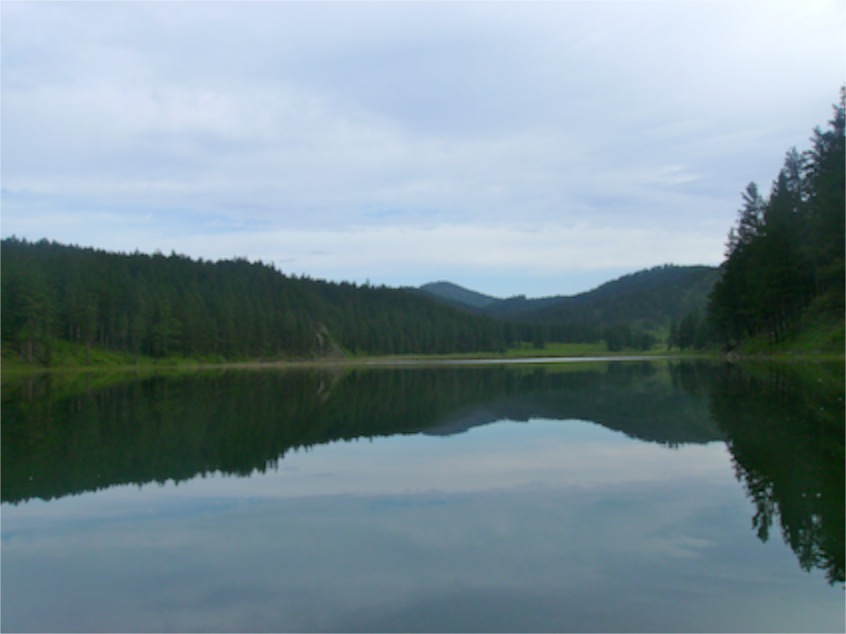 I do have the advantage of having Monday as my day off. It is still too early in the season for there to be many campers in the campground, so my companions on the lake will be mostly retired folks. I’m not retired, so instead of lingering over the newspaper with my second cup of coffee, I put my first cup of coffee into an insulated mug and head for the lake. I was on the water by 7 a.m., and I had the lake to myself.
I do have the advantage of having Monday as my day off. It is still too early in the season for there to be many campers in the campground, so my companions on the lake will be mostly retired folks. I’m not retired, so instead of lingering over the newspaper with my second cup of coffee, I put my first cup of coffee into an insulated mug and head for the lake. I was on the water by 7 a.m., and I had the lake to myself.
Even if there had been fishermen on the lake, I know how to get some alone time, so I headed for the inlet. I usually launch at the north campground. From there it is 400 paddle strokes to the inlet. I counted them yesterday for some reason. As I pulled into the inlet, I paused for a moment to warm my hands. I had used my paddling gloves when riding my bicycle last week, and they weren’t in the pocket of my paddling jacket. With frost on the ground, it was cool and my hands were chilly. My toes, however, were toasty warm inside the kayak. With a spray skirt, a kayak is a warm place to sit despite being right on the surface of all of that cold water.
 The sun was adding its warmth and as I blew on my fingers, I could listen to the twitter of the Red Wing Black Birds. They love to nest in the cattails and there were a lot of them chattering to each other. Even in the busy days of summer, I can have the inlet to myself. It is to narrow for the motorboats, and the fishing may not be too good up there anyway. I’m not sure about that.
The sun was adding its warmth and as I blew on my fingers, I could listen to the twitter of the Red Wing Black Birds. They love to nest in the cattails and there were a lot of them chattering to each other. Even in the busy days of summer, I can have the inlet to myself. It is to narrow for the motorboats, and the fishing may not be too good up there anyway. I’m not sure about that.
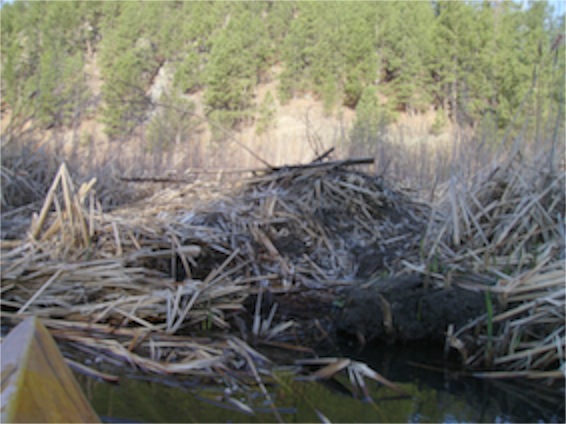 I paddled by a beaver lodge that had been abandoned. I don’t know if the conditions are enough different from last year when it was so wet that the beaver decided on a new location. Perhaps his family circumstances changed. Perhaps he got caught in the mortgage bust. It is hard telling. I didn’t see much fresh beaver evidence. It is possible that the beaver has moved along for now.
I paddled by a beaver lodge that had been abandoned. I don’t know if the conditions are enough different from last year when it was so wet that the beaver decided on a new location. Perhaps his family circumstances changed. Perhaps he got caught in the mortgage bust. It is hard telling. I didn’t see much fresh beaver evidence. It is possible that the beaver has moved along for now.
My wooden kayak is very quiet in the water. When I go slowly and am careful about how I put the paddle into the water, I am nearly silent. That gives me a good platform for listening to the sounds of nature. I can, of course, hear vehicles on the highway as they pass. They, however, probably don’t notice me. I have the entire inlet to myself and am enjoying looking around and thinking about the various critters that call it home. I kept my eyes pealed for otters, but they are hard to glimpse and I didn’t see any yesterday.
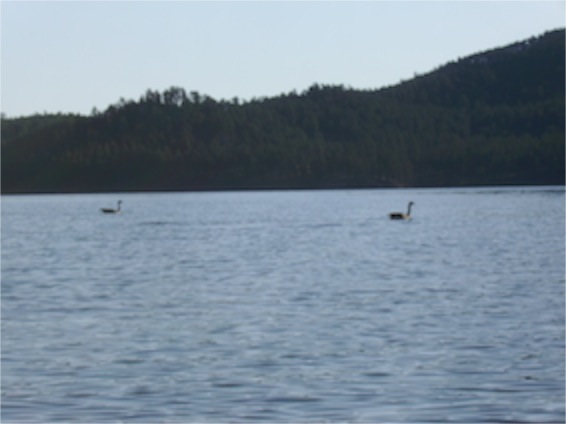 The geese are noisy, as usual. I think that these honkers are tourists. I haven’t noticed geese nesting on Sheridan Lake in the past. There are plenty of ducks and I know of at least three pairs of great blue herons, but I don’t remember ever seeing goslings paddling around the lake. Like most tourists, they probably aren’t even aware how noisy they are. A couple of geese can sound like twenty when their cries echo off of the rock faces that surround the lake. As I paddle back across the lake, I encounter a pair. One is on a rock at the edge of the lake. The other is in the lake. They seem to have quite a bit of chatter going on between them. I imagine that they are a couple arguing, though about what I can’t figure. They seem to be practiced at honking at each other, but they are less practiced at listening. The cries of the mate seem to have no impact on either of them except that they honk loudly in response.
The geese are noisy, as usual. I think that these honkers are tourists. I haven’t noticed geese nesting on Sheridan Lake in the past. There are plenty of ducks and I know of at least three pairs of great blue herons, but I don’t remember ever seeing goslings paddling around the lake. Like most tourists, they probably aren’t even aware how noisy they are. A couple of geese can sound like twenty when their cries echo off of the rock faces that surround the lake. As I paddle back across the lake, I encounter a pair. One is on a rock at the edge of the lake. The other is in the lake. They seem to have quite a bit of chatter going on between them. I imagine that they are a couple arguing, though about what I can’t figure. They seem to be practiced at honking at each other, but they are less practiced at listening. The cries of the mate seem to have no impact on either of them except that they honk loudly in response.
I swing by a place where I am pretty sure I can find a great blue heron and I am not disappointed. The birds look awkward standing in the water, but they are graceful flyers and it always amazes me how quickly they can take to the air. Ducks are like that, too. They don’t’ seem to need a runway at all. They just launch from wherever they are. The ducks often fly when they think that I have come too close. These days, however, they don’t fly very far, just enough to keep their distance.
I watched the trout rising to capture the bugs – a sign that things are warming a bit so that the bugs are out and about, flying close to the surface of the water.
By the time I got back to the launch point, there was a fishing boat being backed down the boat ramp. It was a beautiful new Lund with a Mercury outboard, on a trailer behind a new Silverado pickup. There are quite a few things required to launch such a boat and I had my kayak secured to the roof of my car before he had his pickup parked.
I was sipping my second cup of coffee from the thermos by the time he got his boat started. A second boat was on its way down the ramp.
 I have no envy for those with the fancy fishing boats. I’m quite happy with my little kayak. But neither do I have any problems sharing the lake with them. They weren’t in my way and I’m sure I wasn’t in theirs.
I have no envy for those with the fancy fishing boats. I’m quite happy with my little kayak. But neither do I have any problems sharing the lake with them. They weren’t in my way and I’m sure I wasn’t in theirs.
Despite what some other paddlers think, there’s plenty of room on the lake for us all, especially early on a chilly Monday morning.
People who have been around the area sometimes make a face or turn their noses up at Sheridan Lake. I’ve heard about how it is too crowded, too noisy, too filled with powerboats. I guess that is true part of the time, but I never have any trouble when I want to paddle on the lake. Yesterday morning was a good example.

Even if there had been fishermen on the lake, I know how to get some alone time, so I headed for the inlet. I usually launch at the north campground. From there it is 400 paddle strokes to the inlet. I counted them yesterday for some reason. As I pulled into the inlet, I paused for a moment to warm my hands. I had used my paddling gloves when riding my bicycle last week, and they weren’t in the pocket of my paddling jacket. With frost on the ground, it was cool and my hands were chilly. My toes, however, were toasty warm inside the kayak. With a spray skirt, a kayak is a warm place to sit despite being right on the surface of all of that cold water.


My wooden kayak is very quiet in the water. When I go slowly and am careful about how I put the paddle into the water, I am nearly silent. That gives me a good platform for listening to the sounds of nature. I can, of course, hear vehicles on the highway as they pass. They, however, probably don’t notice me. I have the entire inlet to myself and am enjoying looking around and thinking about the various critters that call it home. I kept my eyes pealed for otters, but they are hard to glimpse and I didn’t see any yesterday.

I swing by a place where I am pretty sure I can find a great blue heron and I am not disappointed. The birds look awkward standing in the water, but they are graceful flyers and it always amazes me how quickly they can take to the air. Ducks are like that, too. They don’t’ seem to need a runway at all. They just launch from wherever they are. The ducks often fly when they think that I have come too close. These days, however, they don’t fly very far, just enough to keep their distance.
I watched the trout rising to capture the bugs – a sign that things are warming a bit so that the bugs are out and about, flying close to the surface of the water.
By the time I got back to the launch point, there was a fishing boat being backed down the boat ramp. It was a beautiful new Lund with a Mercury outboard, on a trailer behind a new Silverado pickup. There are quite a few things required to launch such a boat and I had my kayak secured to the roof of my car before he had his pickup parked.
I was sipping my second cup of coffee from the thermos by the time he got his boat started. A second boat was on its way down the ramp.

Despite what some other paddlers think, there’s plenty of room on the lake for us all, especially early on a chilly Monday morning.